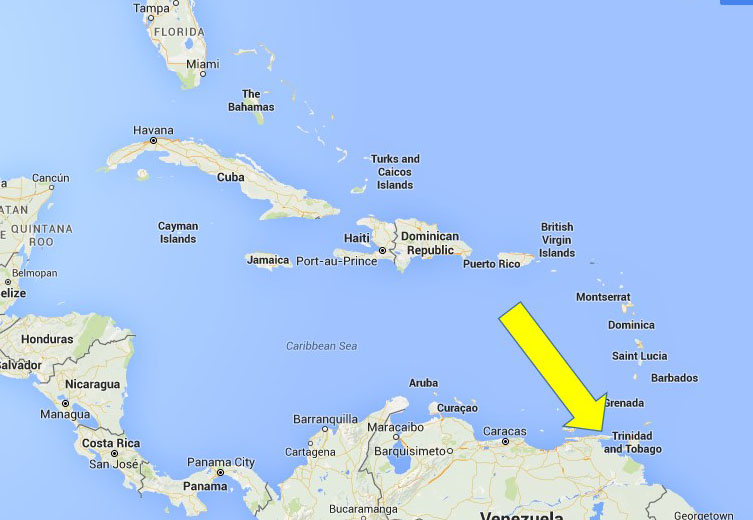
Trinidad Trip
Saturday April 23 to Saturday April 30,2016
Trinidad Trip Report
With the help of Caligo Ventures in Arizona; nine intrepid Hudson River Audubon members traveled to Trinidad for a week of birding and eco touring. Kelli and I were joined by; Mark, Fran, Ruth, Saul and Judi, and Eleanor and Gerry. Trinidad lies just 7 miles off the coast of Venezuela. It is usually referred to as the southernmost island in the Caribbean, but actually lies on the continental shelf of South America. Its rich biodiversity was made famous by the Asa Wright property and its easy access to the wildlife. It hosted many scientists in the 50’s and 60’s. In the 1970s the start of what we call eco-tourism was born.
Saturday,
April 23
Day of departure
We were all flying American out of Newark, with a stop in Miami. Our first flight was at 6 AM so that meant getting up at 2AM, to be picked up at 3 AM by our friend Mark for the drive to the airport. We parked in the long-term lot and waited for the bus to the terminal. At the terminal, panic ensued, as I could not locate my computer bag, which also held my camera and binoculars. I had left it on the bench at the parking lot bus stop. I stayed on the bus hoping against hope that it would still be there. Halfway back I got a cell call. The caller said he found my bag. I told him I was on my way, but he had to catch the bus to his flight. He left it there for me. Slightly calmer, knowing that it was still there, the rest of the ride seemed to take forever. When I finally reached the bus stop; IT WAS STILL THERE – WHEW!. A couple of minutes later while I was waiting for the next bus, security came along to check on the unattended bag. I told them it was mine and had rushed back to get it.
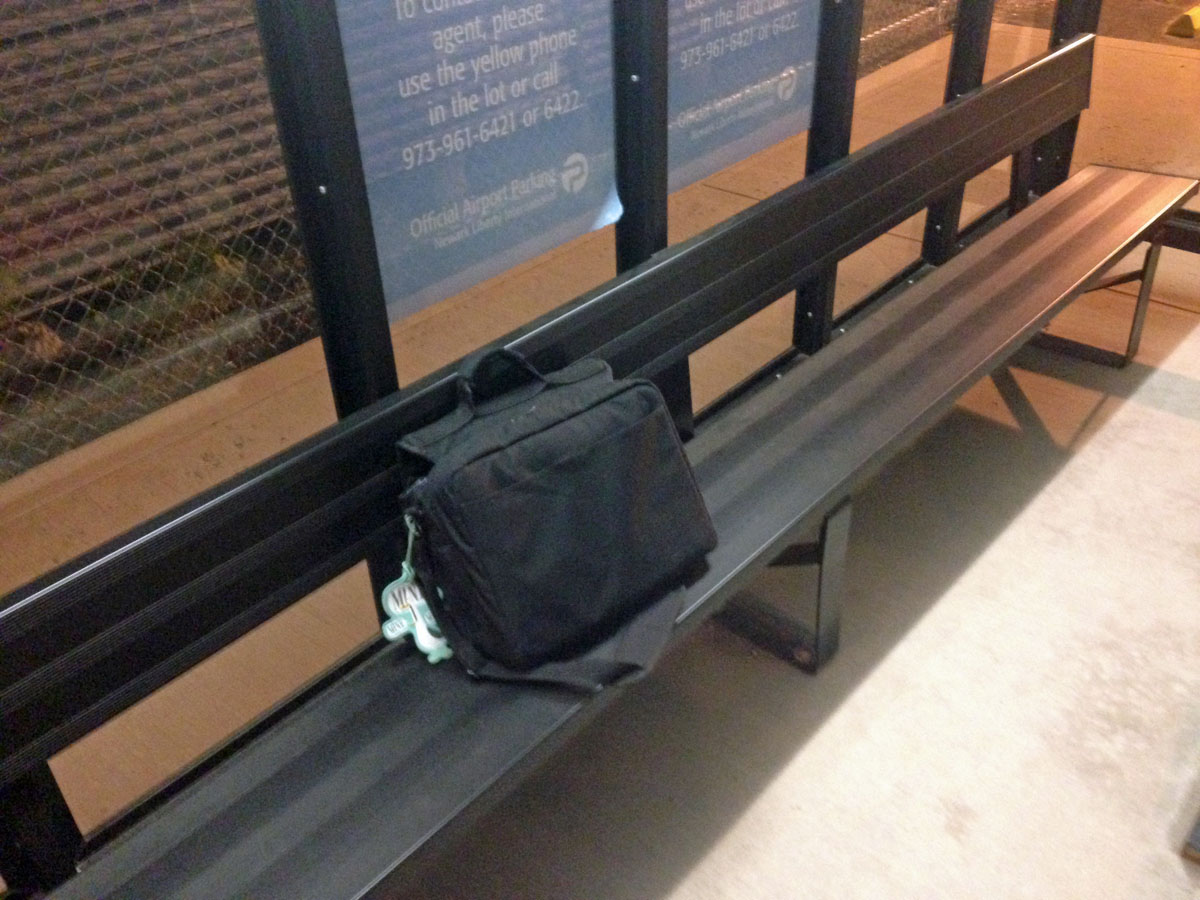
With the major snafu avoided, we were now behind schedule. Mark and Kelli waited for me at the terminal. Check-in was slightly chaotic and security look long. Kelli and I were pre-screened so our wait was minimal, but Mark had a long wait. We waited for him a bit but reluctantly left to get to the gate to meet the others in our group.
Boarding started and we hoped Mark would make it. Fortunately we saw him come down the aisle as we were organizing our seats for the flight.
The flight down was surprisingly comfortable with decent leg room and individual TV screens. I watched a free copy of “The Fifth Element” to pass the time. In Miami we had to disembark in Terminal D and hoof it all the way to Terminal E with only a 55 minute layover, but we made it in time. The second flight from Miami to the Port of Spain was equally as comfortable. Overhead screens showed the newest Star Wars movie and I happily watched it for the second time. Kelli and I paid for sandwiches on the plane for “lunch”.
After customs we all made our way out of the airport and we found our driver and guide for the next few days; Dave Ramlal and David (Trinidad Bird Adventures). The van ride was bumpy and disconcerting since they drive on the “wrong” side of the road. Streets were narrow and the mountain road up to the Asa Wright Nature Center was even narrower with cliffs on hairpin turns.
At Asa Wright we were assigned cabins just up from the main building. The rooms were spacious and nice with ceiling fans but no AC. The nights were just cool enough for comfortable sleeping. We all assembled on the verandah with Dave to go over the agenda for the next couple of days. Then the first of the late afternoon rum punches were served.

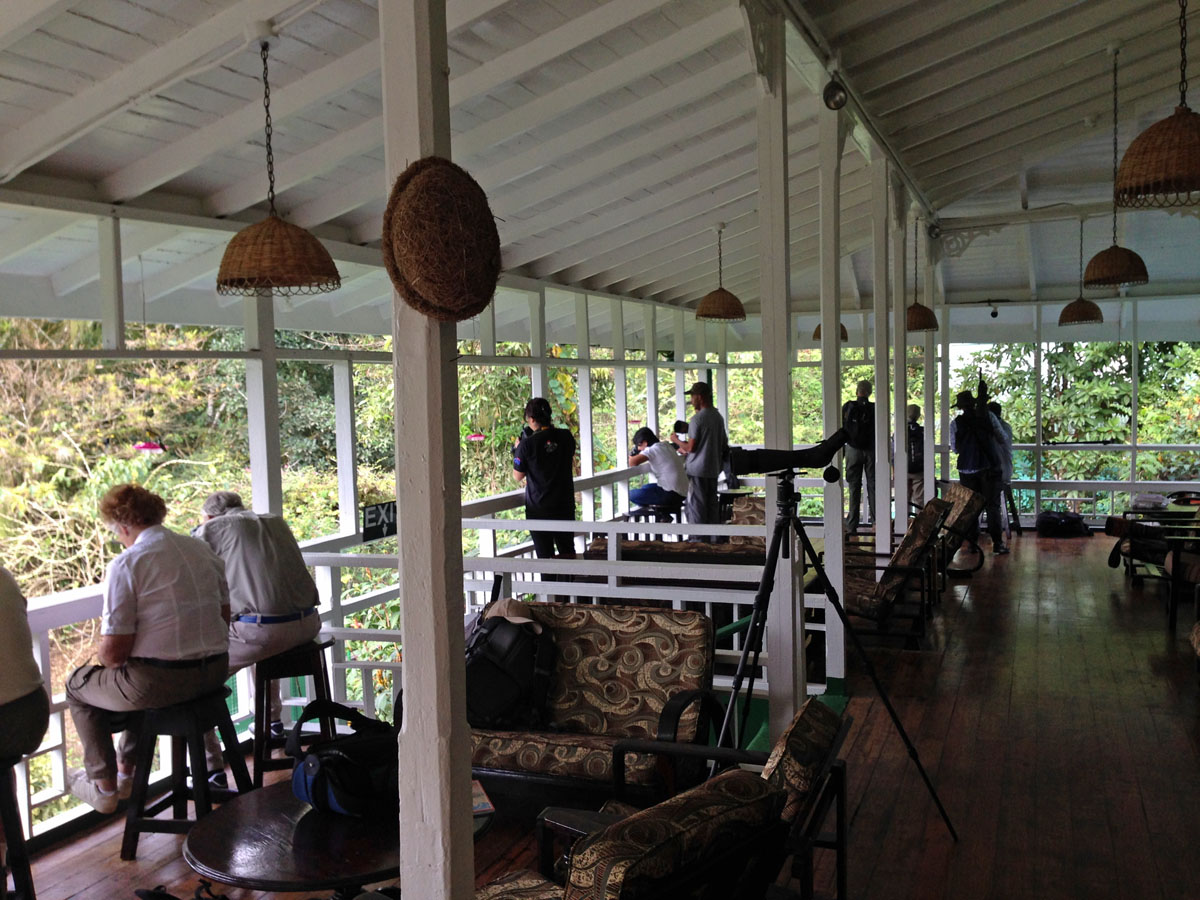
We were then free to enjoy the birds coming to the feeding stations. Asa Wright had guides to help us with our ids. The first bird to be noticed was the common but boldly marked White-necked Jacobin. There were a number of them. The males have stunning indigo blue heads and blue-green backs with a brilliant white nape and belly.
White-necked Jacobin
Bananaquits were even more numerous, with dozens sometimes vying for the same feeder.
Bananaquit
Other birds more brilliant than the next were found; Purple Honeycreeper, followed by Green Honeycreeper and more.
|
|
|
|
Purple Honeycreeper |
Green Honeycreeper |
Tanager species included White-lined, Silver-beaked, Blue-gray and Palm.
 |
|
| White-lined Tanager | Silver-beaked Tanager |
| |
|
| Blue-gray Tanager | Palm Tanager |
A large comical looking blackbird came in. It was a Crested Oropendola. Its bright yellow tail, huge yellowish bill and blue iris made it a favorite of many.
Crested Oropendola
The guides also found a few birds in the far treetops and put high powered spotting scopes on them for everyone to see. We added Scaled Pigeon, Orange-winged parrot and Violaceous Euphonia. We would get closer looks at a couple of these in the following days.
Birds were not the only thing visiting the feeders; Red-rumped Agouti, a large South American rodent with Kardashian like butts roamed below the feeders picking up dropped food.
Red-rumped Agouti
The dinner bell rang and we all filed into the large dining room. Our fist meal was delicious and consisted of a ginger carrot soup, roast beef and a pumpkin banana casserole.
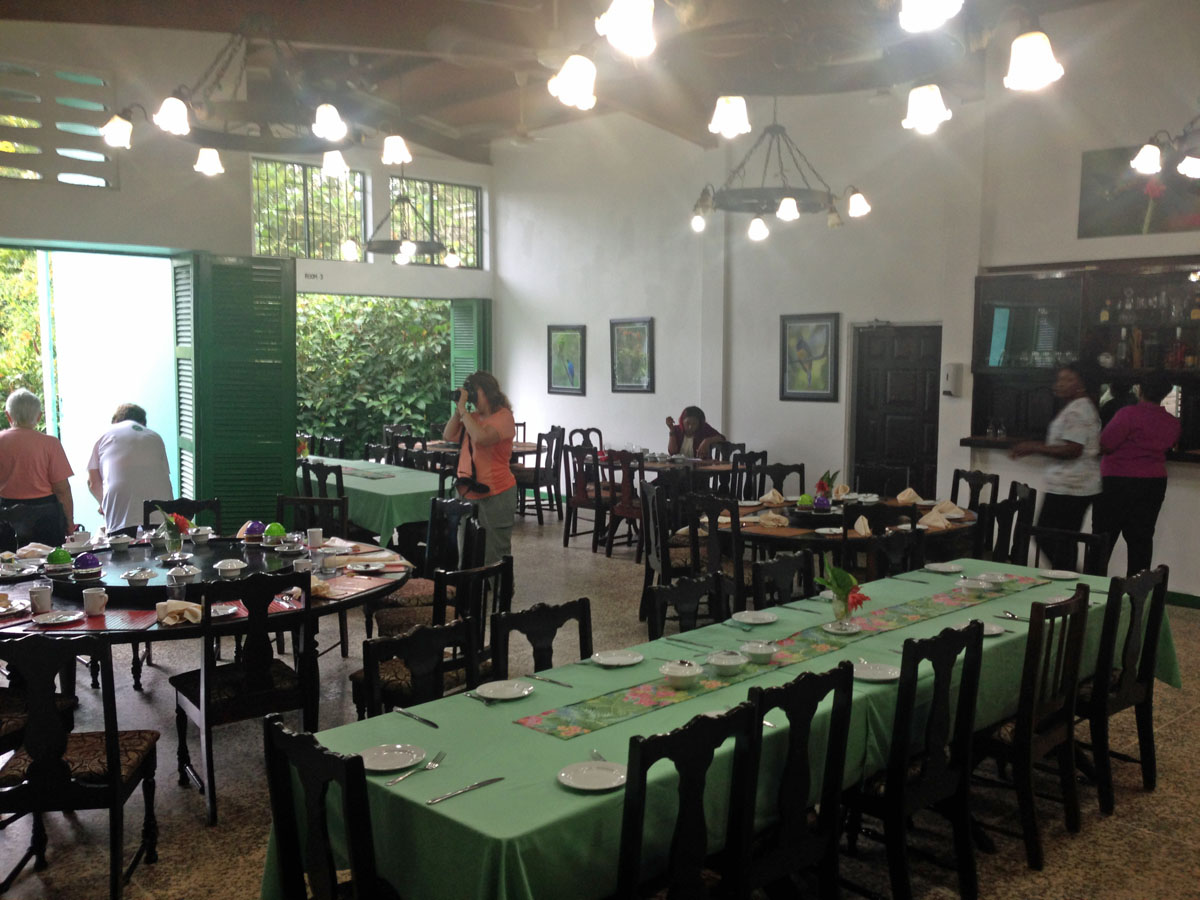
The sun was setting as we made our way back out to the verandah. Bats were now replacing the hummingbirds at the feeders; Long-tongued Bats. A couple of large nighthawks were also seen in the diminishing light – Short-tailed Nighthawk. After viewing the bats and nighthawks- we retired to our rooms for a great night’s sleep.
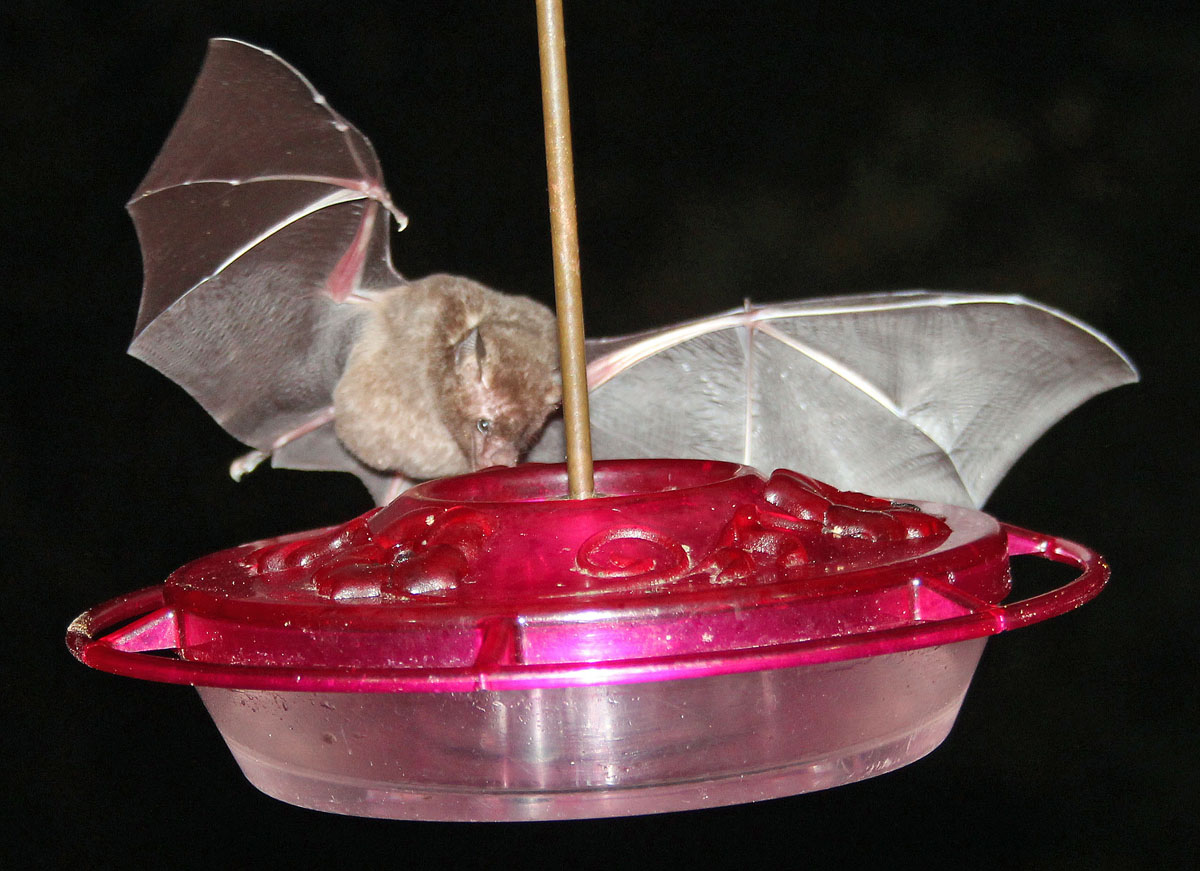
Long-tongued Bat
Sunday, April 24, 2016
We woke up early to enjoy the birds on the verandah before the 7:30 am breakfast bell. Outside our cabin a Tropical Kingbird was perched on an antenna. Great Kiskadees were calling raucously. On our walk down to the main building a Common Black Hawk soared overhead. After grabbing a cup of coffee we joined others on the verandah. We met a group of British birders as well as a couple from Colorado; Tiffany Miller Russell and her husband Steve. She is here on a scholarship from the Society of Animal Artists.

Great Kiskadee
We enjoyed better looks at some of the hummingbird species seen briefly yesterday. They included Black-throated Mango, Ruby-topaz Hummingbird, the small fearless White-chested Emerald and Long-billed Starthroat.
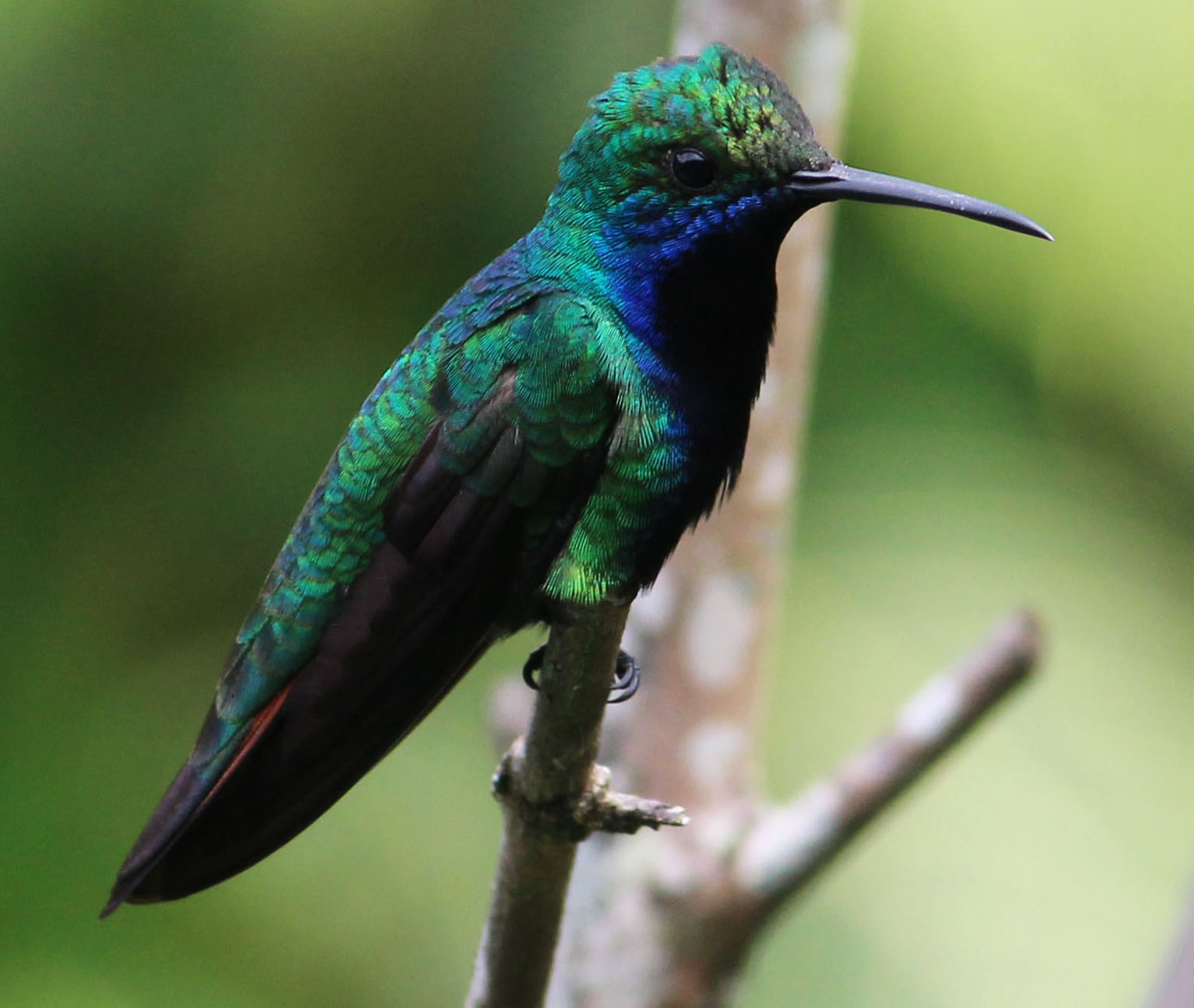 |
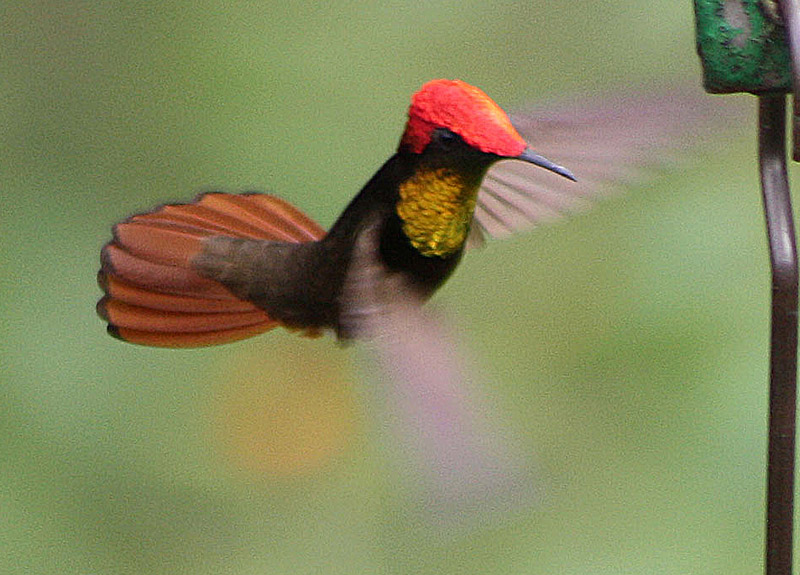
|
 |
| Black-throated Mango | Ruby-topaz Hummingbird | Long-billed Starthroat |
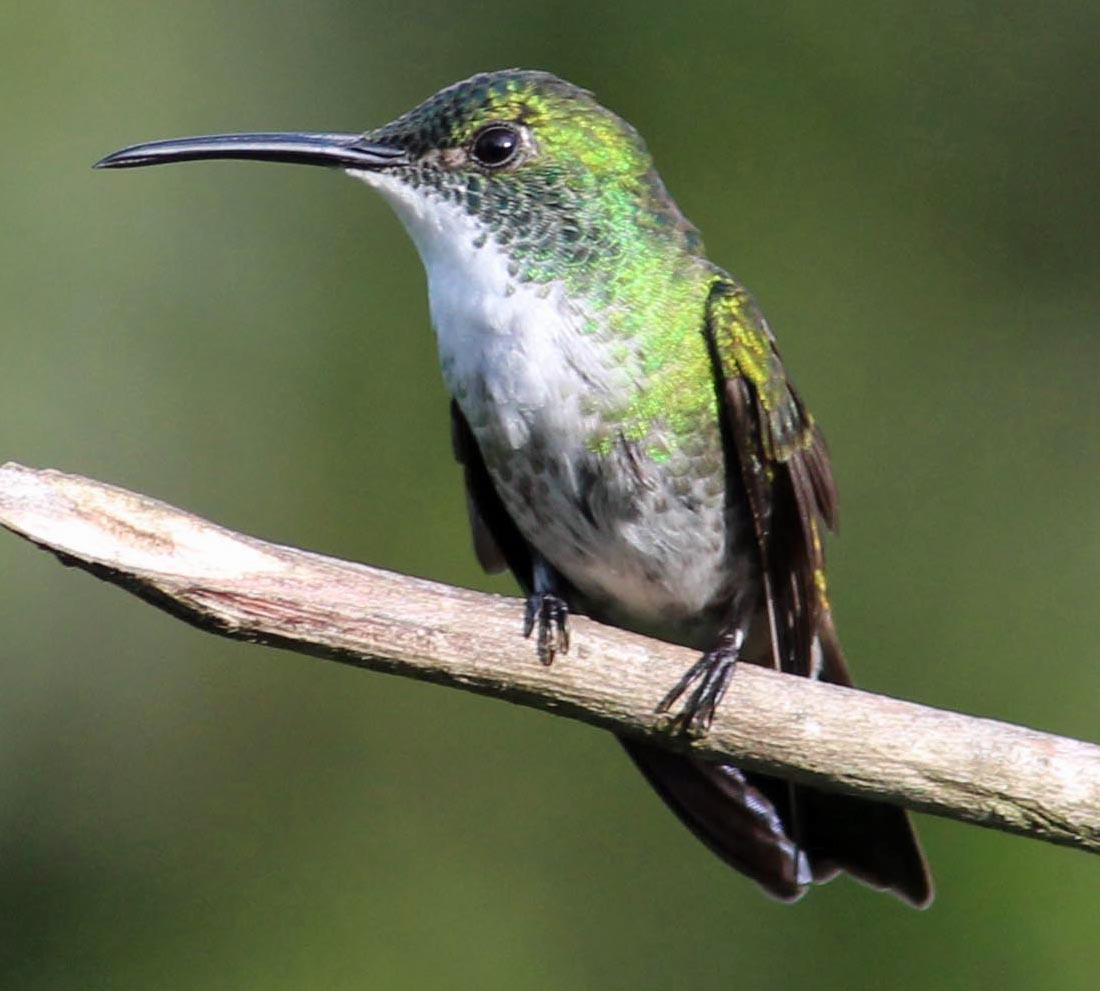 |
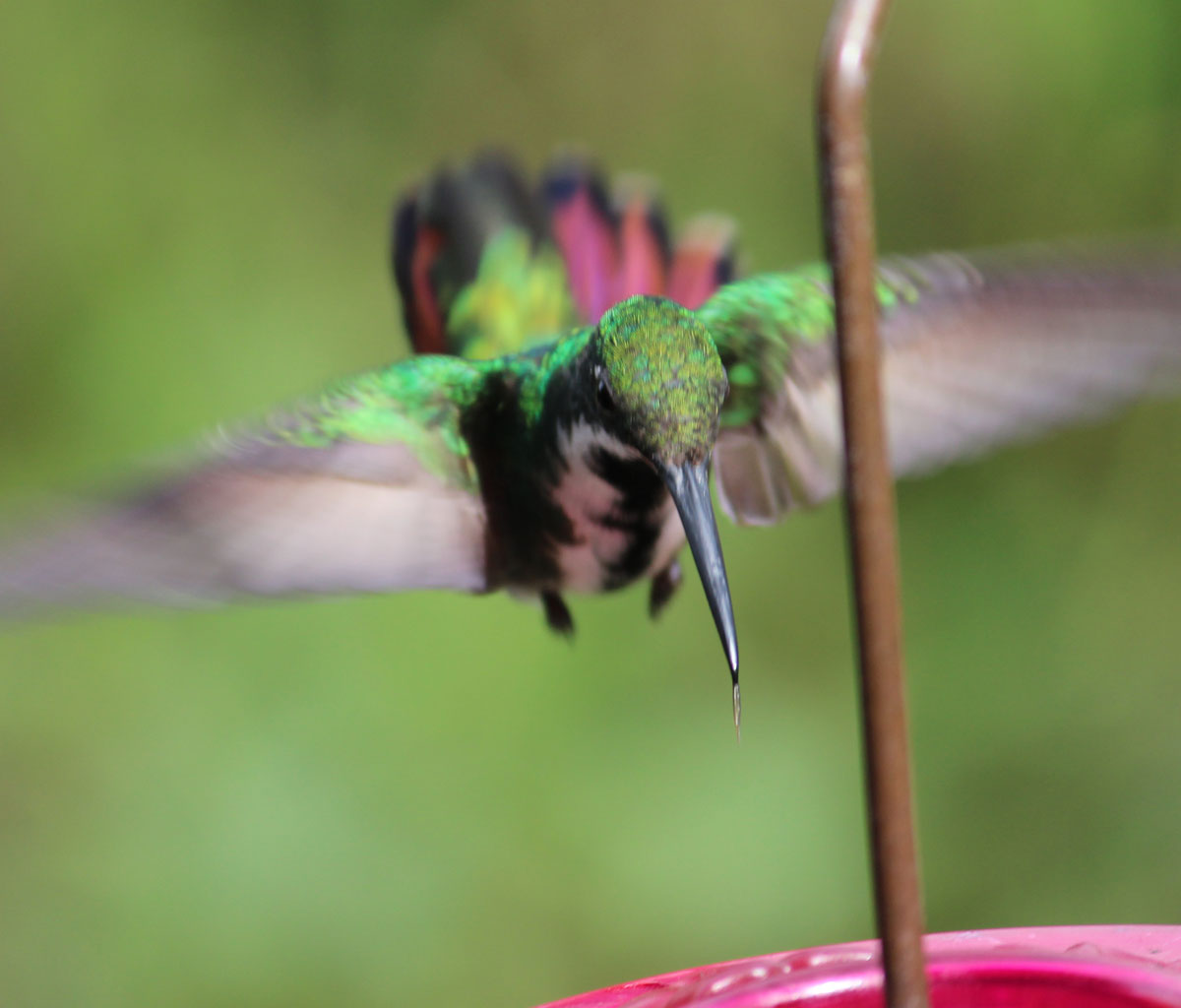 |
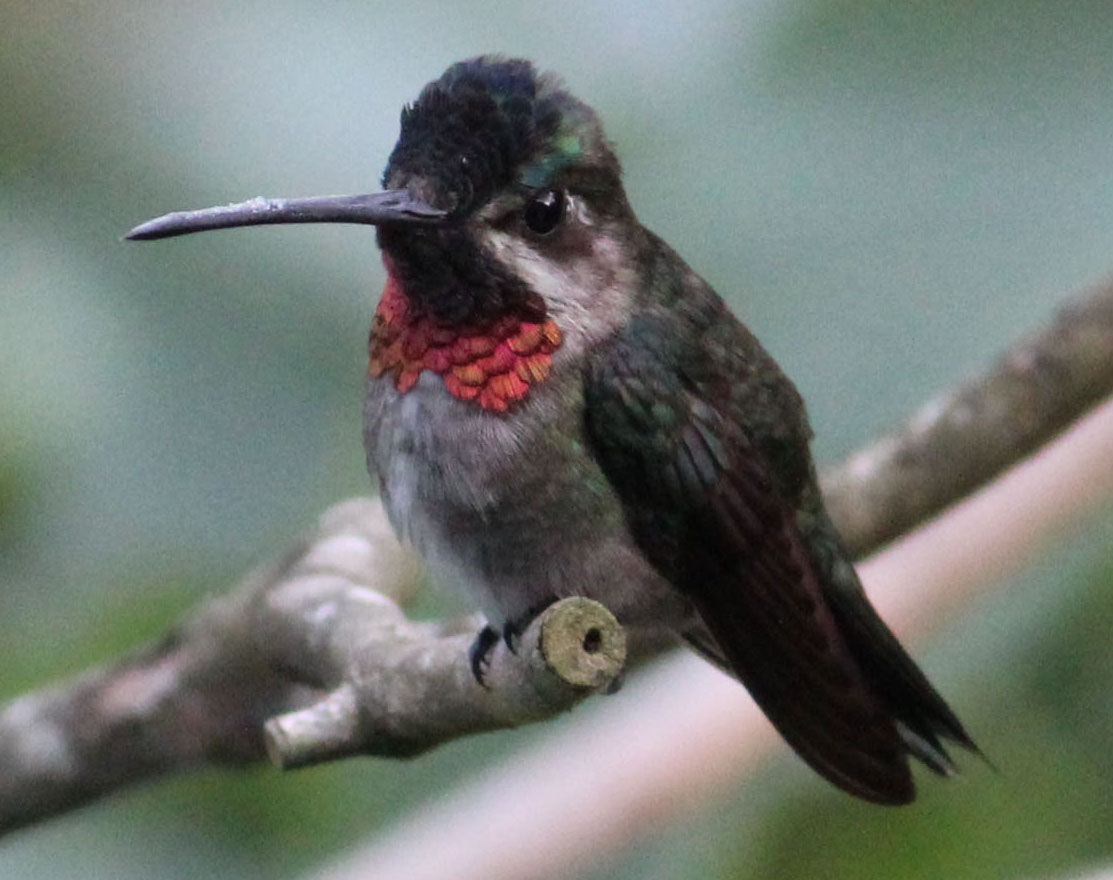 |
| White-chested Emerald | Black-throated Mango, female | Long-billed Starthroat |
New hummingbirds included the unusual Tufted Coquette, Blue-chinned Sapphire and Copper-rumped Hummingbird.
 |
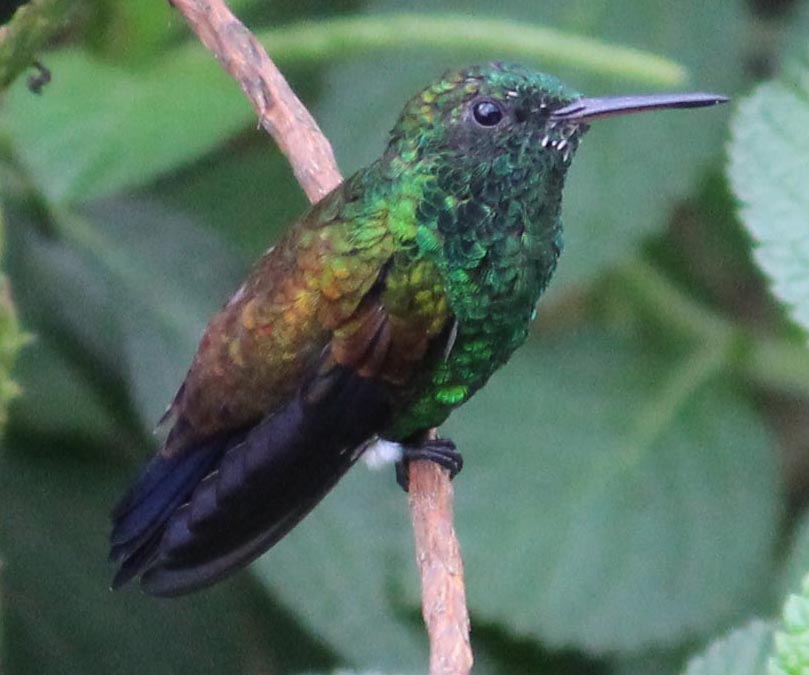 |
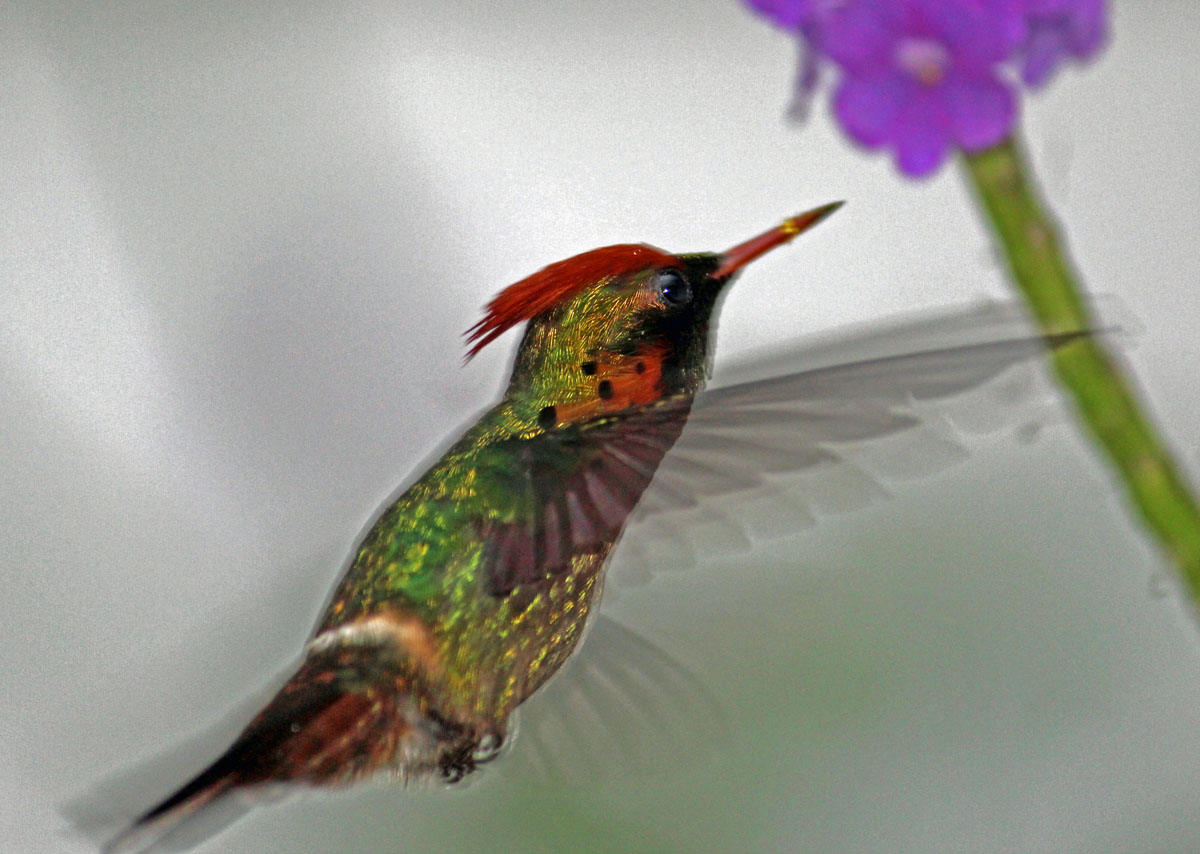 |
| Blue-chinned Sapphire | Copper-rumped Hummingbird | Tufted Coquette |
The guides pointed out a distant Channel-billed Toucan, Blue Dancis, Turquoise Tanager and Swallow Tanager.
The platform feeders gave us great looks at both Cocoa and Spectacled Thrushes as well as Yellow Oriole.
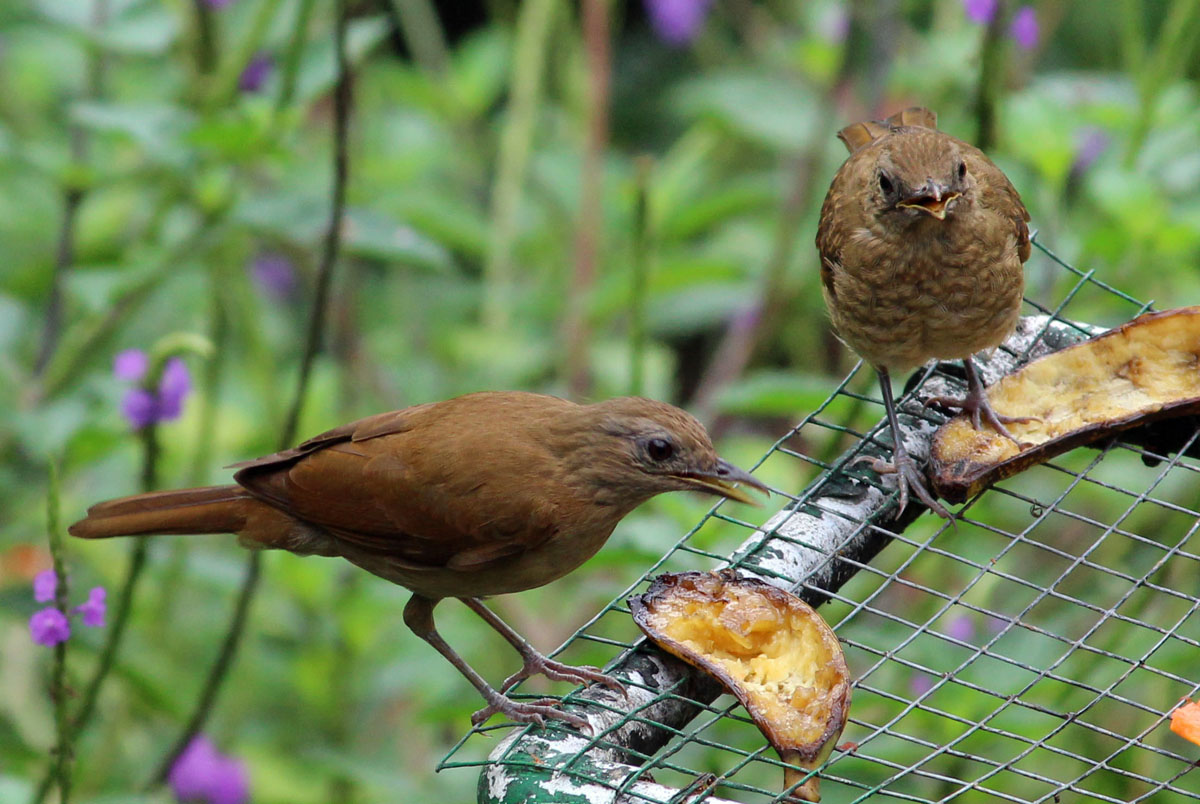 |
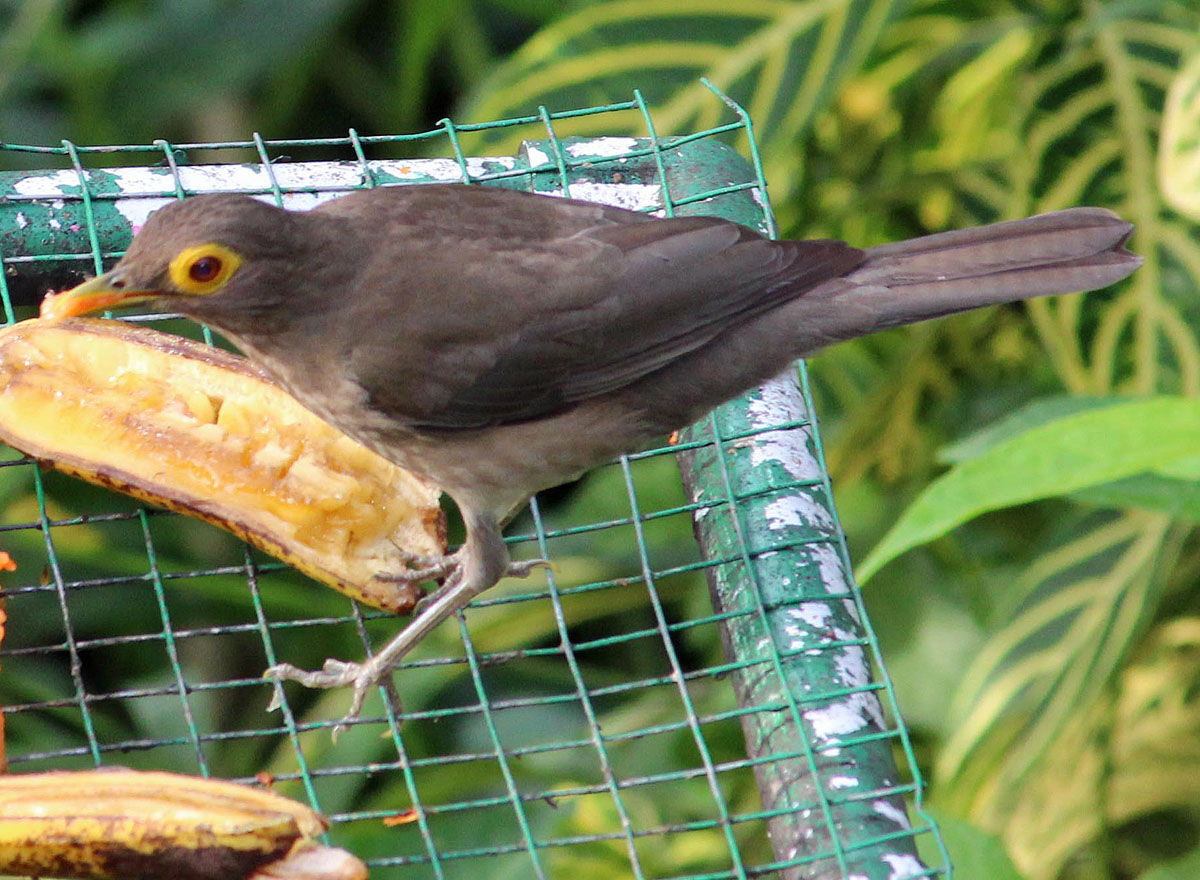 |
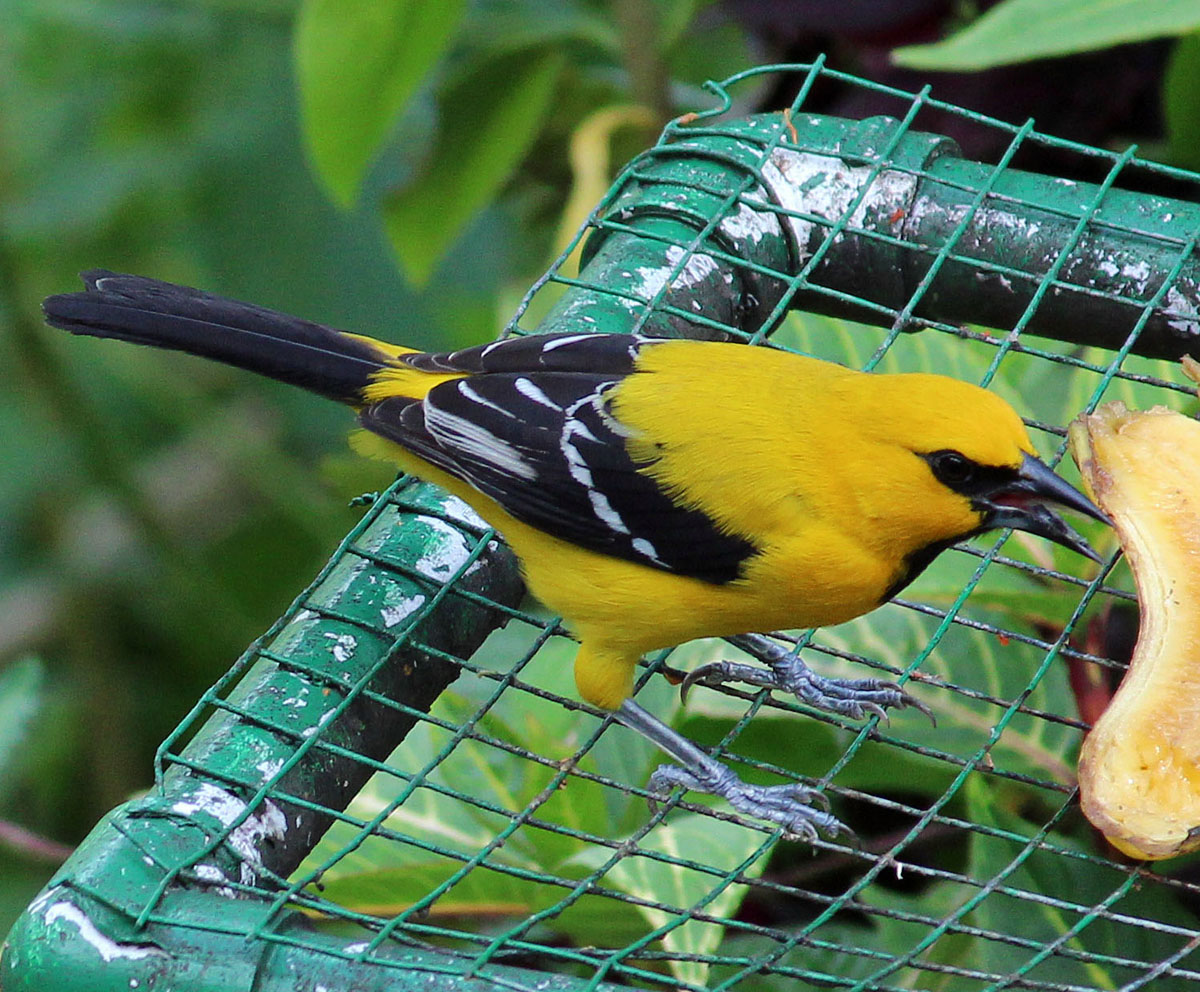 |
| Cocoa Thrush with fledgling | Spectacled Thrush | Yellow Oriole |
After breakfast we met on the verandah to meet our guide Randal for the Asa Wright Grounds Orientation Walk. We made our way down the valley. A White Hawk and a Gray-lined Hawk made brief appearances overhead. Lobster Claw and Sexy Pink heliconia were pointed out.

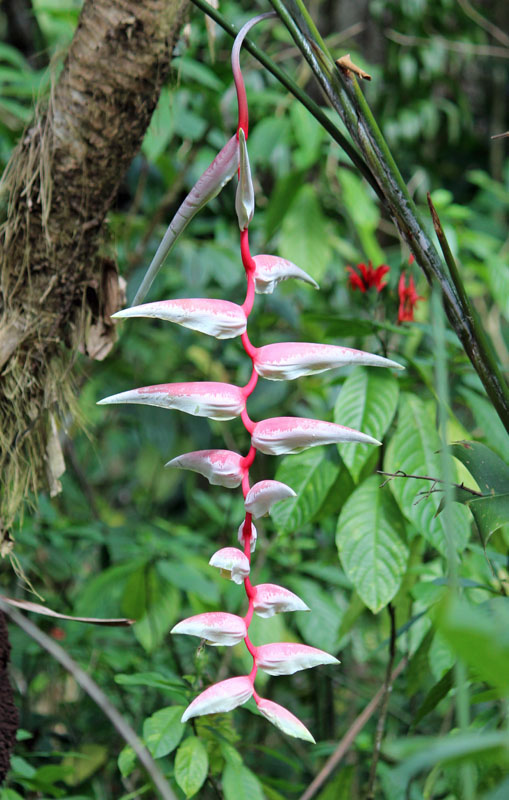
A pair of White-bearded Manakins flitted through the underbrush. A huge tree covered with a large Strangler Fig attracted many birds including a Golden-headed Manakin. Lower down we had great looks at more White-bearded Manakins.
We could hear a bellbird in the distance; so we made our way over and was rewarded with a Bearded Bellbird overhead.
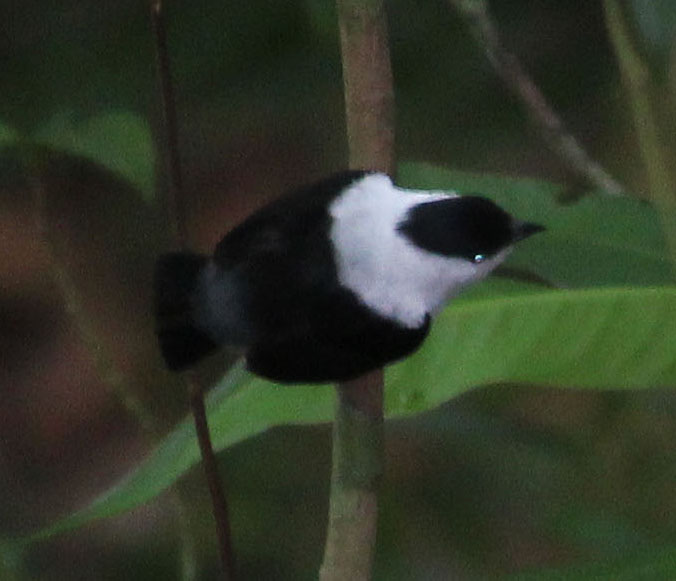 |
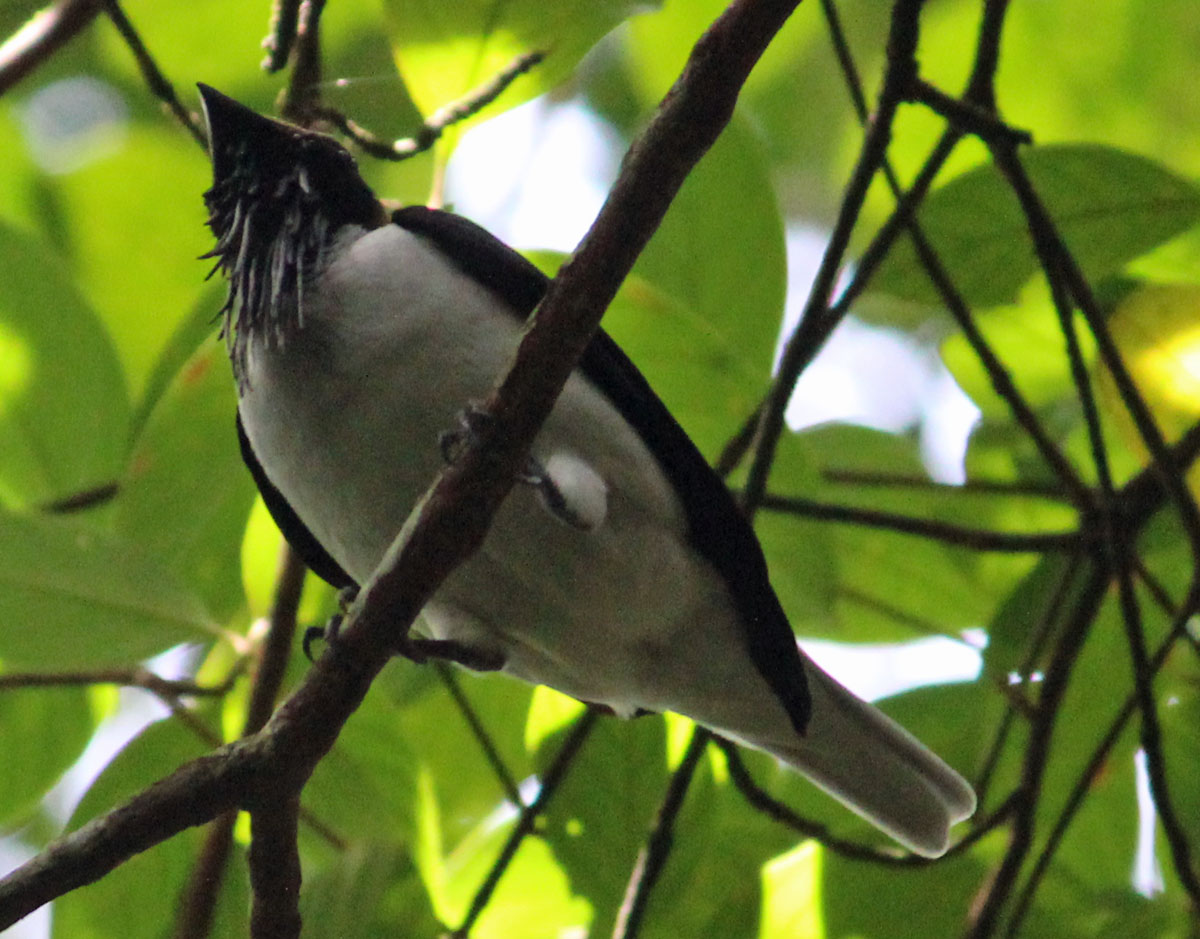 |
| White-bearded Manakin | Bearded Bellbird |
Other flowers along our walk included Torch Ginger, the whimsical Hot Lips Plant, and a smaller heliconia where ants feed from and defend the plant.
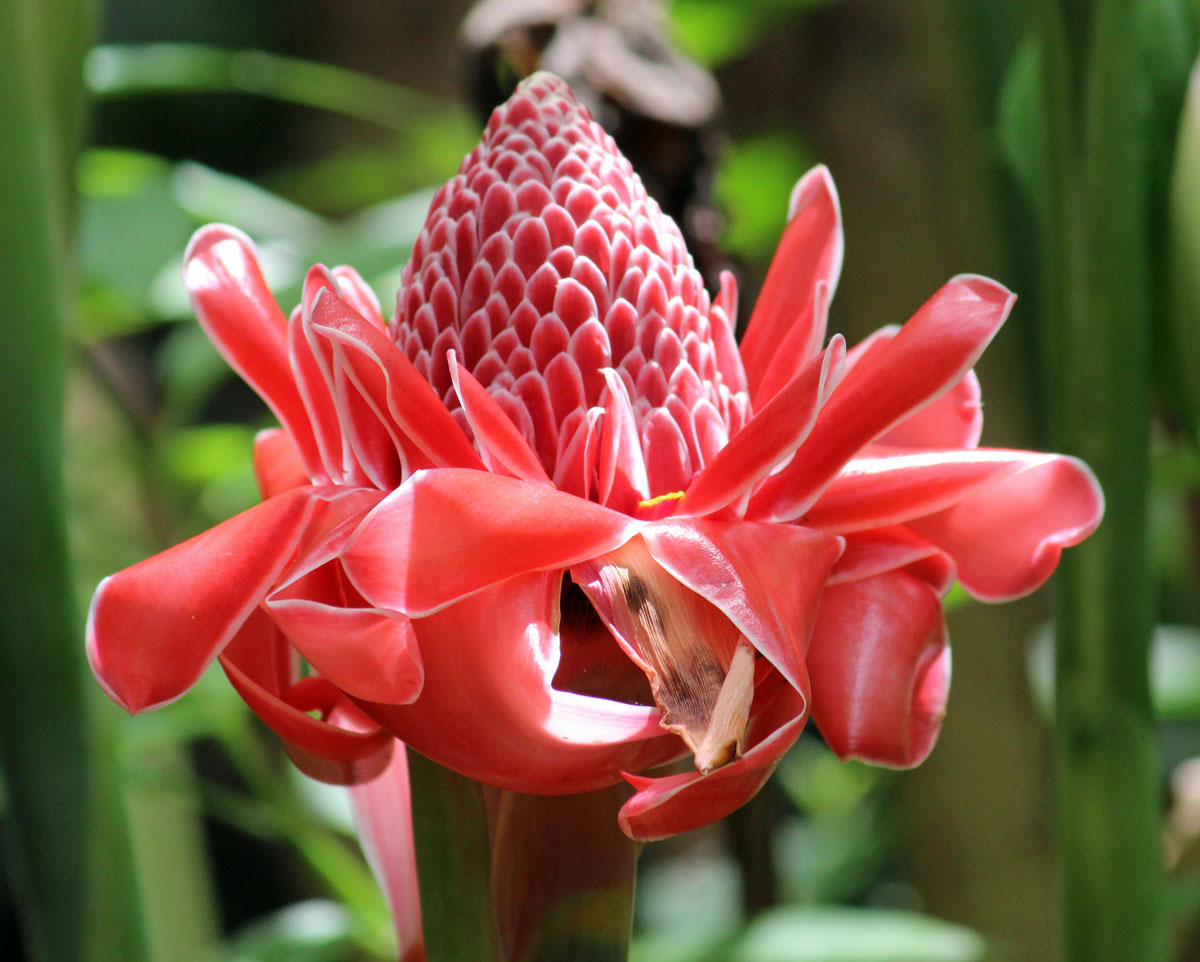 |
 |
|
| Torch Ginger | Hot Lips Plant | Ants on Heliconia |
Trinidad Stream Frogs were found in a small brook. Some people had glimpses of a Forest Elaenia (a bird).
Mark, Fran, and Kelli decided to take a steep trail down to a small waterfall and were rewarded with views of a Plain-brown Woodcreeper. Those that continued up to the nature center had silhouetted views of a Trinidad Motmot deep within a bamboo grove.
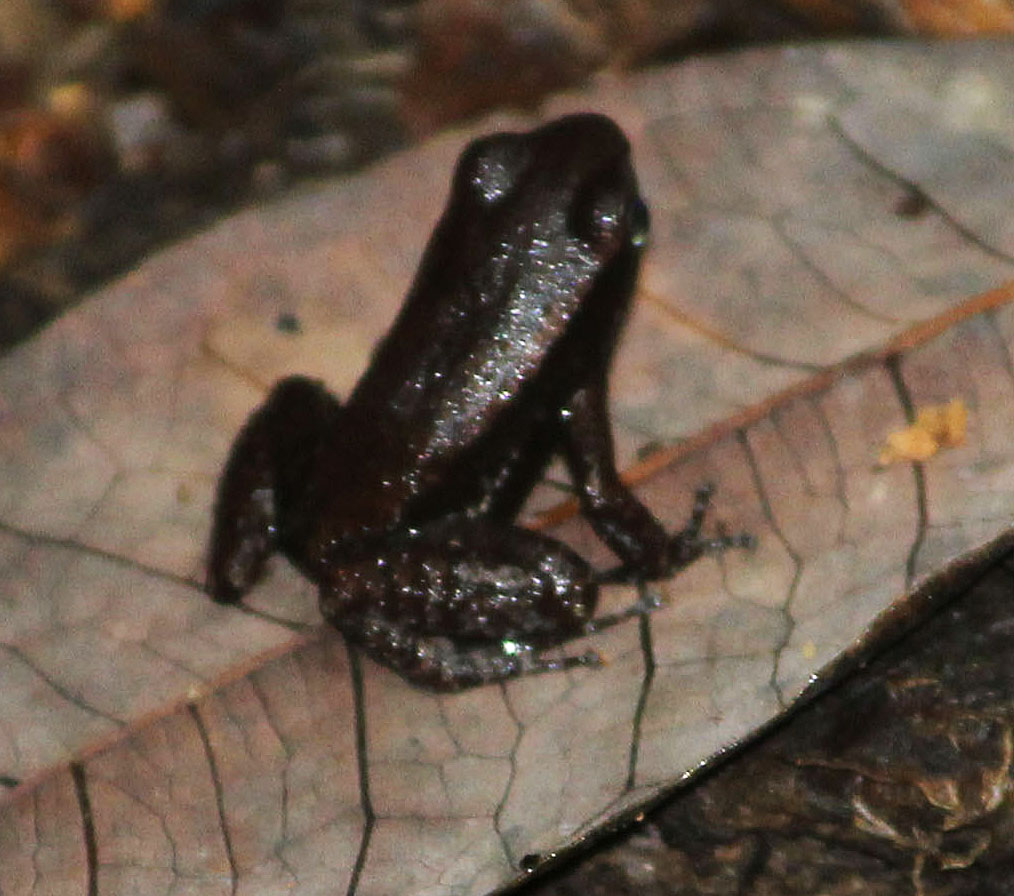 |
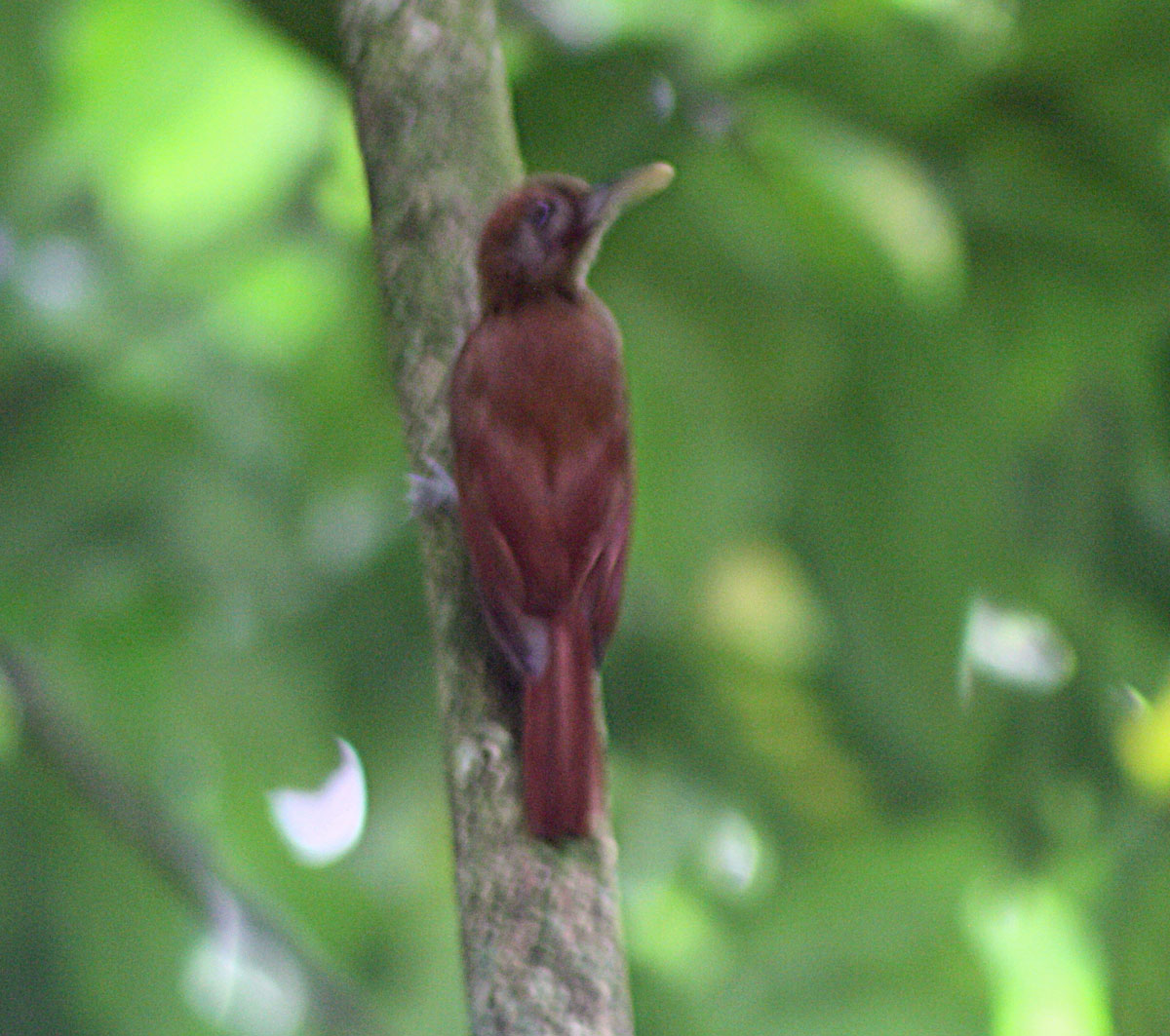 |
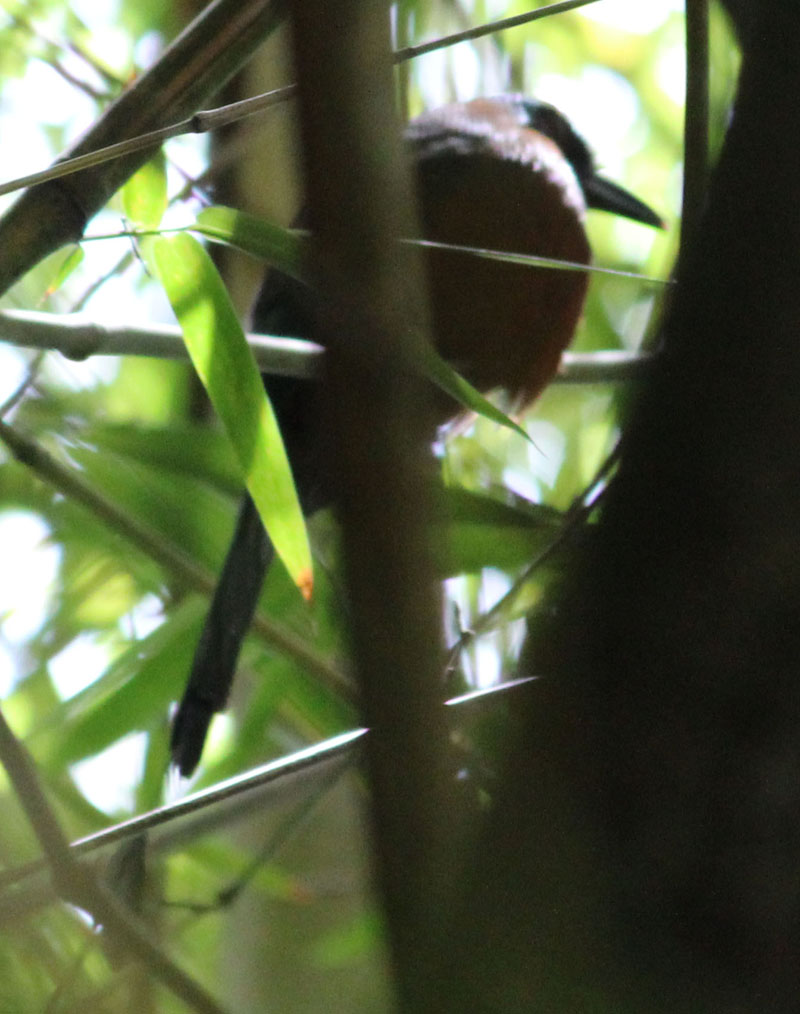 |
| Trinidad Stream Frog | Plain-brown Woodcreeper | Trinidad Motmot |
Lunch back at the main house included Tandoori chicken, creamed veggies, and a mix of sweet potatoes, yarrow root and carrots.
Back at the verandah a couple of large Golden Tegu Lizards patrolled the grounds below. A Green Iguana moved through the trees just outside the dinning room.
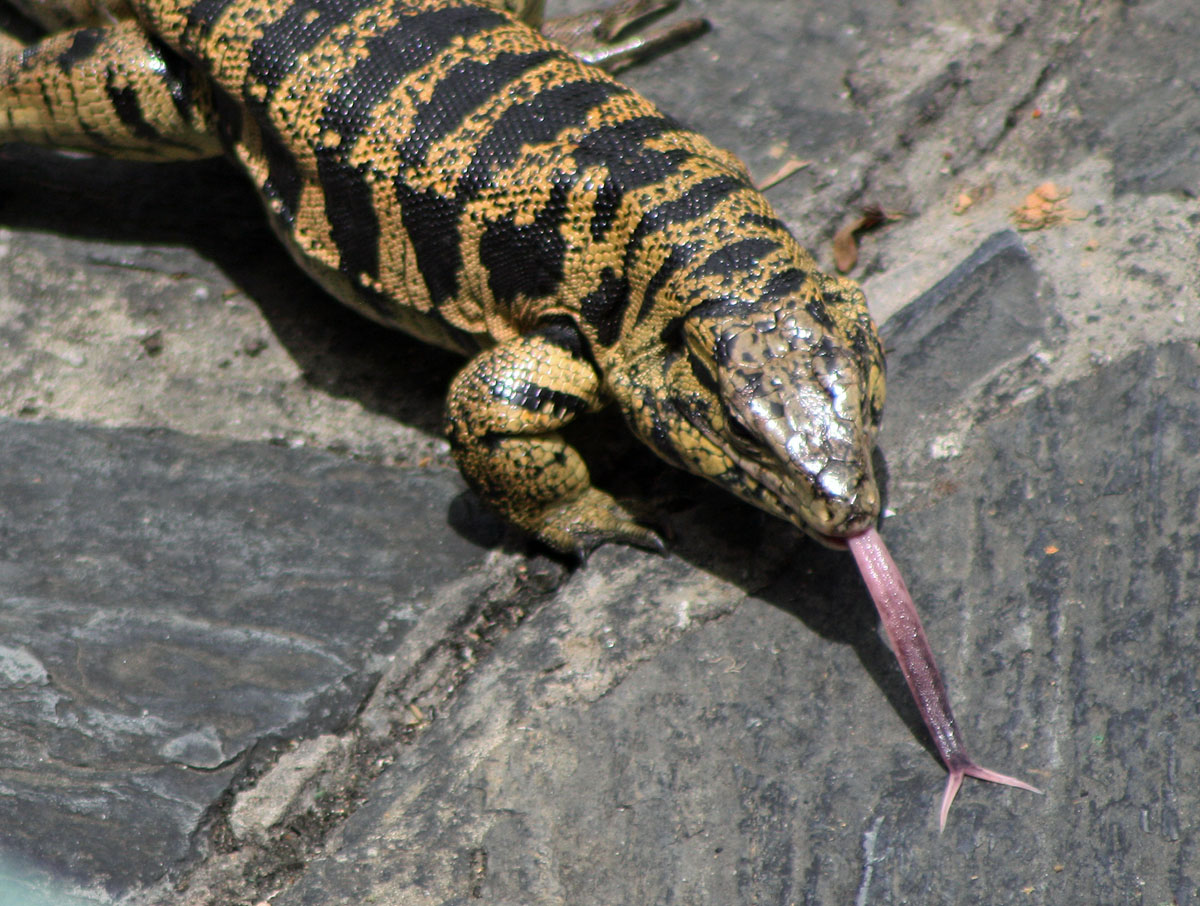 |
 |
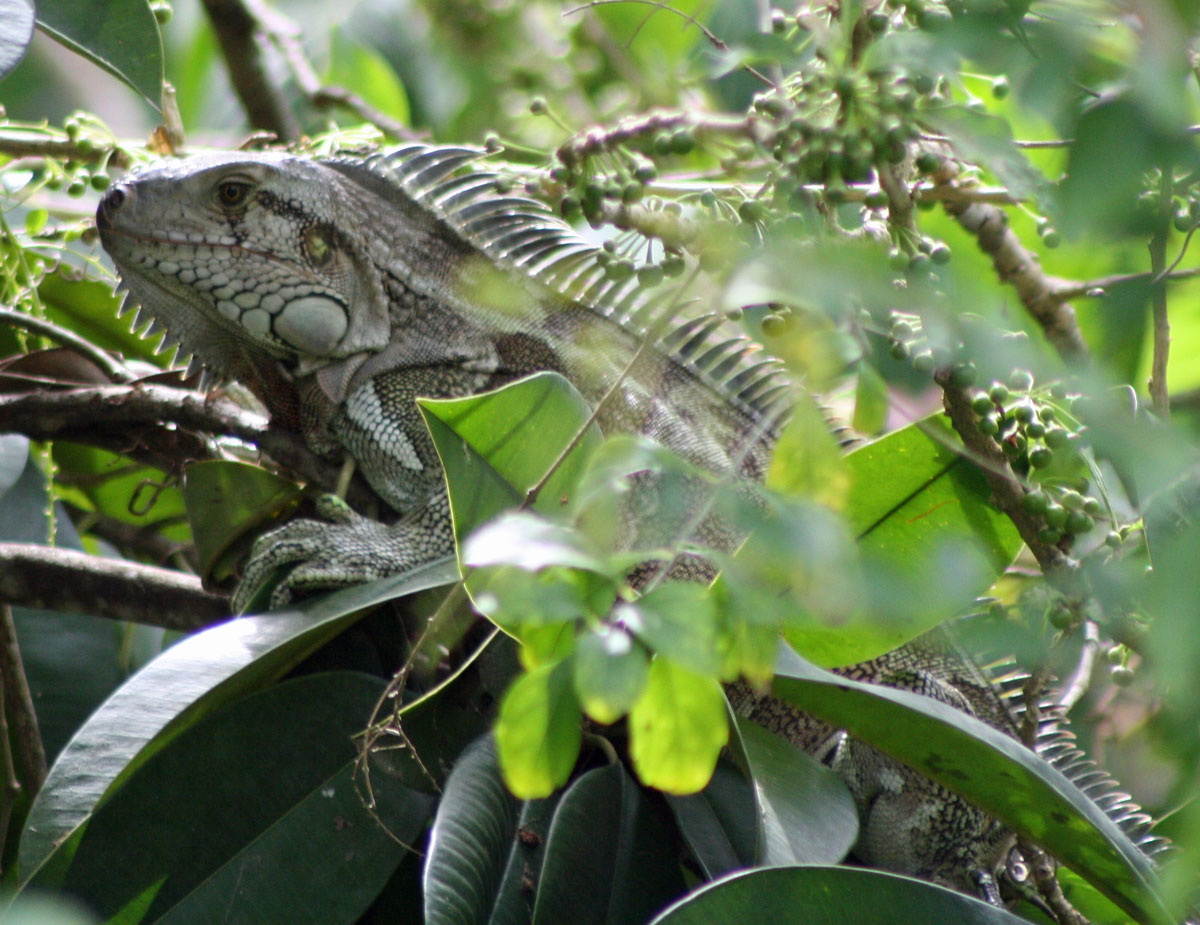 |
| Golden Tegu Lizard | Golden Tegu Lizard | Green Iguana |
Our afternoon excursion left at 3 PM and included some night birding. We made our way to the Aripo Livestock (Agriculture Research) Station. The trees along the entrance path held some Green-rumped Parrolets and the field had a Red-breasted Meadowlark. Gray-breasted Martins perched on some wires and a single Orange-winged Parrot posed in a nearby tree.
The interior fields held Wattled Jacanas, Smooth-billed Anis, Southern Lapwings and a Striated Heron. Best daytime bird was a Pearl Kite.
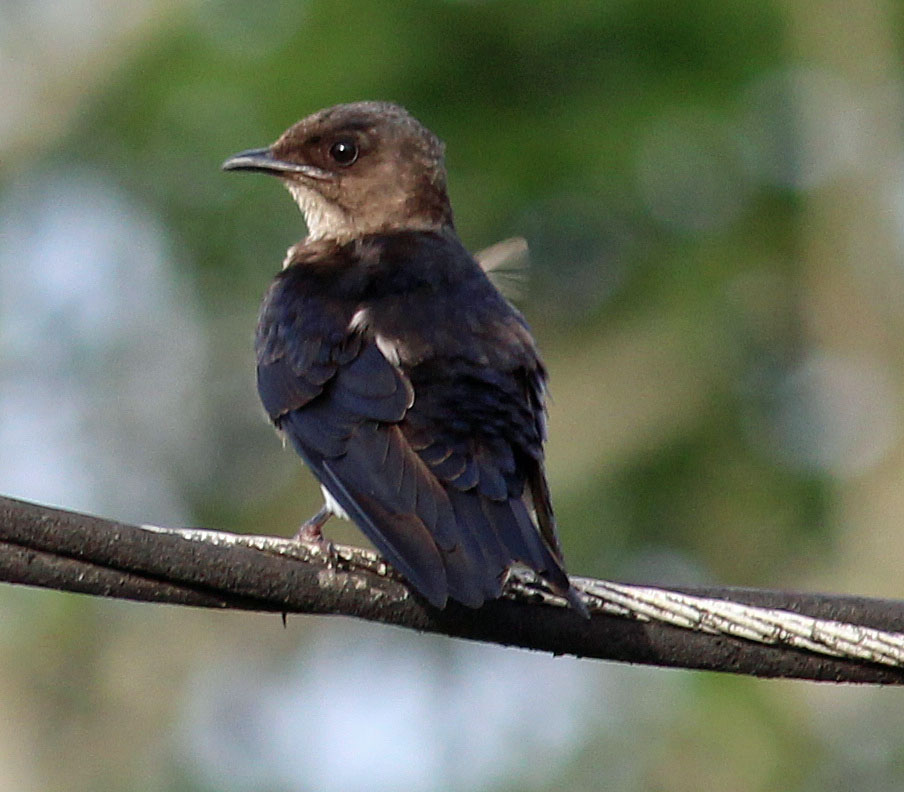 |
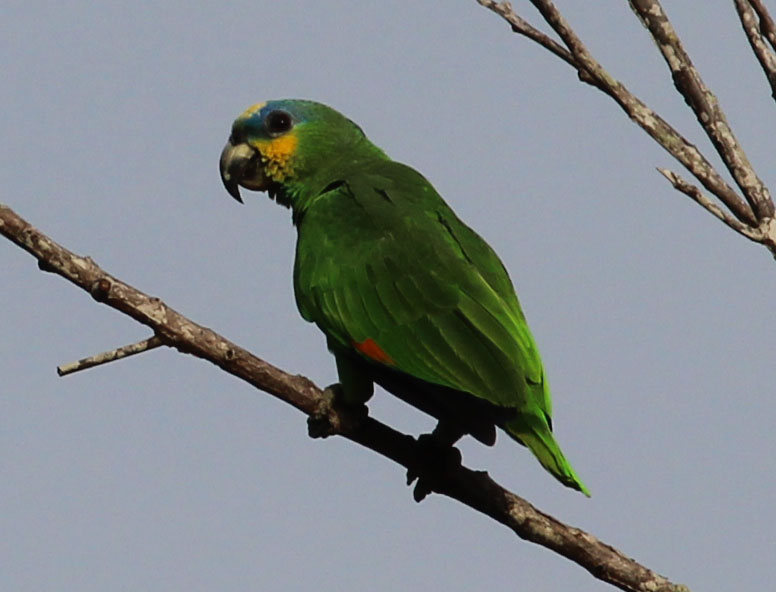 |
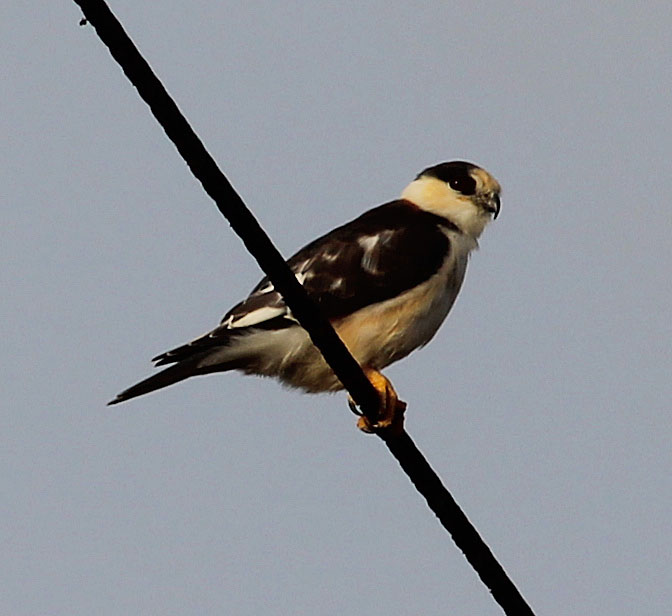 |
| Gray-breasted Martin | Orange-winged Parrot | Pearl Kite |
We had rum punches as our guides set up a picnic dinner. As the sun set a Tropical Mockingbird perched nearby.

After dark we had views of a Tropical Screech Owl by flashlight, Common Pauraque on the ground in the vans headlights, White-tailed Nightjars calling and flying swiftly by and a Common Potoo sitting on a fence post. As a bonus we found a Red Bracket Deer.
 |
 |
| Tropical Mockingbird | Common Pauraque |
Monday, April 25, 2016
Today we have an all-day field trip up higher in the mountains along Blanchisseuse Road. Before breakfast we had another view of a Green-backed Trogon. As we waited for the van we observed a stunning male Barred Antshrike as well as a Green Hermit feeding two young in a nest in a potted plant in the car park.

Barred Antshrike
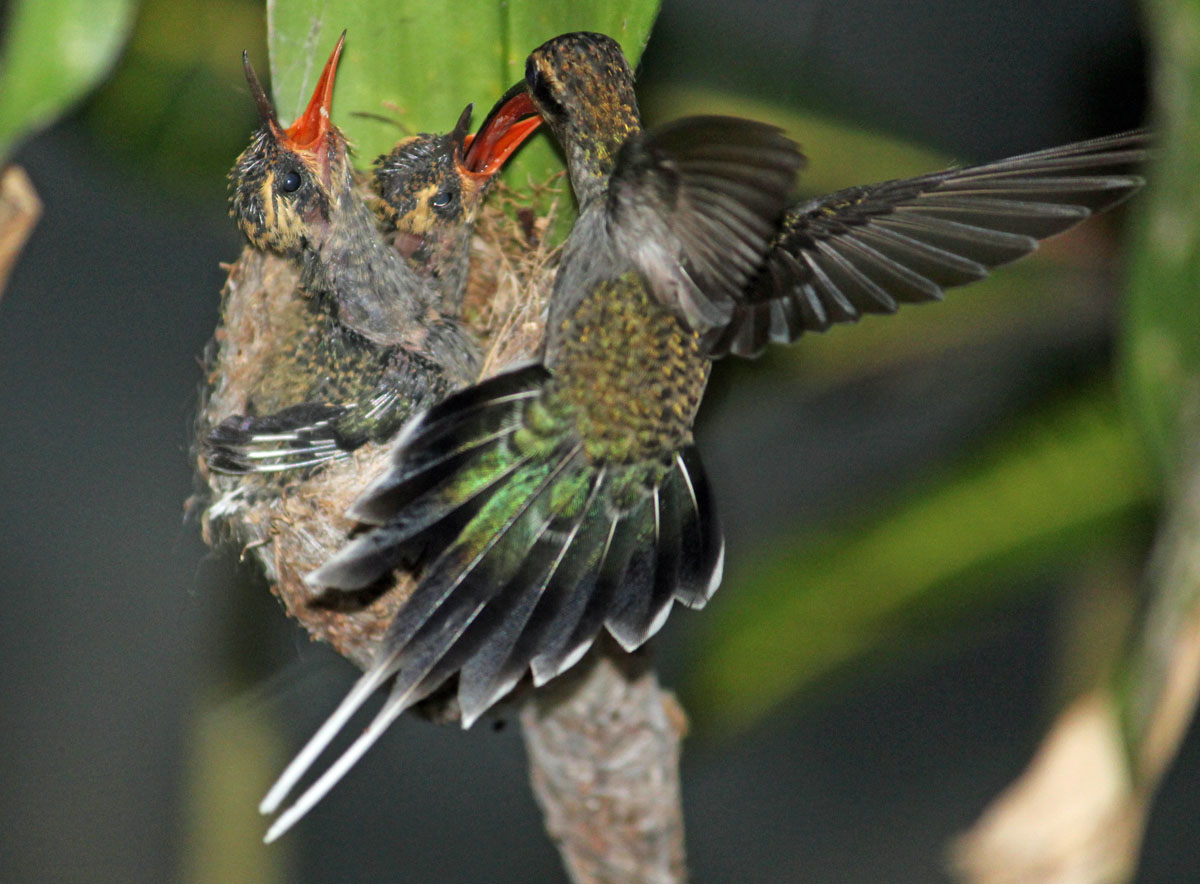
Green Hermit
We stopped at various pullouts along this narrow mountain road. Some of the first birds we saw were Guianan Trogon, Streaked Xenops, Swallow Tanager, Boat-billed Flycatcher, a rare Variegated Flycatcher, Long-billed Gnatwren , Tropical Parula, and Red-legged Honeycreeper.
 |
 |
| Guianan Trogan | Variegated Flycatcher |
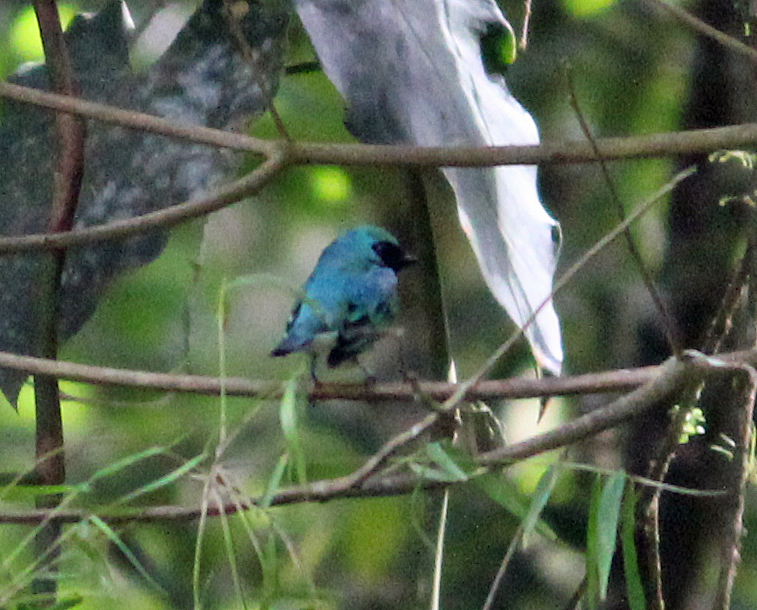 |
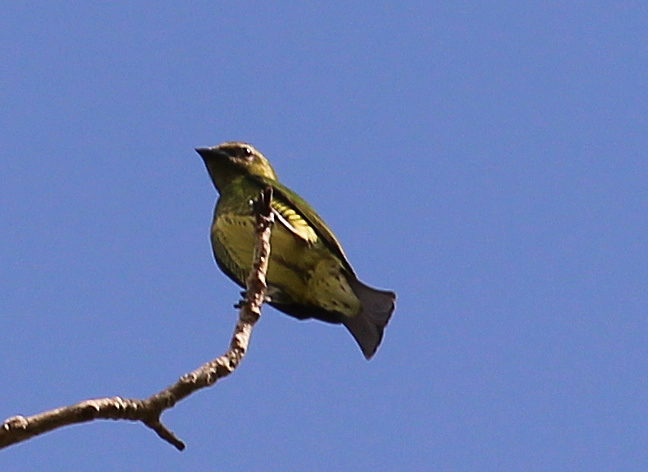 |
| Swallow Tanager male | Swallow Tanager female |
We had our first butterflies of the trip and which included a Red Postman and an Owl butterfly. I also had a quick fly by Zone-tailed hawk.
Further up a Magnificient Frigatebird flew by indicating we were getting close to the top and near the north coast of Trinidad. We also added the cool looking Rufous-tailed Jacamar, Rufous-breasted hermit, Gray-rump Swift, Tropical Pewee, Golden-fronted Greenlet, Bay-headed tanager and Southern Beardless Tyrannulet.
We walked down a dirt road and Dave, our guide got us looks at Great Antshrike, White-bellied Antbird and we heard the Black-faced Ant-thrush but he would not show himself. We then had an unexpected Chestnut Woodpecker and eventually saw a pair, possibly by their nest hole. A Cocoa Woodcreeper made an appearance. After a water break back at the van a few Plumbeous Kites soared high overhead and Dave located a Collared Trogon, making it a three trogon day.
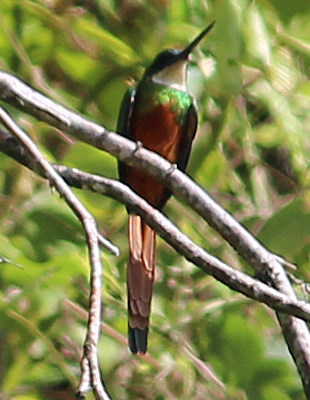 |
 |
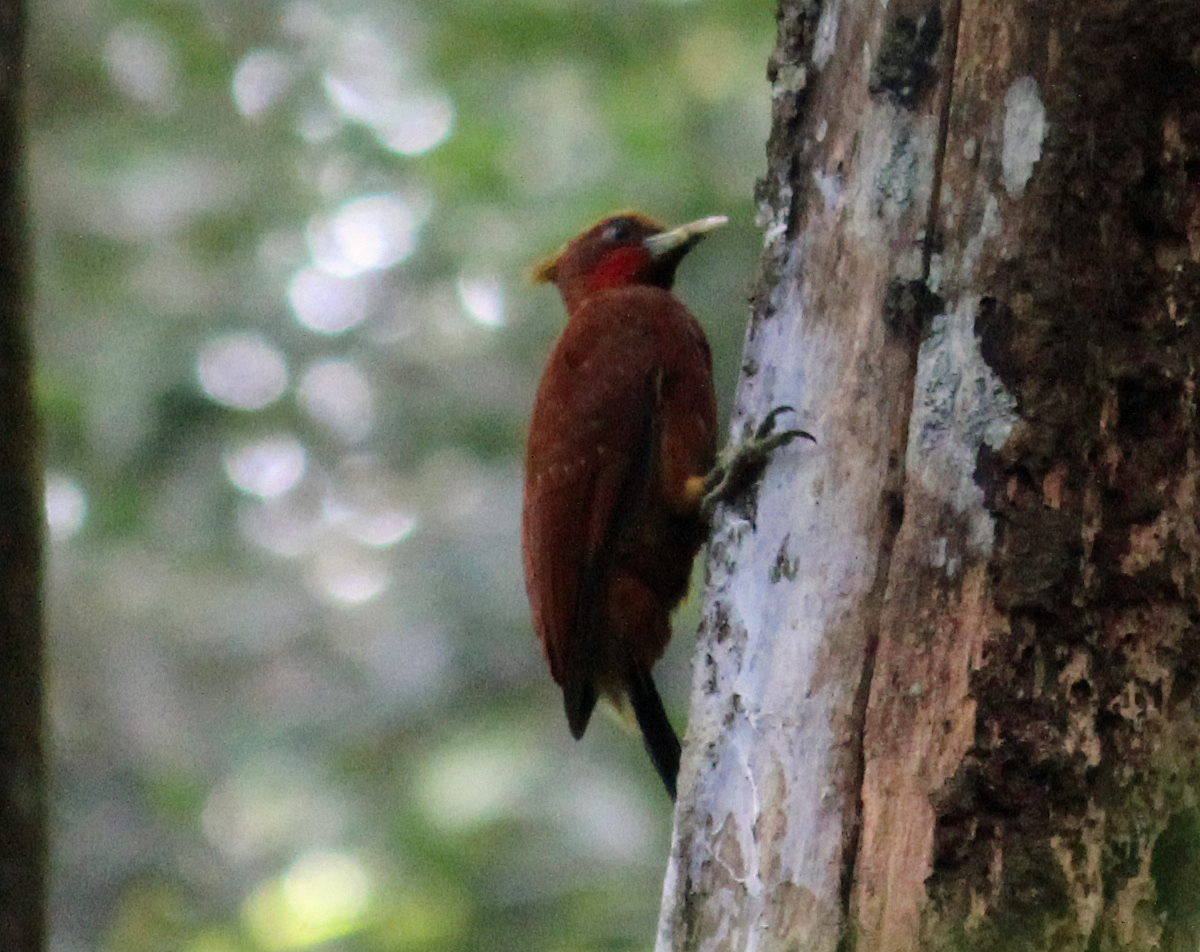 |
| Rufous-tailed Jacamar | White-bellied Antbird | Chestnut Woodpecker |
Lunch was at Brasso Secco, near the end of the road, at a visitor facility. It was a selection of local dishes; Smoked Chicken in RouCou Sauce, Dallalloo, Turmeric Rice, Provision, Plantain and Corn Pie. Drinks included Jungle Juice (a citrus mix)

I tried a yellow hot sauce and it was HOT. I found out it is made from Scotch Bonnets (aka Caribbean red peppers ). They tend to have 100,000–350,000 Scoville units which means about as hot as a habanero but with more flavor.
Lunch was followed by a Cocoa demo. There is a program up here that encourages the locals to make and sell their own chocolate. A ripe yellow cocoa fruit was split open and we were encouraged to taste the slimy, white, but delicious paste called mucilage, that covers 30-50 cocoa beans. We could then eat the bean itself which was slightly bitter. The process of making a paste and how to separate cocoa oil from cocoa powder was demonstrated. The seeds are fermented, dried, roasted, cracked and winnowed to remove the shell resulting in cocoa nibs. Cocoa nibs can be pressed to separate the cocoa butter from the cocoa powder. The program concluded with some of the best tasting chocolate ice cream ever. We each got a free chocolate bar and we brought some extra to support their business.
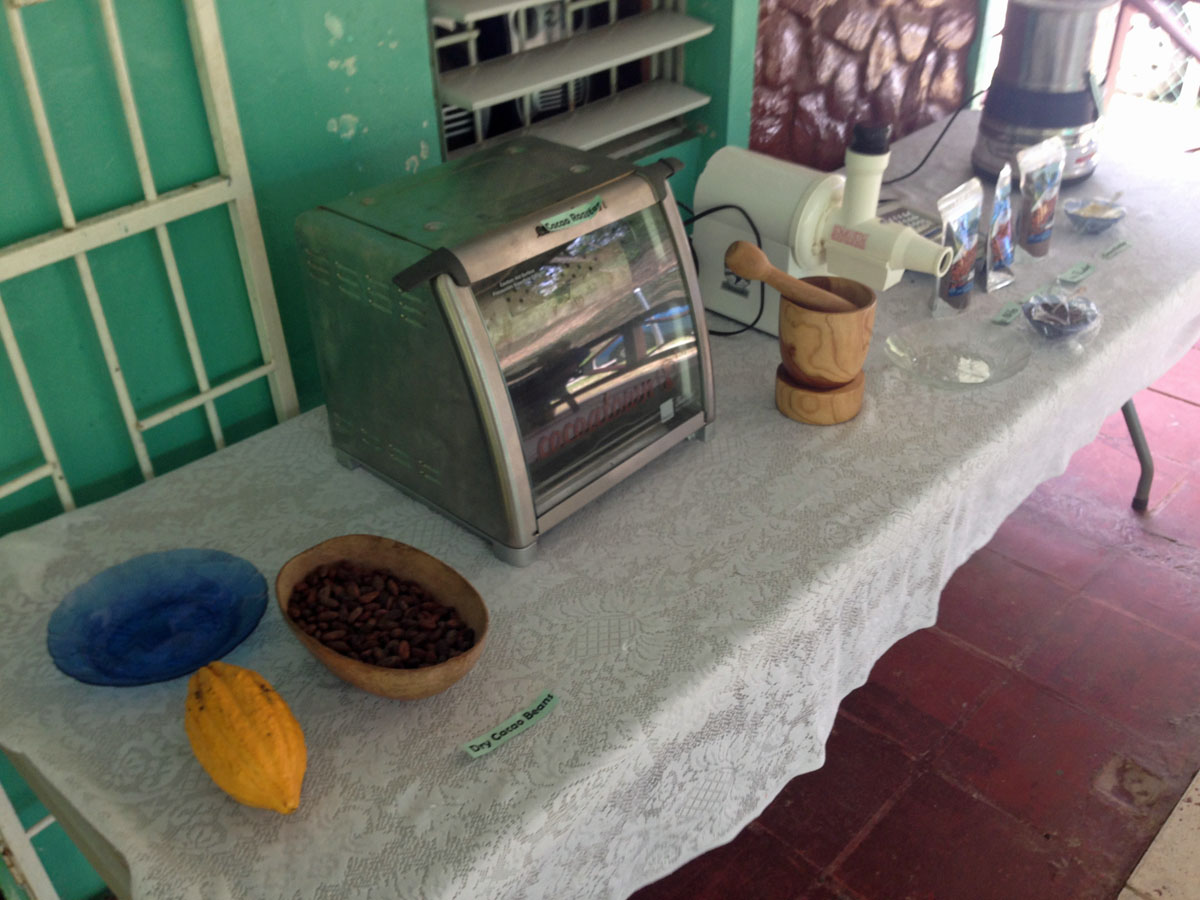

A Ruddy Ground Dove nest was found in the pavilion and we watched a mother feed her chicks.
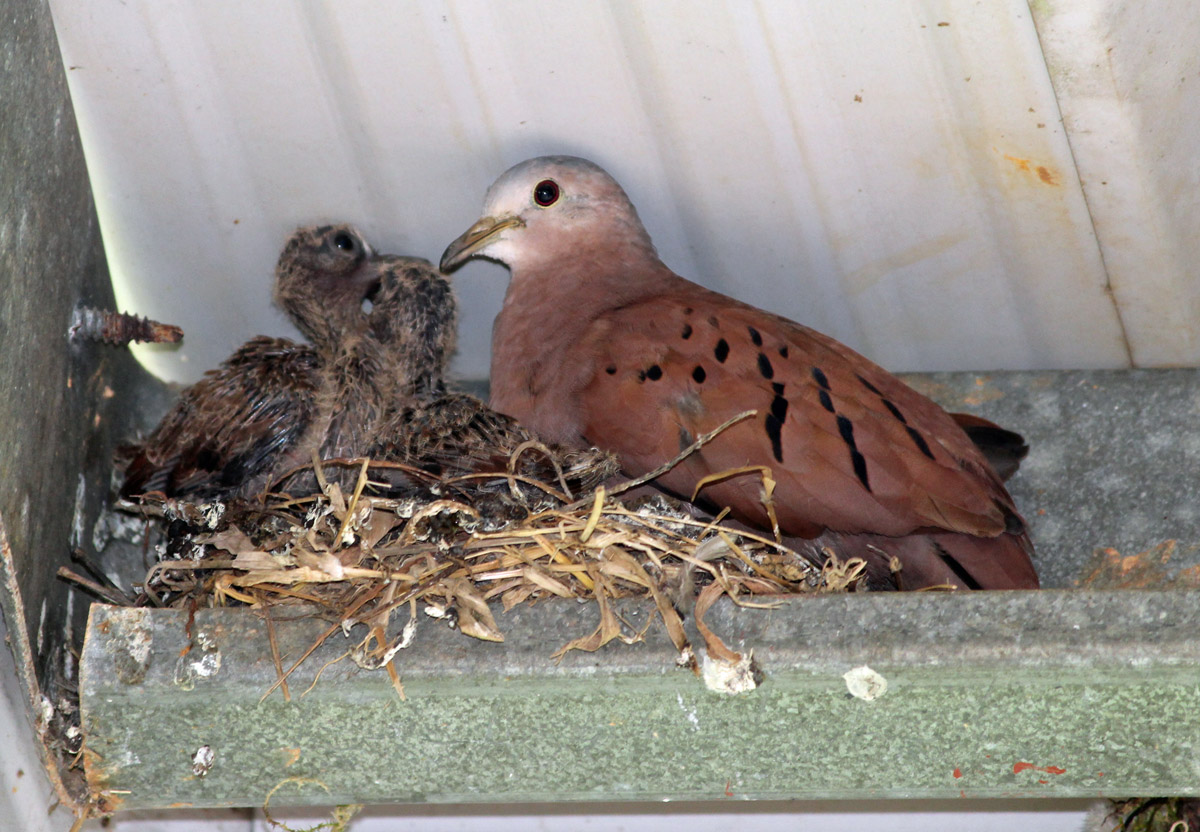
Ruddy Ground Dove
It was then onto Morne le Croix where we found a number of Blue-headed Parrots along with some Yellow-rumped Cacique.
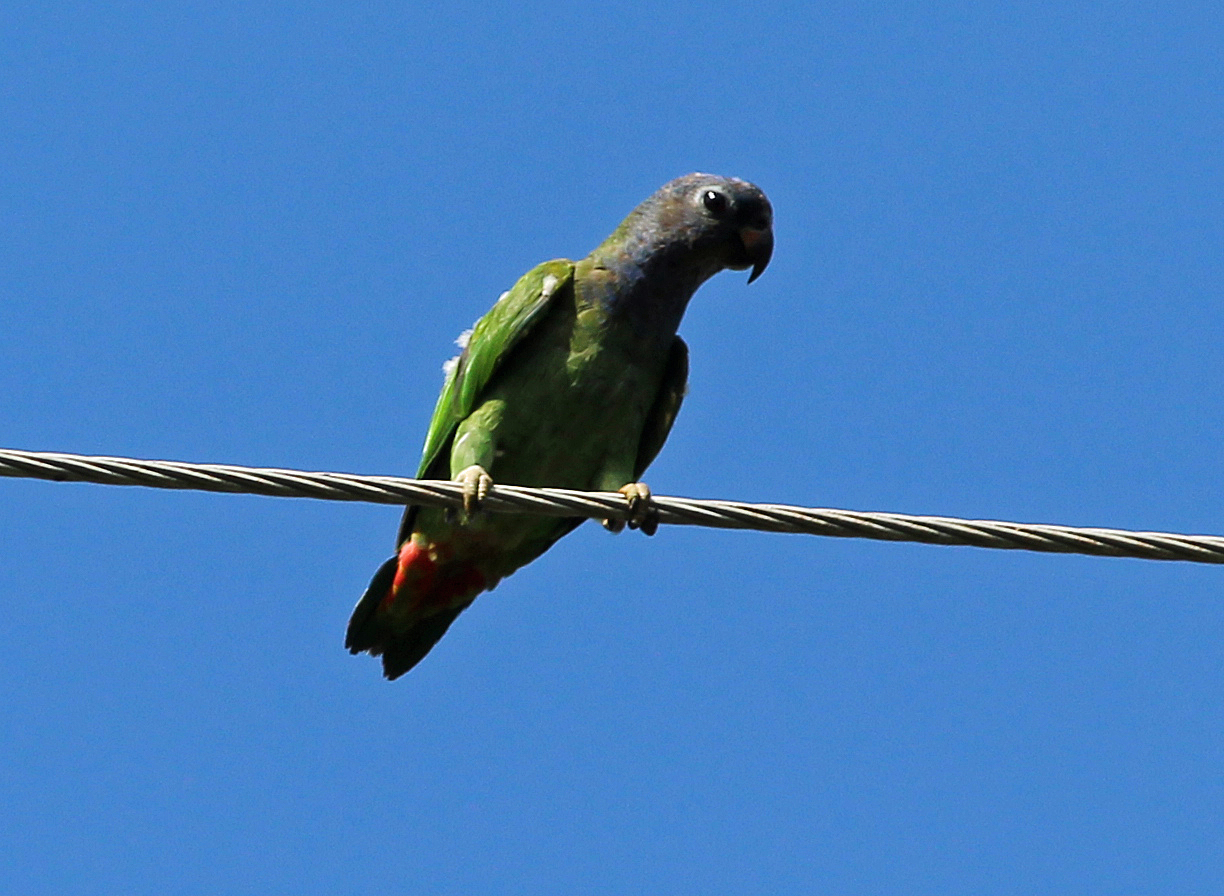
Blue-headed Parrot
Back at Asa Wright a few of us visited the small museum downstairs.

Asa Wright Museum
Before dinner a Lineated Woodpecker and Pale-breasted Spinetail were added from the verandah, followed by another round of relaxing rum punches.
Dinner consisted of Pumpkin Ginger Soup, Sweet and sour chicken, Chow Mein, noodles, and fried rice; but it was not like at home. Dessert was a very sweet Paw-Paw Baverian.
Tuesday, April 26, 2016
Today we have our Oilbirds walk in the morning, then an afternoon trip to Caroni National Park with a boat trip to see Scarlet Ibis. We started the day near the car park to look for two species of Antshrike that hang out here. We had great looks at both male and female Barred Antshrikes and eventually found the Great Antshrike lurking low in the bushes. We also had a good look at a Red-tailed Squirrel.
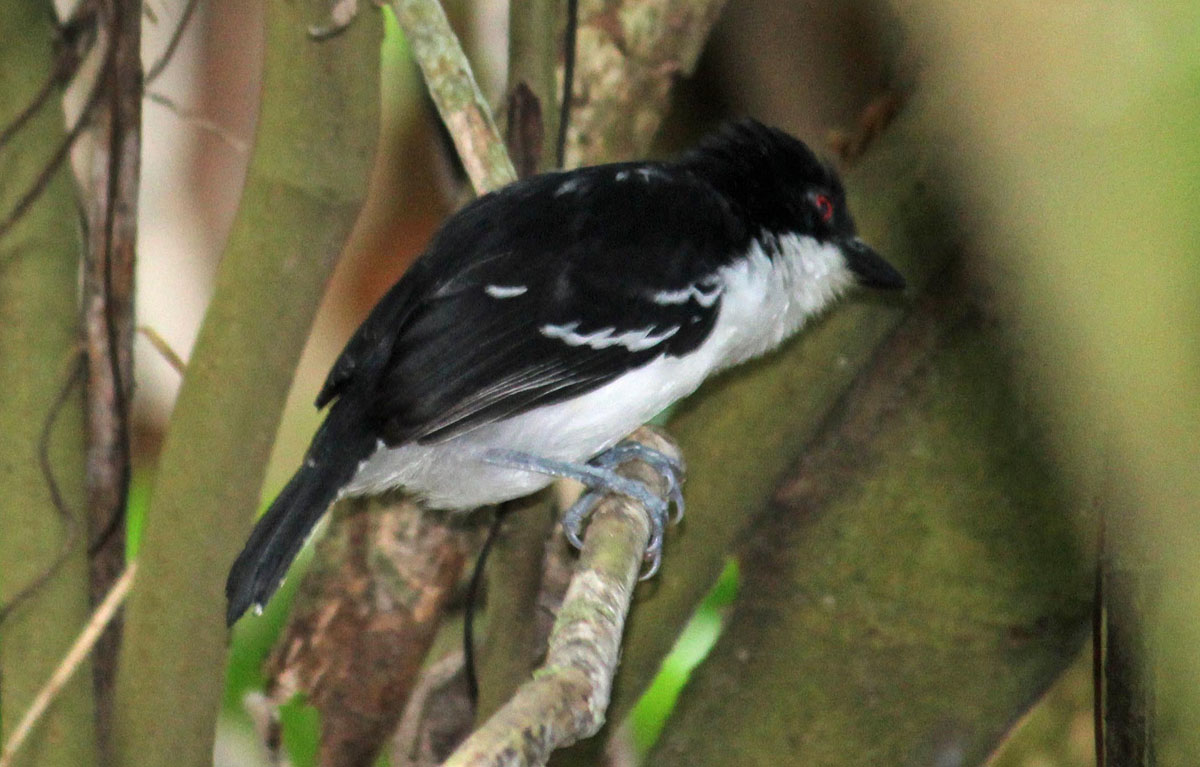 |
 |
 |
| Great Antshrike | female Barred Antshrike | Red-tailed Squirrel |
After breakfast we met in the lounge with Randal who will be taking us to the cave where the Oilbirds roost. Tiffany joined us on the walk. Oilbirds are the only nocturnal flying fruit-eating birds in the world and the only ones to use echolocation the way bats do.
The walk to the cave took about 30 minutes with some steep trails but railings made them easy to navigate. We came across a huge butterfly (5 inches across) called an Illioneus Giant Owl. It stayed just long enough for a picture or two.
As we neared the entrance to the cave it started to rain a bit. We entered the cave three at a time. The floor was littered with Oil Palm nuts; this fruit is their main diet and why they are called Oilbirds. We were told that dead young oilbirds were sometimes impaled on a stick and used as a long-burning torch. The noise they make when disturbed can only be descried as someone being strangled. We all had great looks. We could not use flash on our cameras so as not to disturb them, so our pictures are a bit fuzzy.
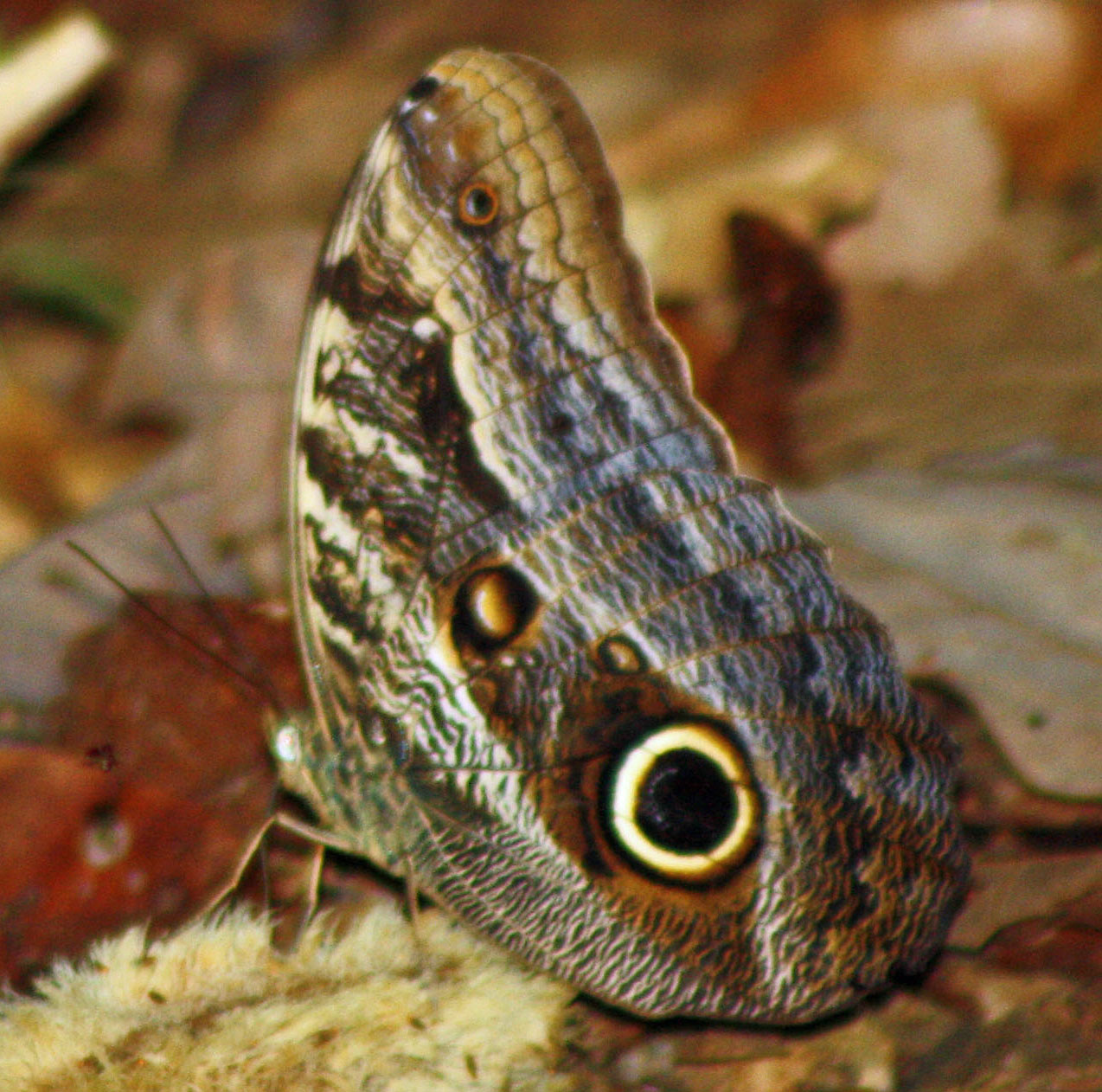 |
 |
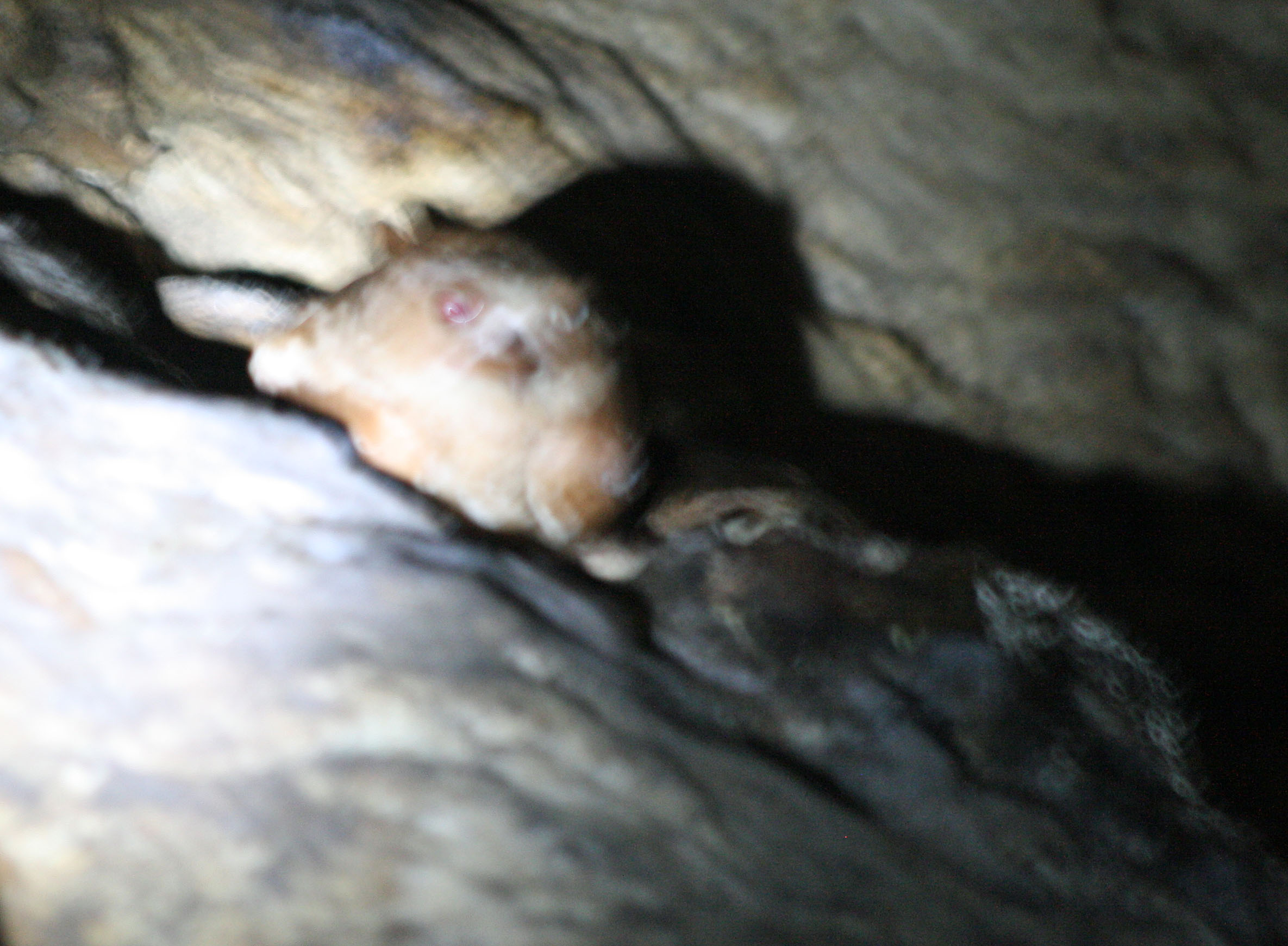 |
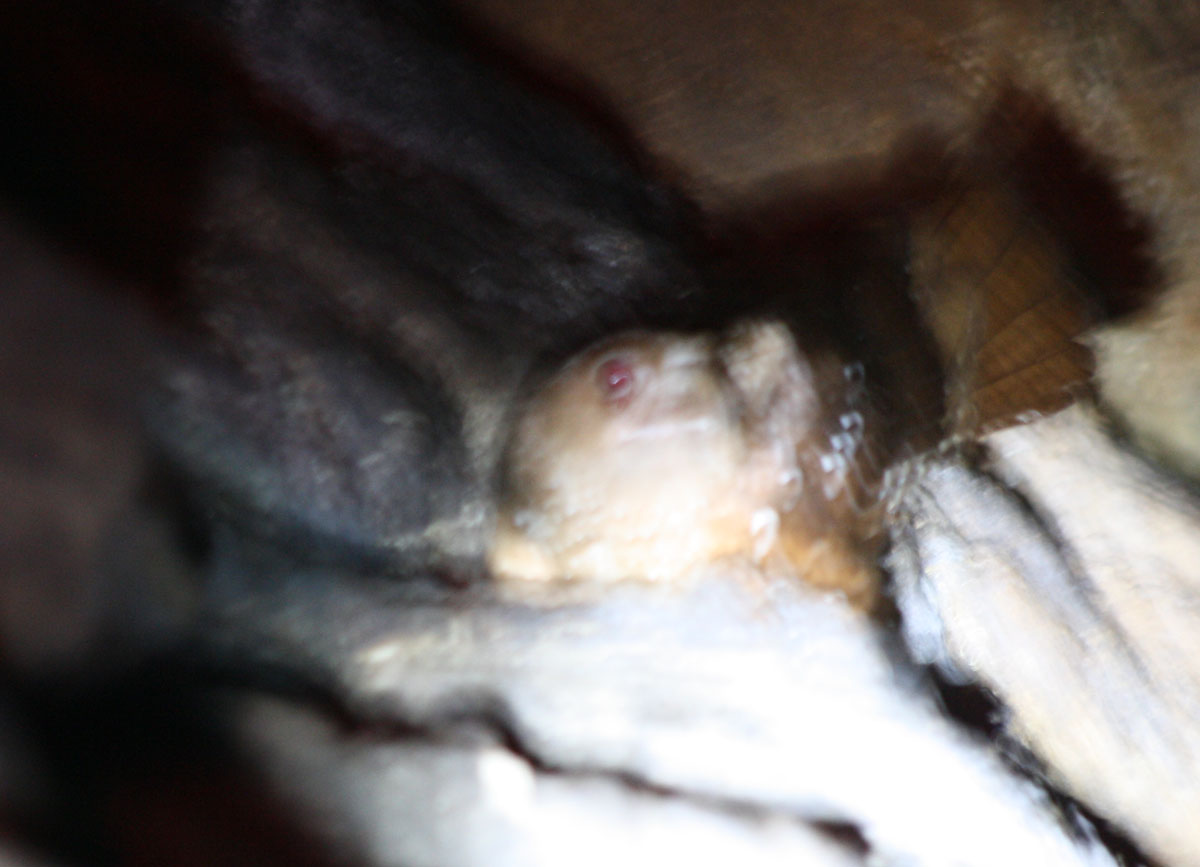 |
| Illioneus Giant Owl | The Grotto | Oilbird | Oilbird |
On the walk back I found a few species of butterfly including a Smooth Banded Sister, Penelope Satyr and Hermes Satyr.
It rained on and off till lunch time. At one point during a heavy rain the male White-necked Jacobins bathed on branches, letting the rain wash them.
After lunch our guide Dave took us back down the mountain. It was drier now and our first stop was the Trincity Sewage Treatment Ponds. We quickly added to our bird list with Purple Gallinule, Yellow-billed Tern, White-winged Swallow, Pied-water Tyrant, and Yellow-hooded Blackbird.
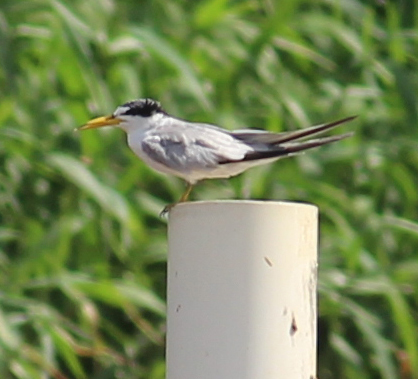 |
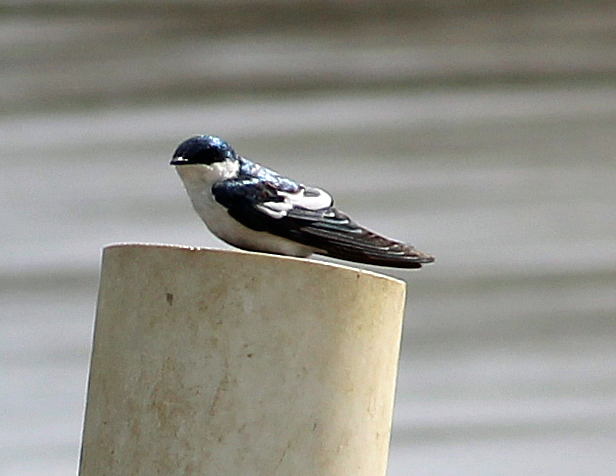 |
| Yellow-billed Tern | White-winged Swallow |
Along the route to Caroni National Park I had a brief view of a Long-winged Harrier but we could not stop due to the busy road. Just outside the park we had distant views of Blue-winged Teal, Neotropical Cormorant, Great Blue Heron, including the white form, Black-necked Stilt, and Common Gallinule.
Near the guard building we found beautiful Masked (Red-capped) Cardinals and a new hummingbird, a Green-throated Mango and a close Pied-water Tyrant. On the edge of the mangrove swamp we had a brief but great look at a Mangrove Cuckoo and Dave called in an American Pygmy Kingfisher.
 |
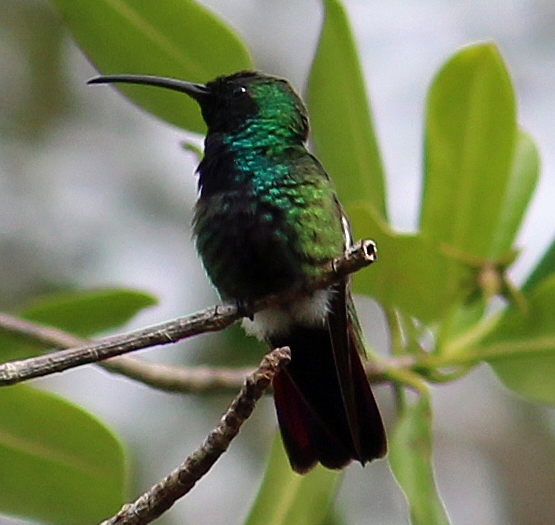 |
| Masked Cardinal | Green-throated Mango |
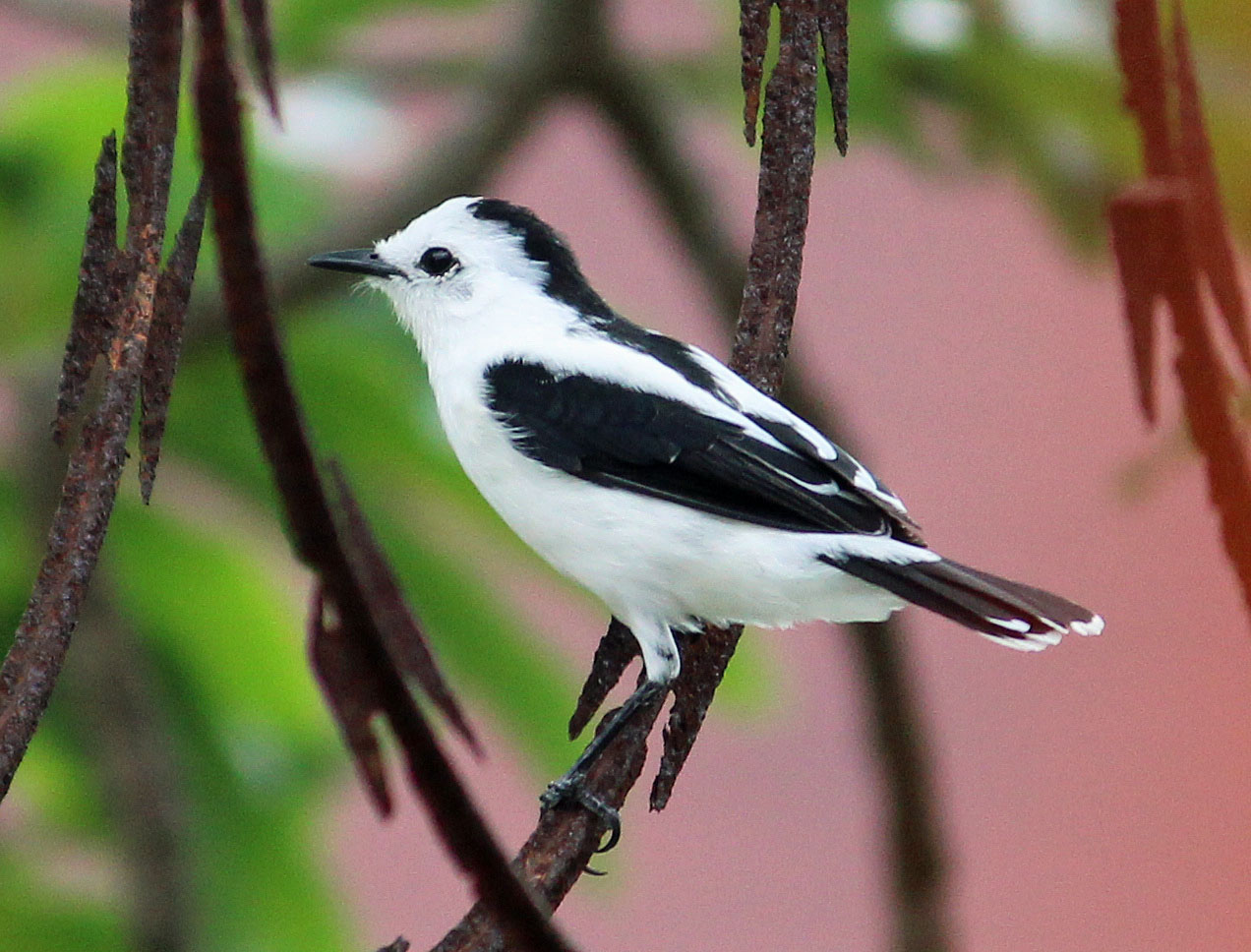 |
|
| Pied-water Tyrant | American Pygmy Kingfisher |
We then all loaded onto a boat for our tour. Our first sighting were two balled up Silky Anteaters sleeping in a tree. Just after that, the skies open up and it rained heavy for about 5 minutes. After that the rain was done and eventually the skies cleared.
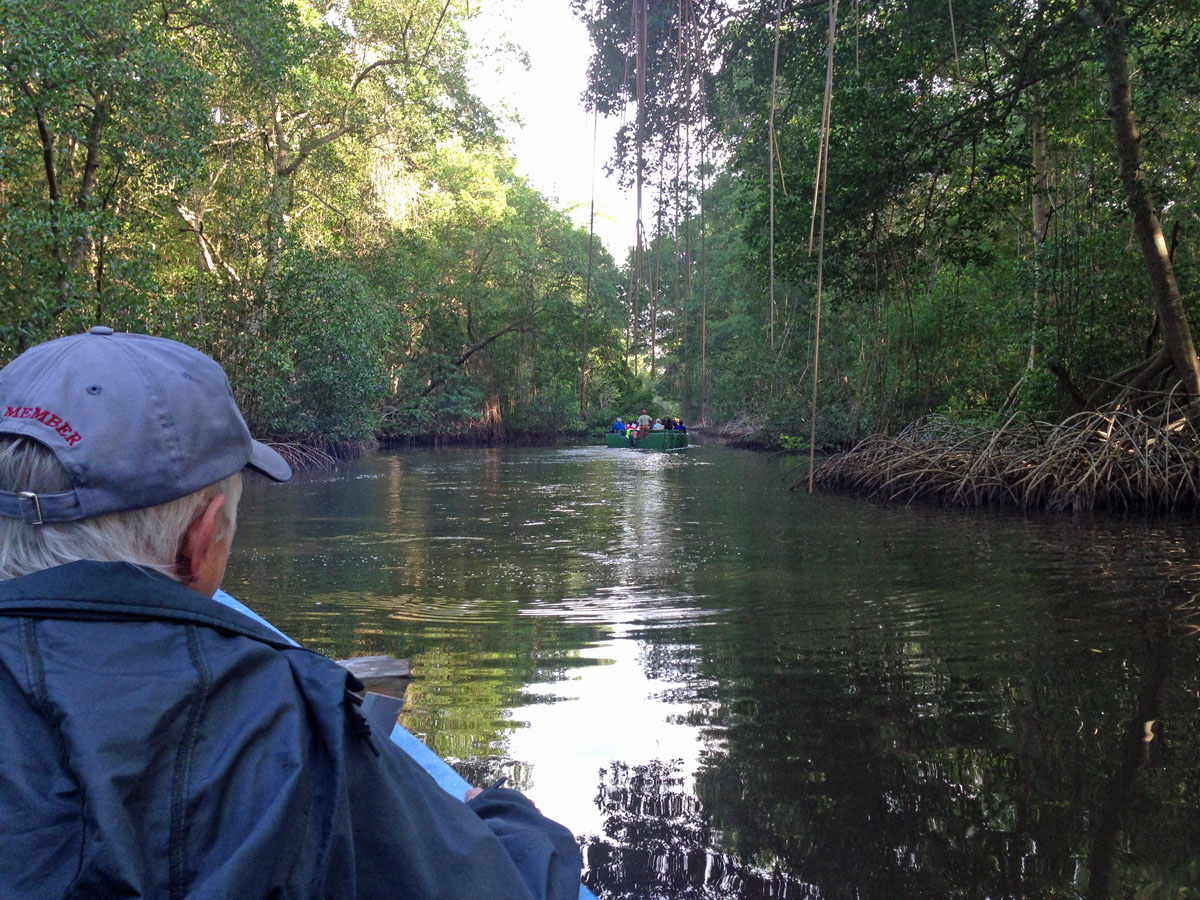
The channel in the mangrove swamp was filled with birds. We had an excellent look at a Tropical Screech Owl, a glimpse of a Green Kingfisher as it flew away, Straight-billed Woodcreeper, Rufous-browed Peppershrike, and Bicolored Conebills. An Anhinga splashed into the water. Little Blue Herons were common and we saw our first few Scarlet Ibis deep in the mangroves before flying off.
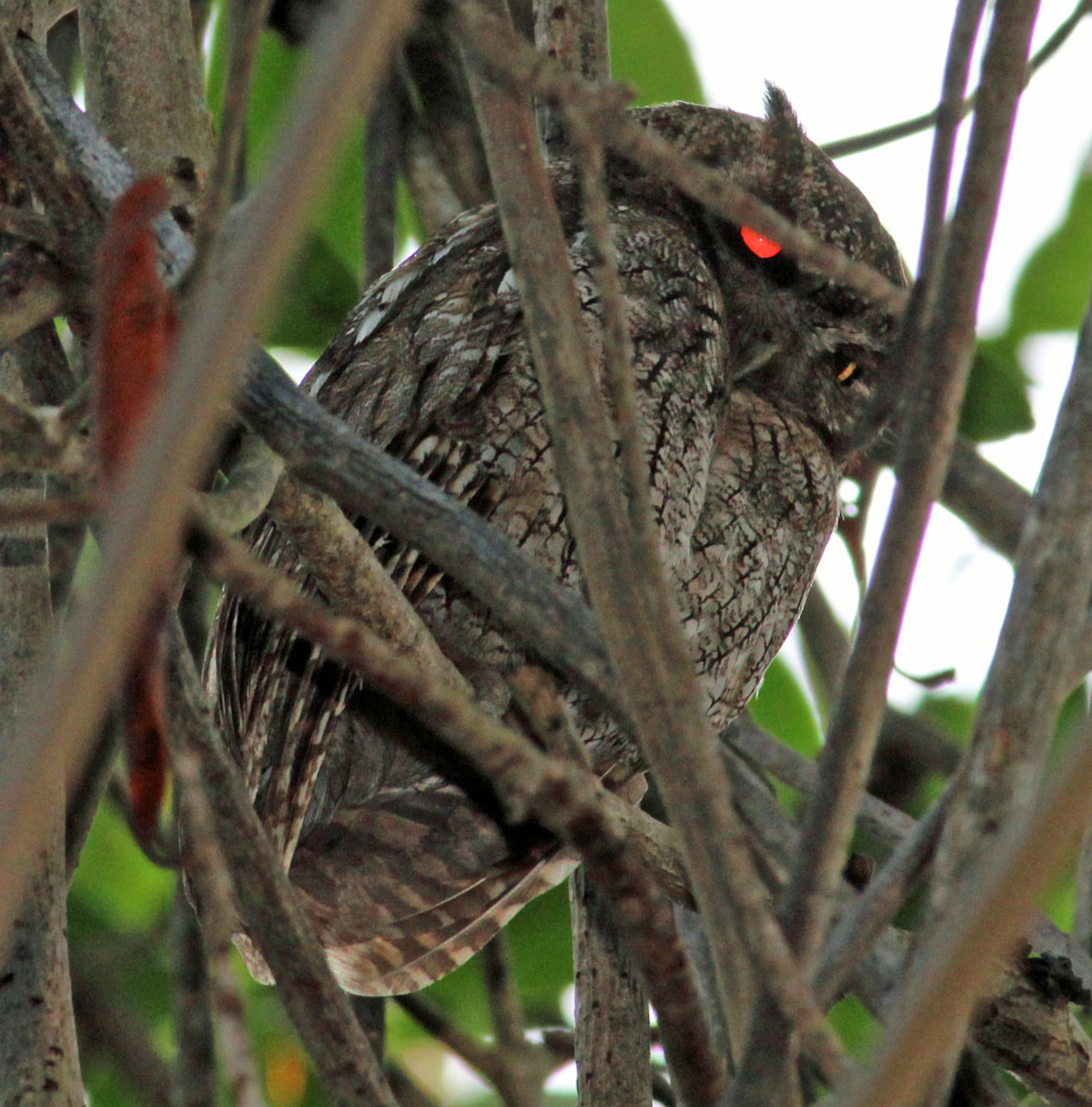
Tropical Screech Owl
We then hit some open water and as we rounded a large island a sandbar with eight tall birds appeared. They turned out to be eight American Flamingos! We circled them to a spot where boat can tie up in the water, with our backs to the sun and a large island in front of us. The flamingos were just off the left side of the island.
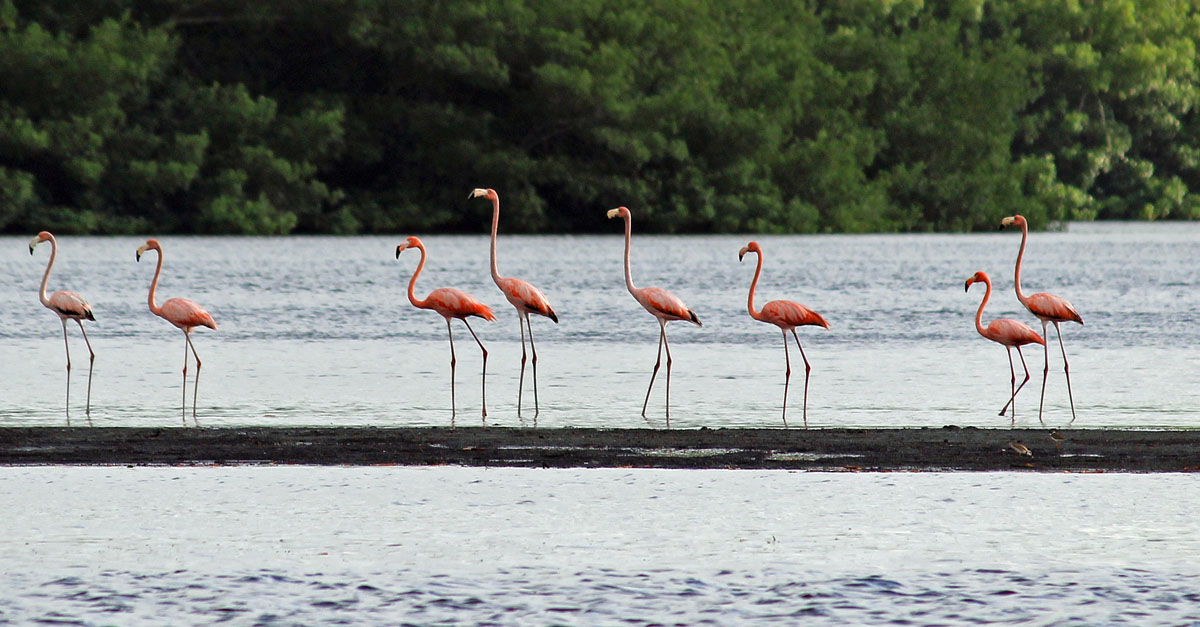
American Flamingo
A few Tricolored Herons joined the flamingos as did some Semipalmated Plovers. It was kind of odd that these small 4 inch high plovers were next to nearly 60 inch high flamingos.
As we waited the rum punch was brought out. What a way to relax; on the water, in view of flamingos, with the sun setting.
Finally a few flocks of Scarlet Ibis started to fly in and land on the island. Their neon scarlet color beaming in the setting sun - more and more arrived. To top it off, part of a rainbow appeared in the sky. Over a thousand Scarlet Ibis made their way onto the island.
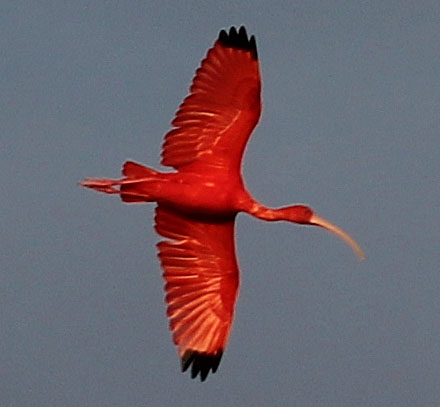
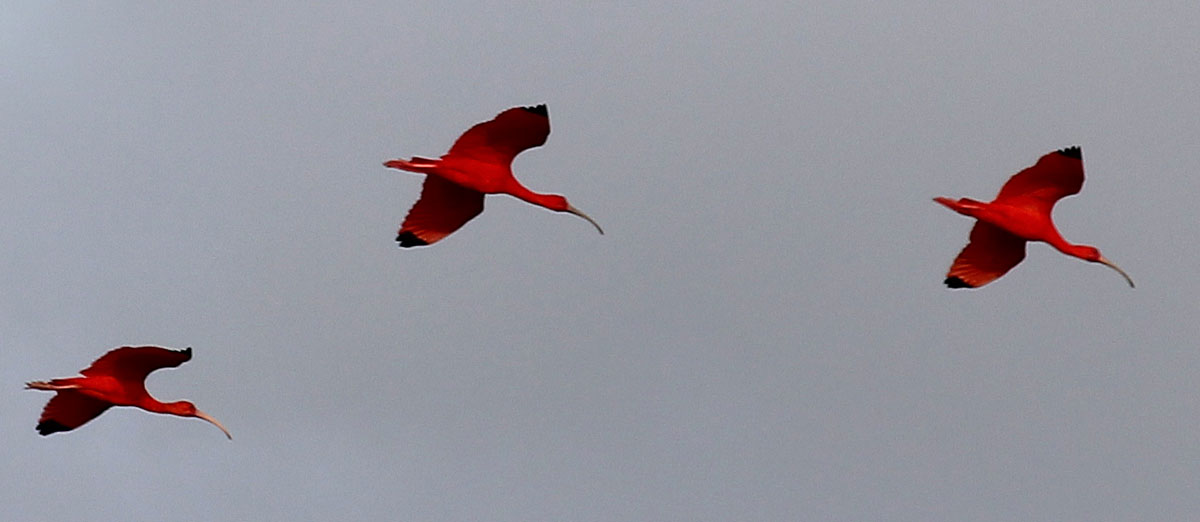
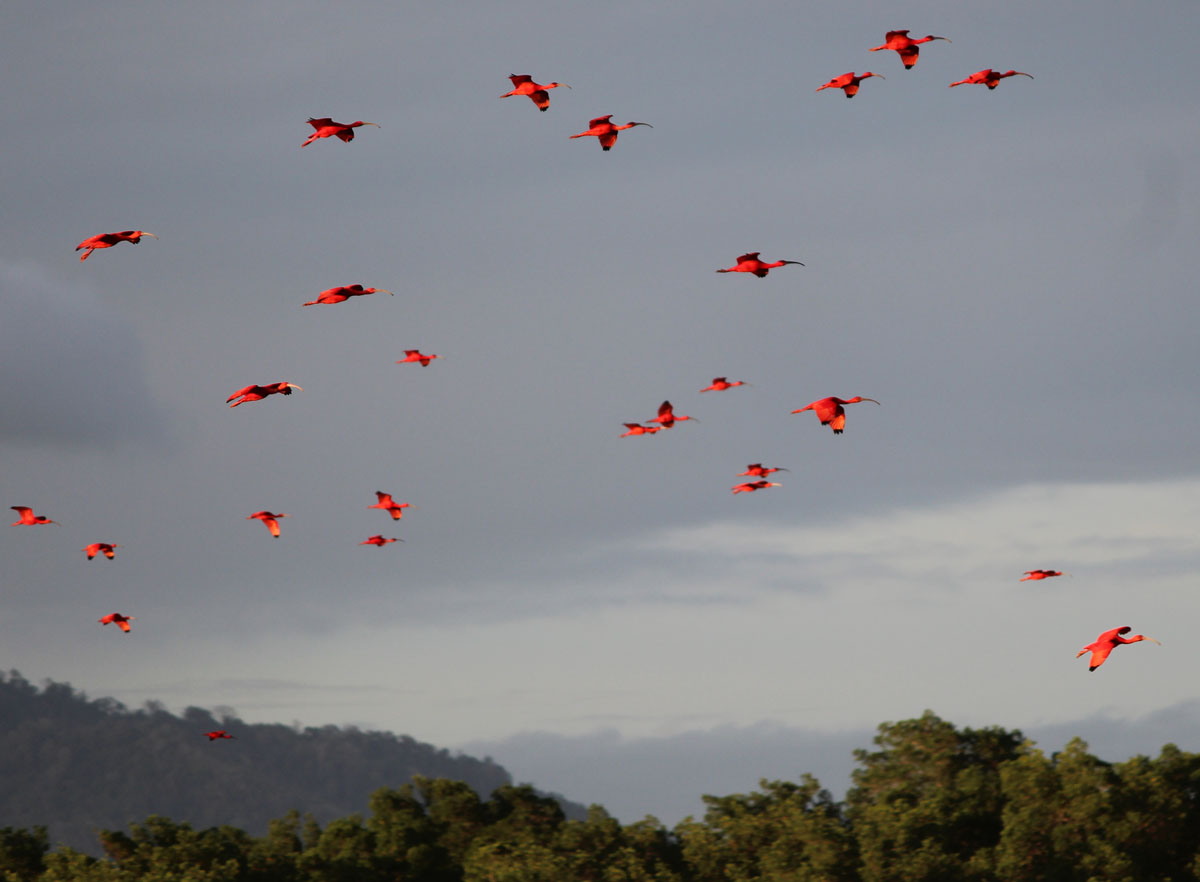
Scarlet Ibis
On our way back in we added a close Yellow-crowned Nigh Heron. In the mangrove channel we saw lots of smaller bats. Dave said they were mostly Brazilian Long-nosed bats.
When we got back to Asa Wright we suddenly stopped on the long driveway. A Trinidad Chevron Tarantula was clinging to a railing. We all got out and had great looks at this huge tarantula. This species is common in the pet trade for those who keep pet tarantulas.
 |
 |
| Yellow-crowned Night-Heron | Trinidad Chevron Tarantula |
We were late for dinner. The British birding group as well as our new friends Tiffany and Steve were finishing up dinner when we arrived. Tiffany will be giving a presentation tonight on her art work in paper sculpture of animals. Dinner included Vegetable Soup, Roasted Pork with Orange Sauce, Macaroni Pie, Red Beans, Patchoi and Carrots, and Coconut Jell for dessert. We hurriedly finished and headed to the parlor to see her talk.
Tiffany Miller Russell won the Don Eckleberry Scholarship from the Society of Animal Artists. As part of that she had to give a program at Asa Wright Nature Center. She showed slides of her amazing intricate artwork/sculpture, made only of paper. She then discussed her process from inspiration, inception and to the final product. She also shared her notebooks of drawings and sketches. Check out her web page at http://www.wildlifeinpaper.com/
Wednesday, April 27,2016
We were up at our usual time. We found a house guest in our bathroom, a small two inch African House Gecko. We caught him and put him outside. As we walked down to the main building a tree was filled with nearly 30 Orange-winged Parrots.
On the verandah we had great close looks at a Violaceous Euphonia and a Golden-headed Manakin that posed for some quick pictures.
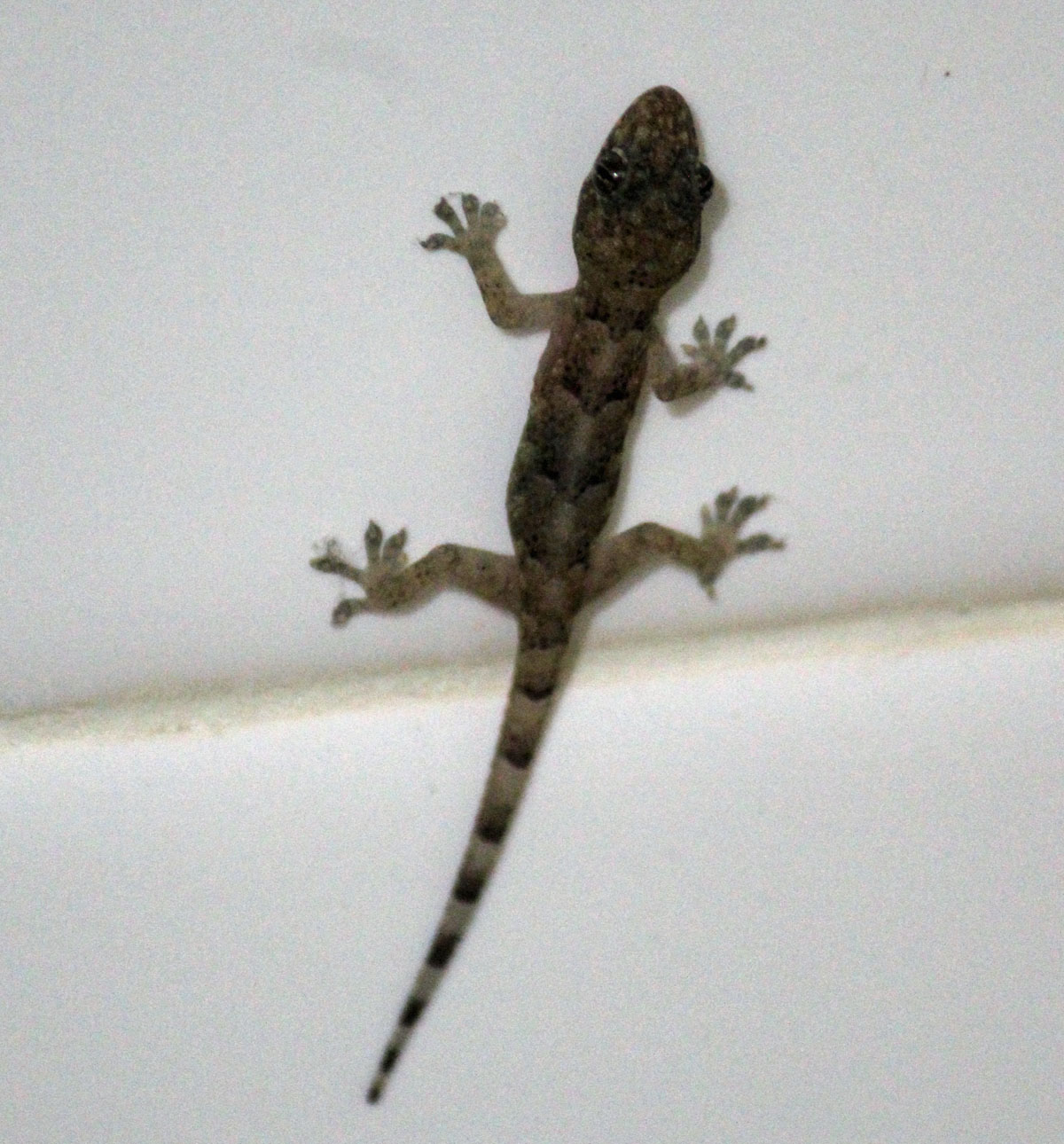 |
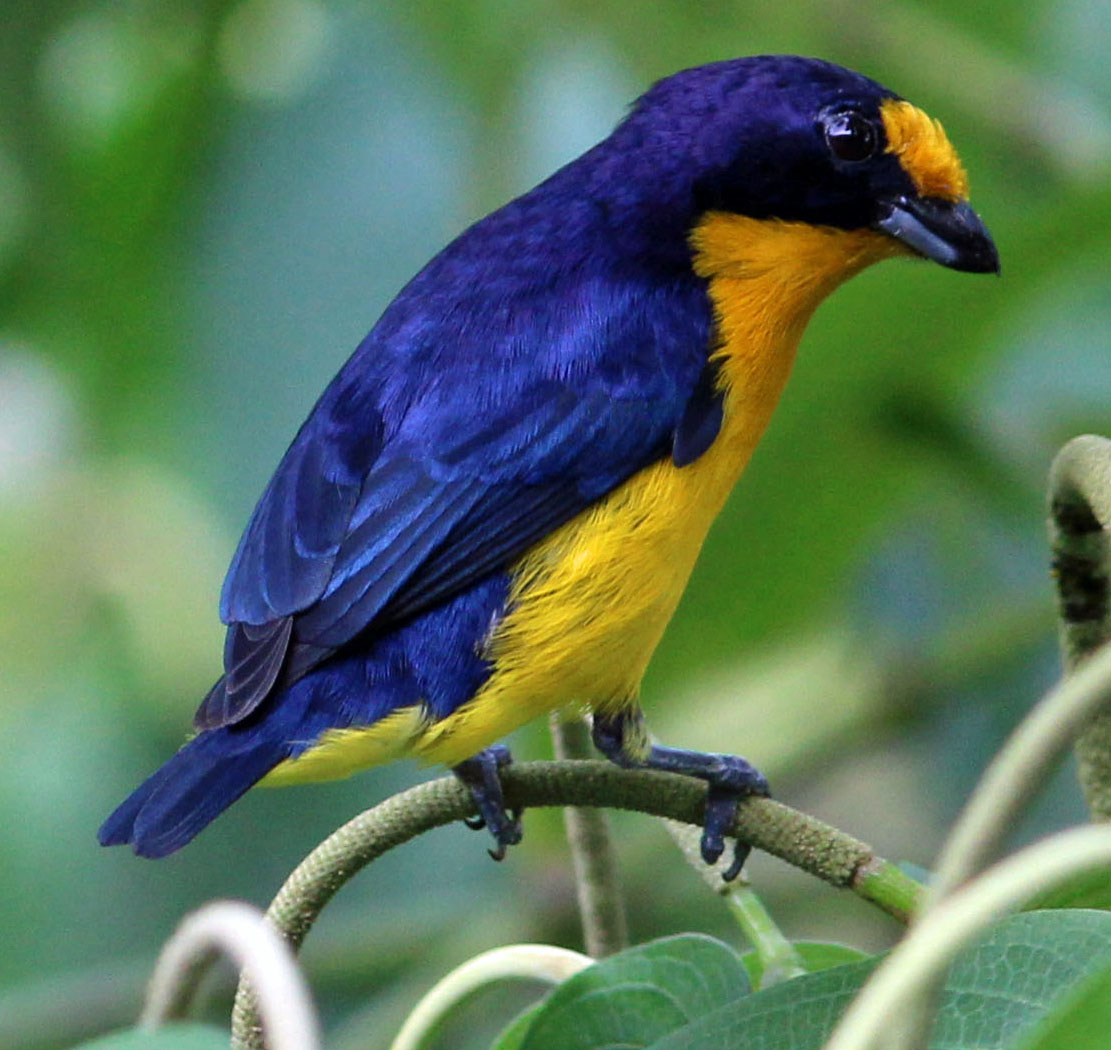 |
 |
| African House Gecko | Violaceous Euphonia | Golden-headed Manakin |
We had an all-day adventure heading out to the east coast on the Atlantic to Nariva Swamp and headed out shortly after breakfast.
We birded on our way out of Asa Wright. On the driveway we tried for Trinidad Motmot. They called and called but would not show themselves. As a bonus we did see a White-flanked Antwren near its nest and we heard Golden-crowned Warbler but that was also not to be seen.
Judi requested a bathroom break as we made our way along lower Blanchisseuse Road. Dave stopped at his Aunt’s house and she graciously let a few of the ladies use the facilities. While we were waiting we found a Gray-lined Hawk perched in a tree in the distance, and we had our first look at a Piratic Flycatcher.
Further down the road we stopped for a Ferruginous Pygmy Owl.
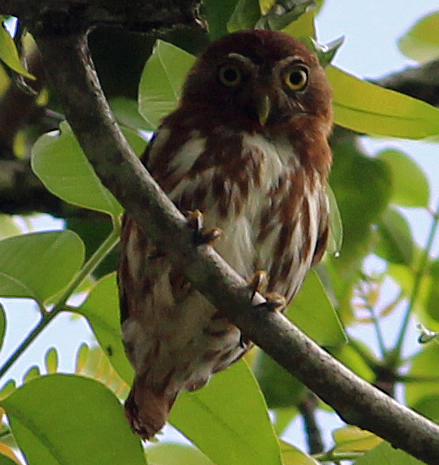
Ferruginous Pygmy Owl
We made our way back to the Aripo Livestock (Agriculture Research) Station to pick up some grassquits that occur here. Near an open barn we had our first Grassland Yellow-Finch and a Blue-black Grassquit . A Yellow-chinned Spinetail made a close appearance. Then we had one of the rarer grassquits, two Ruddy-breasted Seedeaters along the fence line.
| |
|
|
| Grassland Yellow-Finch | Yellow-chinned Spinetail | Ruddy-breasted Seedeater |
We all walked the ranch road and had stellar looks at a Southern Lapwing. At the end of the road we observed what the research station is noted for; cattle that are a cross between Asian Longhorn and Brahmas.
 |
 |
| Southern Lapwing |
Back in the van a Fork-tailed Flycatcher was spotted along the fence, followed by close looks at a Red-breasted Meadowlark. A Savannah Hawk was perch on a telephone pole far away. We would get a much closer look later.
We had a long drive east. We stopped at a local bar in the town of Valencia for a bathroom break. I brought a Coca Cola Light ( same recipe as a diet Coke). I also spotted a Southern Rough-winged Swallow on a wire down the street.
 |
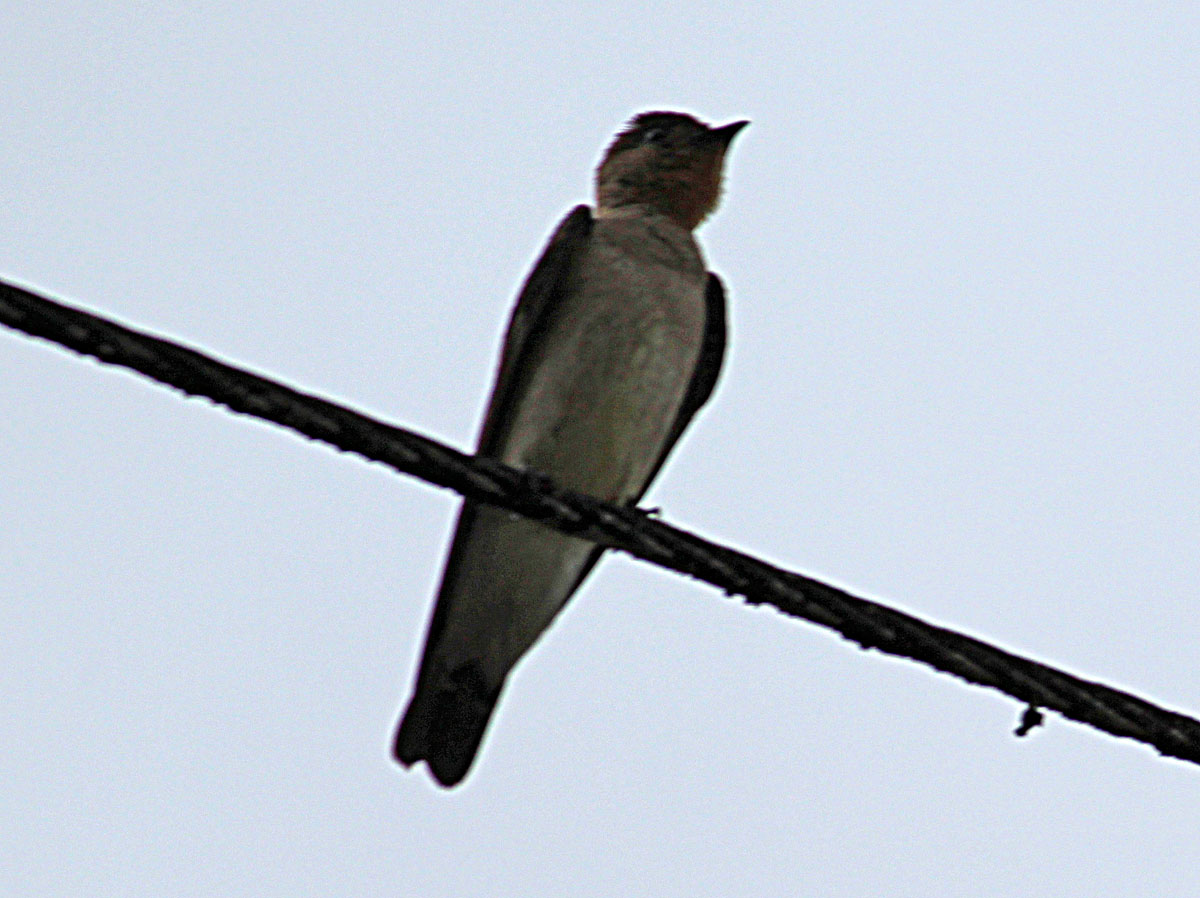 |
| Red-breasted Meadowlark | Southern Rough-winged Swallow |
Lunch was at Manzanilla Beach along the Atlantic Ocean. Fairly tame Gray-breasted Martins greeted us just outside the van. Magnificent Frigatebirds occasionally flew by as our guides set up a hot picnic lunch. Carib Grackles joined us hoping for a free handout. A few of us also found three Ruddy Turnstones along the beach. The ocean was devoid of birds.
We started on our way but stopped immediately outside the picnic area and found a Masked Yellowthroat.
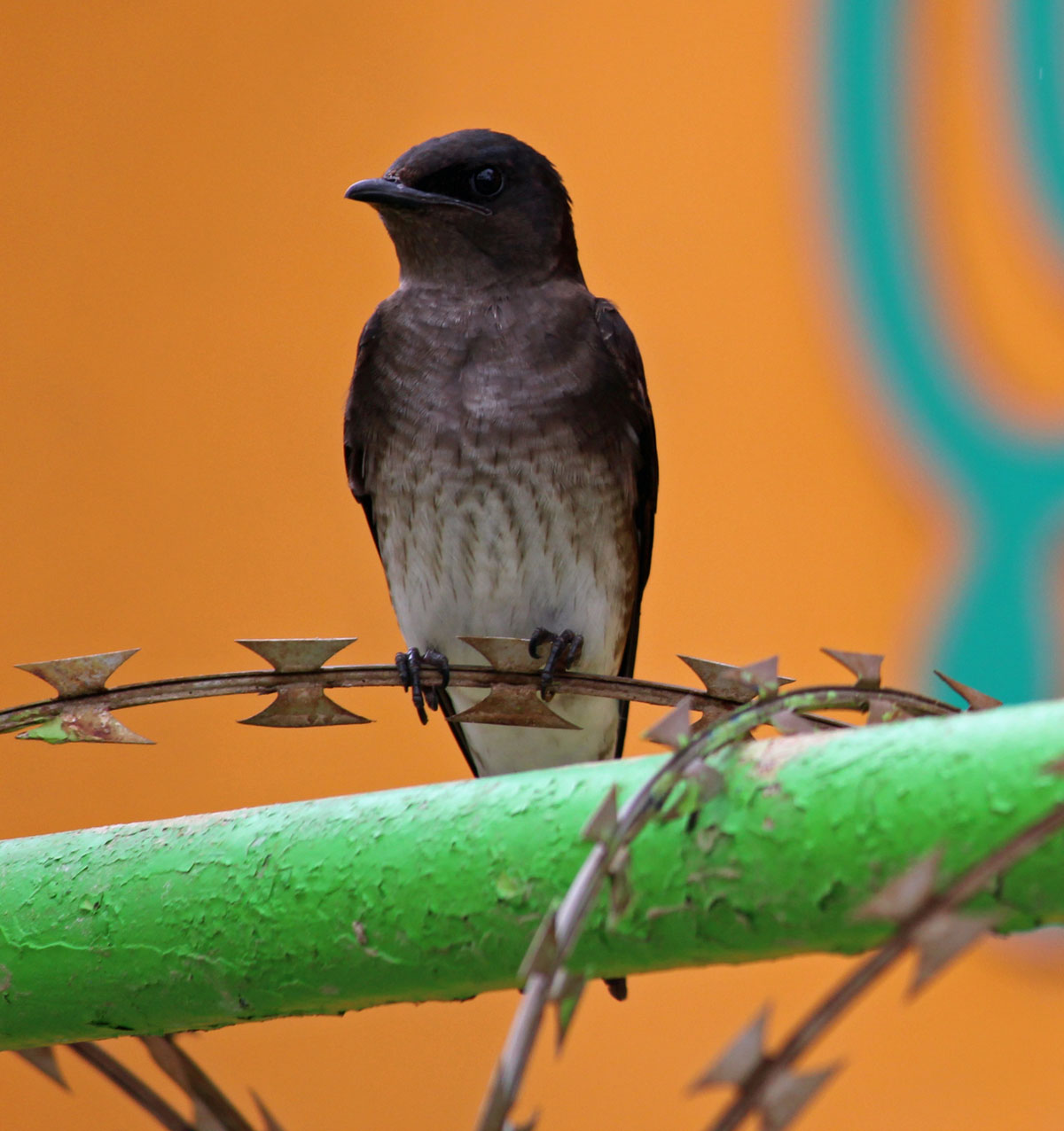 |
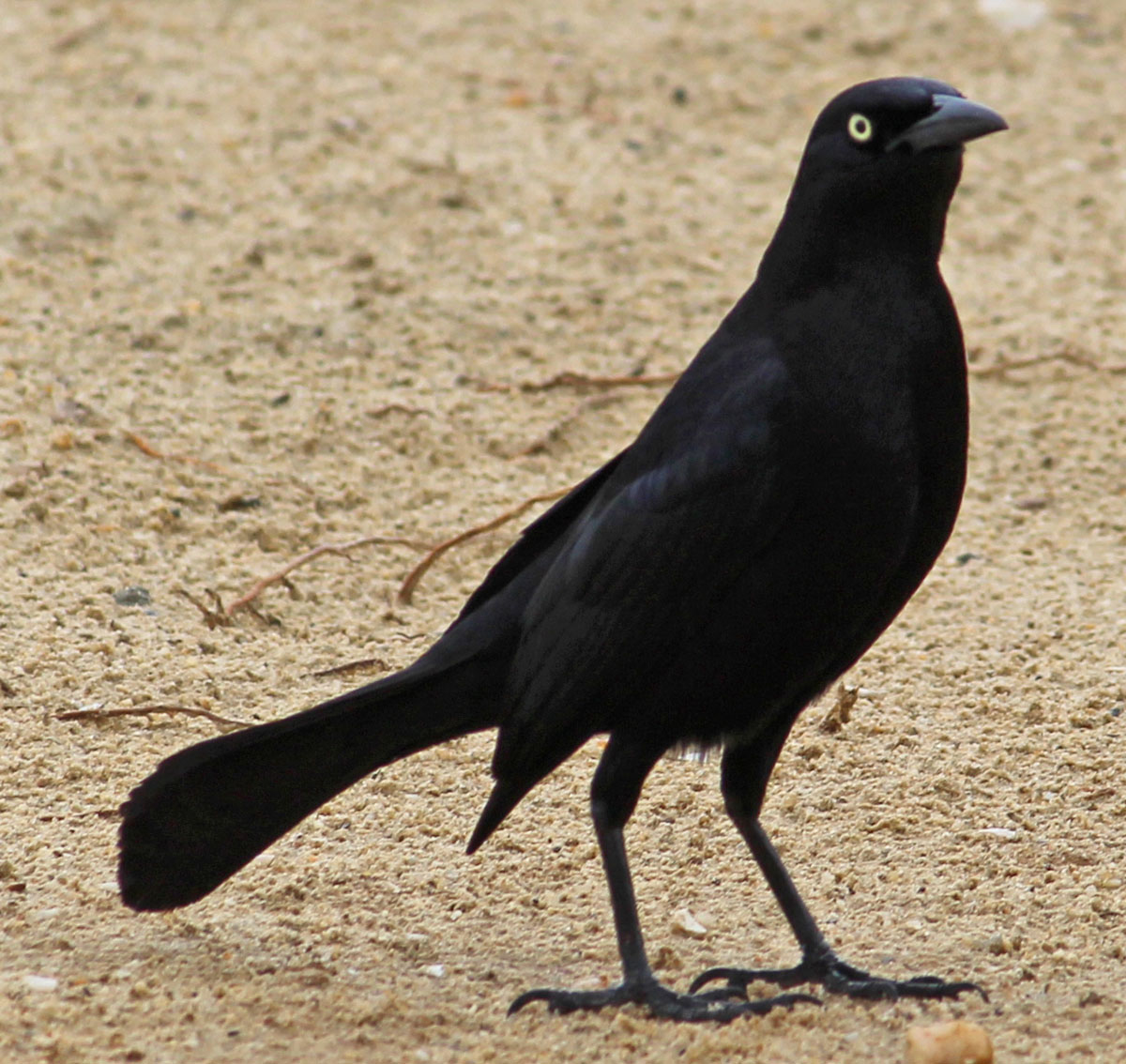 |
 |
| Gray-breasted Martin | Carib Grackle | Masked Yellowthroat |
We then birded Nariva Swamp along Manzanilla Mayano Road; with the Atlantic on our left, Nariva Swamp on our right. We stopped at various pull offs. A Savanna Hawk posed for pictures ocean side and both Crested Caracara and Yellow-headed Caracara were found in the Palm Trees as well as a Gray-lined Hawk.
 |
 |
| Savanna Hawk | Savanna Hawk |
At another spot Dave called in a female Black-crested Antshrike. We found more Bicolored Conebills and a Plain-brown Woodcreeper in the same spot.
 |
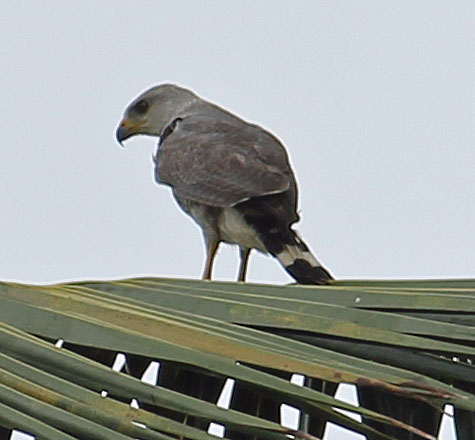 |
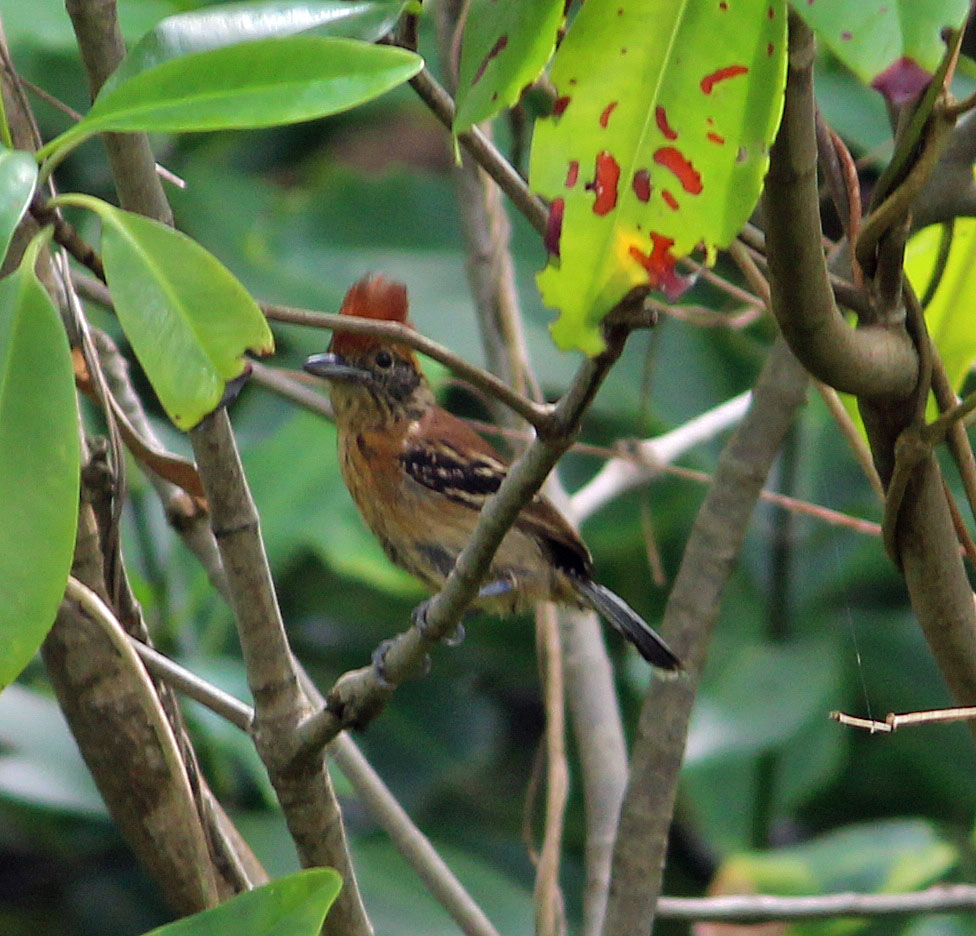 |
| Northern Crested Caracara | Gray-lined Hawk | Black-crested Antshrike |
At the mouth of the Nariva River we had looks at a Cocoi Heron and a couple of Striated Herons. A Little Cuckoo called across the street but would not show itself.
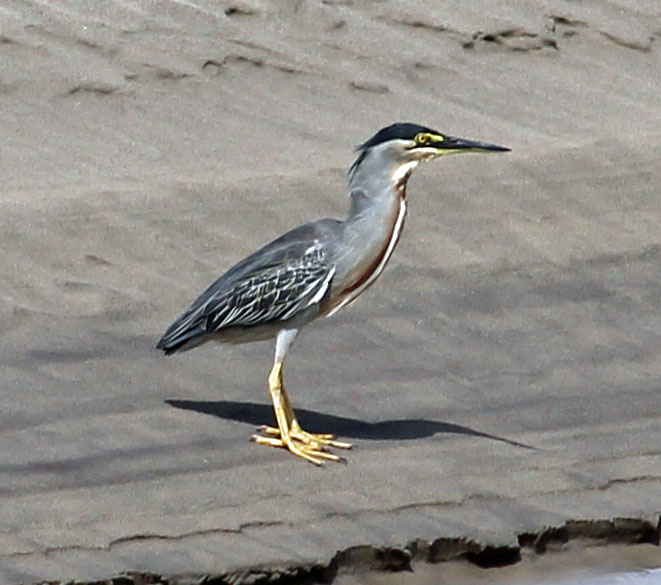 |
 |
| Striated Heron | Cocoi Heron |
We turned inland to the settlement of Kernaham. These dirt roads ran through a mixture of swamp and watermelon fields. We picked up Pale-breasted Spinetail, Yellow-bellied Elaenia, and more Smooth-billed Anis. Some got to see a Gray Kingbird but Kelli and I missed it.
We parked when the road became too sandy. The sun was now out and it was hot! We had to walk the rest of this open road to get into the Bush Bush Forest reserve. Along the way we had a family of Yellow-headed Caracaras calling in a tree.
As we approached the forest we heard what I thought was wind howling through the trees, As we got closer to the forest edge it sounded as if a group of ghosts got hold of a blow horn. Kelli thought it was a lady screaming and asked David, he said it was the Red Howler Monkeys. We had to walk a bit in the forest to find them. Their loud voices carry pretty far. They are reported to be the loudest animal in the New World and their howls can travel up to three miles. We found a few overhead and I got some video of one climbing high through the trees.
We continued on hoping to find some Capuchin Monkeys but had no luck. I did find one lone Red Howler Monkey hiding in the canopy. We found a pair of Plumbeous Kites perched in a tree and a few White-bearded Manakins. A huge three inch Click-beetle was a highlight for me.
 |
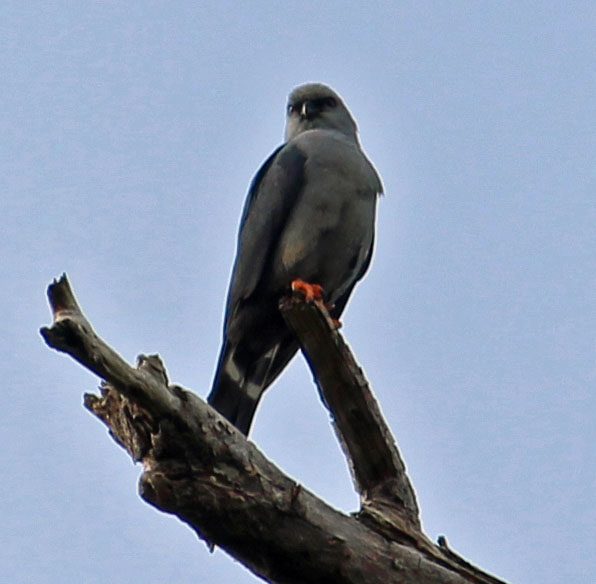 |
| Ckick Beetle | Plumbeous Kite |
We made the long walk out. I dragged behind due to the heat. Kelli and I missed a Swallow-tailed Kite, and a pair of macaws flying overhead at the forest edge that the others saw, but we found a Lineated Woodpecker and a Pale-vented Pigeon by continuing to lag behind.
Back at the van it was time for some rum punch. This is the way to bird! Two Giant Cowbirds landed briefly down the road.
On the drive out we stopped and found two Yellow-crowned Parrots and a very distant Blue-and-yellow Macaw hiding in a hollow of a dead tree. I asked Dave to stop so we could get a good picture of a couple of Smooth-billed Anis.
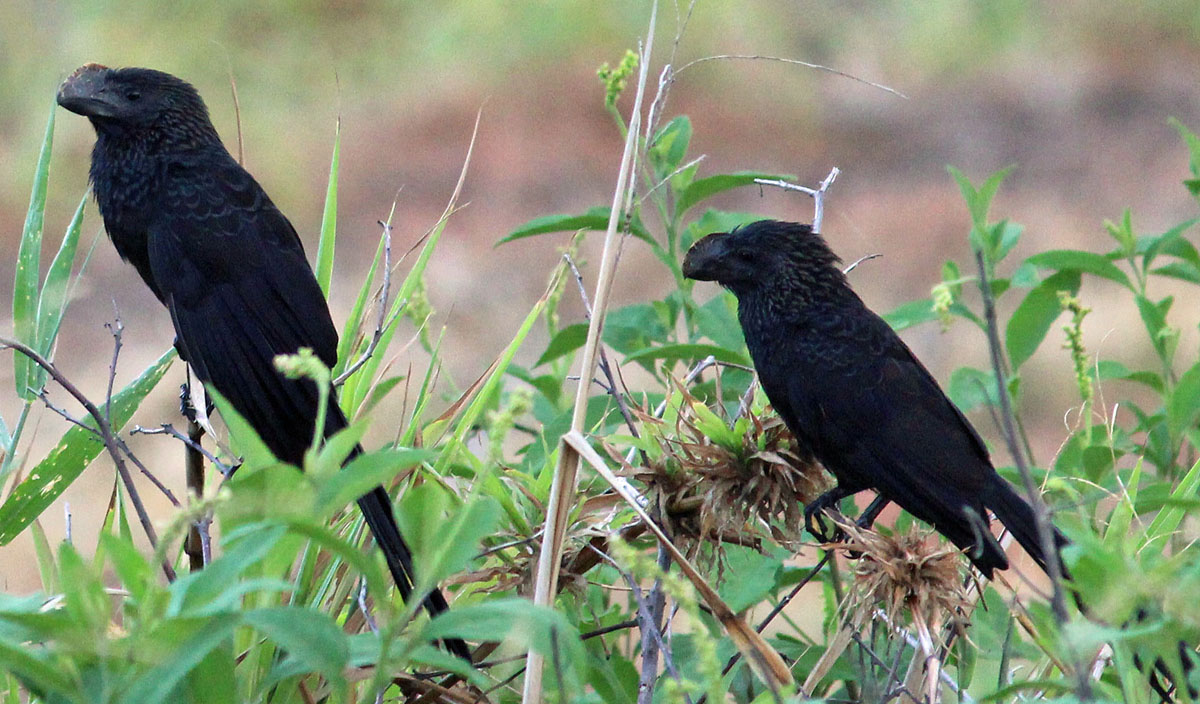 |
 |
| Smooth-billed Ani | Blue and Yellow Macaw |
It was a long drive back to Asa Wright. The British birders as well as Tiffany had left to continue their journeys elsewhere. Our group were the only ones left and we had the dining room all to ourselves. Tonight’s dinner was Callaloo Soup, Gingered BBQ Lamb Leg, Mexican Rice, Sautéed Spinach and Carrots, Scalloped Corn, and Crème Caramel for dessert. I tried a Carib Beer.
Thursday, April 28
We are leaving Asa Wright today. Kelli and I heard a Ferruginous Pygmy Owl outside our room in the morning. On our way down we added a pair of Golden-olive Woodpeckers.
Before breakfast the staff found distant Squirrel Cuckoo, Scaled Pigeon, Turquoise Tanager, Bay-headed Tanager, and Red-legged Honeycreeper in the spotting scopes. Saul photographed a hawk overhead that was later identified by Dave as a White Hawk.
We loaded up the van and car with all of our luggage and left earlier than planned for the long drive to Grande Riviere and Mt. Plaisir Estate Hotel on the north shore of Trinidad on the Caribbean. We had hoped to stop at Simla, the William Beebe Research Station nearby but we did not. According to our itinerary we were also supposed to bird along the way and stop at the Toco Lighthouse. We did not. It seemed that Dave just wanted to get the drive over with. It was a 3 hour drive and he was returning the same day.
 |
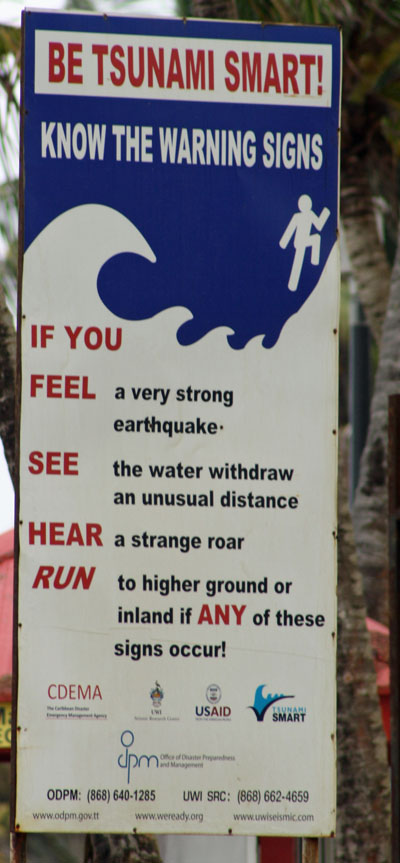 |
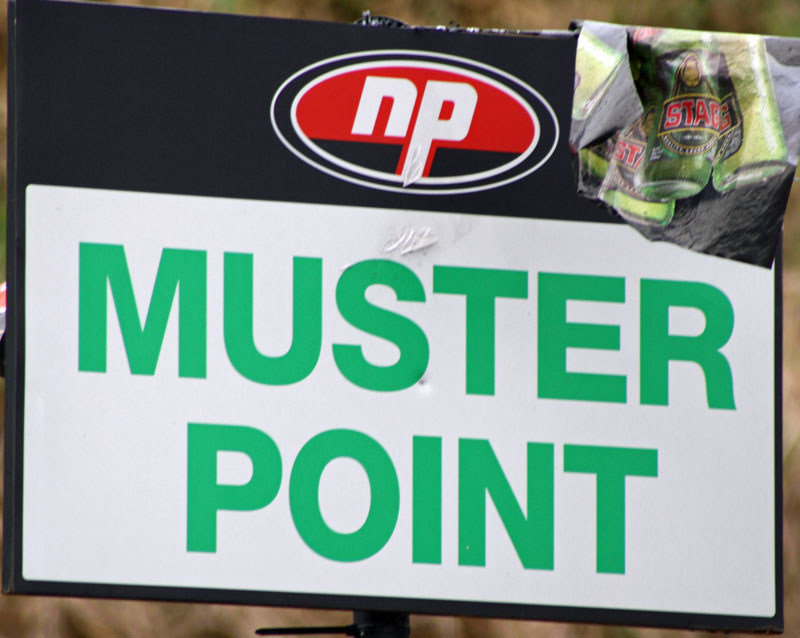 |
 |
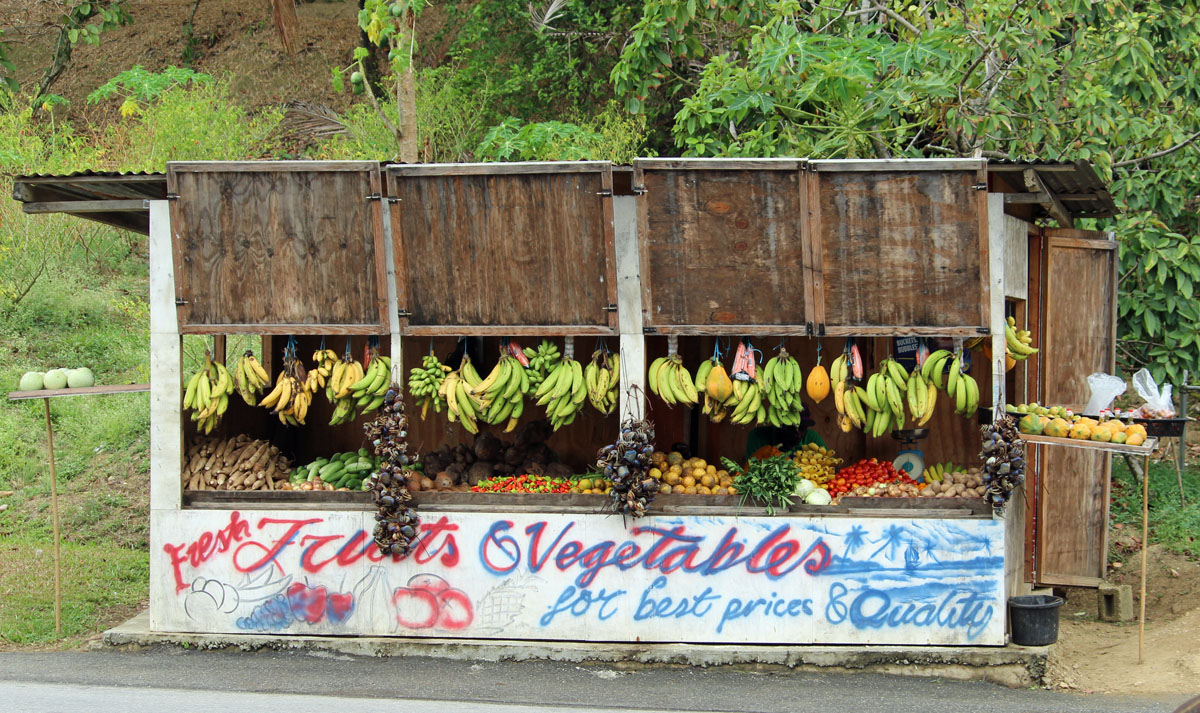 |


We did stop for a moment for Kelli and I to see a Swallow-tailed Kite soaring over the van. We had a bathroom break at Nature Seekers in Matura. Nature Seekers is a community-based organization founded in 1990 with the aim of protecting nesting leatherback turtles in Trinidad and Tobago. We saw some baby Leatherback Turtles only 4 inches long. They had some items for sale to support their efforts and Kelli bought a nice recycled glass bead bracelet made in Trinidad. Once we hit the coast the road was bumpy but we made it before lunch.
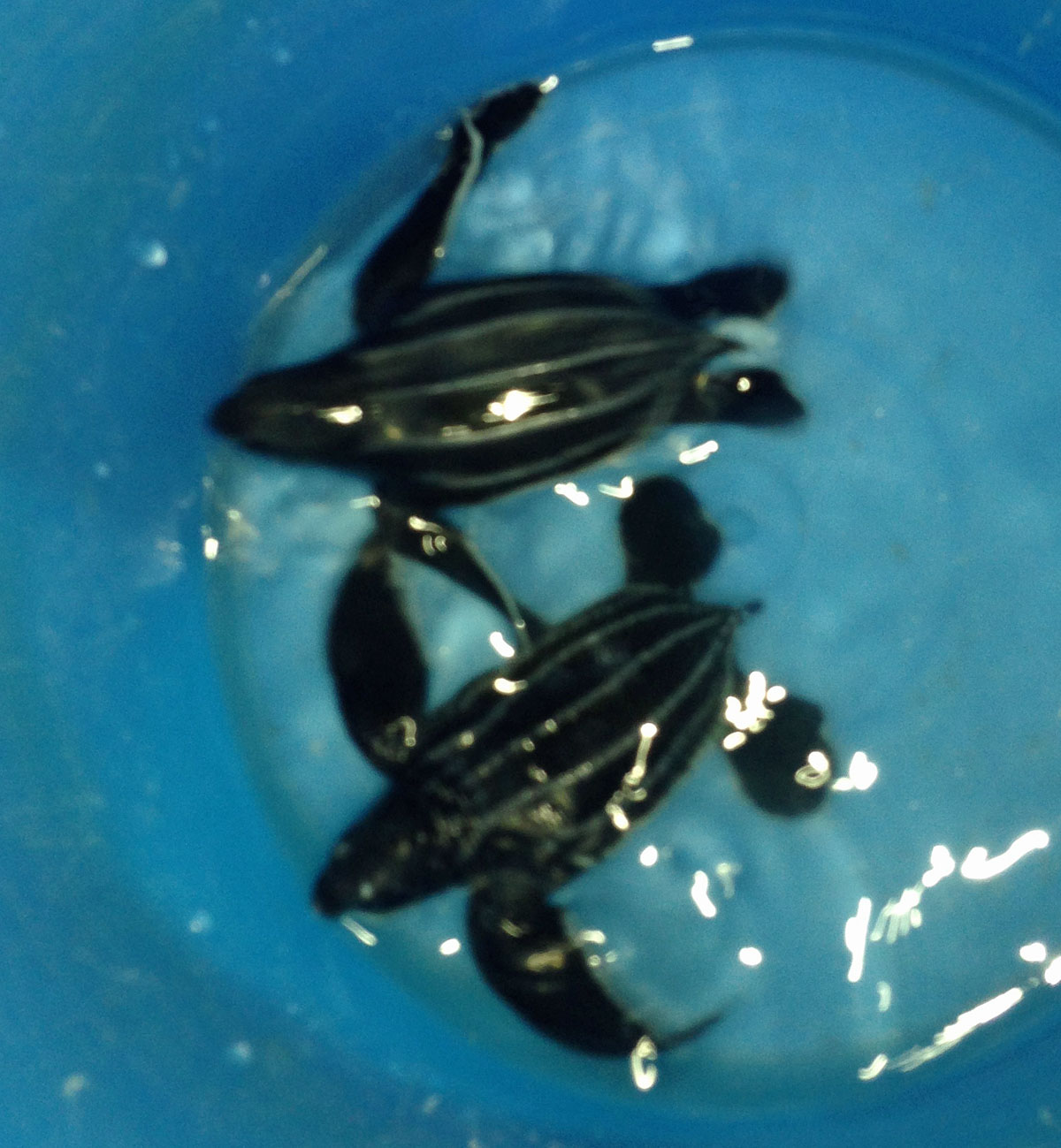
baby Leatherback Turtles
Mt. Plaisir Estate Hotel sits right on the beach with the mouth of the Grande Riviere nearby. The view was wonderful. But that’s when wonderful ended. It seemed there were only five of the needed six rooms our group needed. Mt. Plaisir Estate Hotel and Caligo Ventures blamed each other but we all suspect the hotel since it was hosting a pre-wedding celebration tonight for 50 guests. Fran and Ruth had to double-up for one night. (Caligo did apologize and refunded part of the single supplement to them).
Our rooms were on the second floor with large balconies with Adirondack chairs looking out into the Caribbean. There were two single beds and a king; all had mosquito netting which greatly concern us. It was not to worry. We had almost no problem with bugs on our entire trip and the netting was not needed at this time of year. The rooms had air conditioners but oddly had only one small bar of soap for both the sink and shower and no other amenities such as shampoo (we should have grabbed extras from Asa Wright).
 |
 |
We met downstairs at the restaurant after settling in. The hotel did let us order off the menu for lunch and I will say the restaurant here has excellent food; but eventually we found out very lousy service. A few Carib Grackles came in while we were eating looking for an easy meal.
We met our guide Nicholas and found out we will be heading out early the next two mornings before 6 AM. The hotel promised us coffee, tea, fruit and toast at 5:30 AM. He will only be guiding us in the morning before breakfast, after that we were on our own; and there would be no bird walk today. It was hot and humid so I did not mind. Kelli, Ruth and I took a walk to the mouth of the river. Brown Pelicans and Magnificent Frigatebirds soared over the water and lots of Black Vultures patrolled the beach. The only additional bird in the river were some White-winged Swallows.
Our plan was to relax on our balconies till dinner. A Spotted Sandpiper was spotted on the beach. We were told that a nearby Turtle Village Trust- Head Start Programme will be feeding their turtles at 3 PM. Some of us wandered over. I spotted a pair of White-tipped Doves but they flew off before anyone else could see them. No one showed by 3:40 PM so we went back to relax on our balconies. It was nice to finally relax but I did get bored so I worked on downloading pictures from the cameras to the computer for a while.
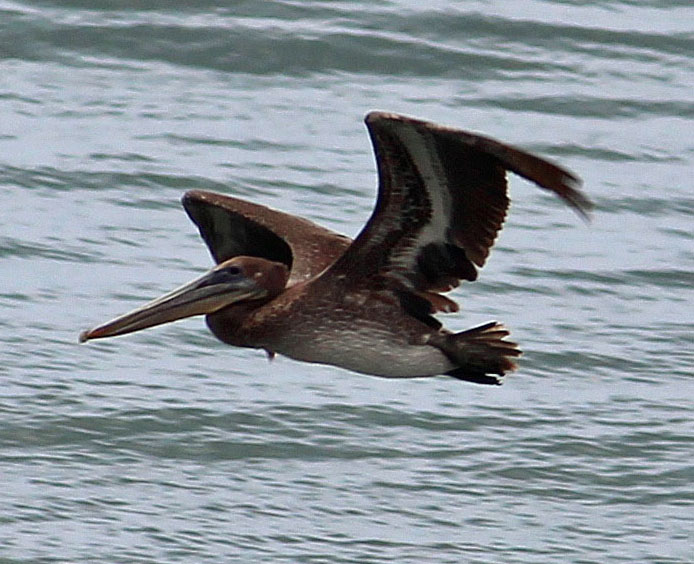 |
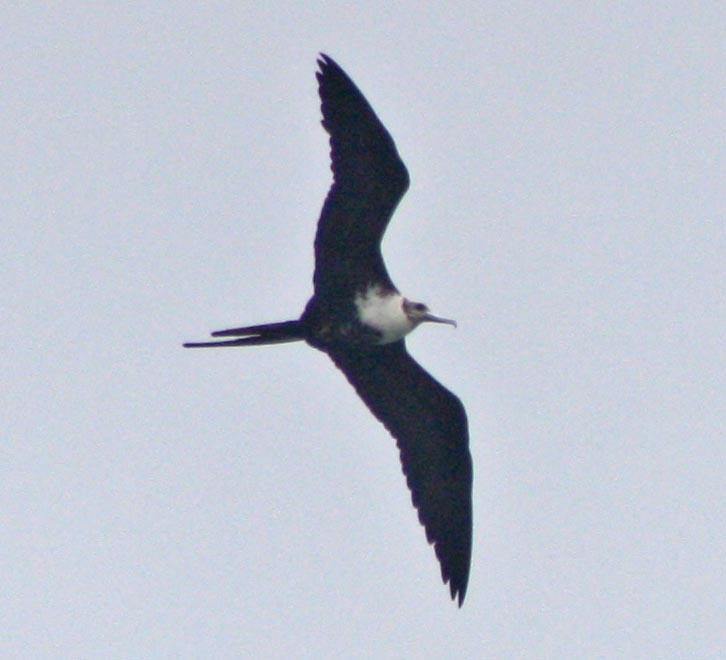 |
| Brown Pelican | Magnificent Frigatebird |
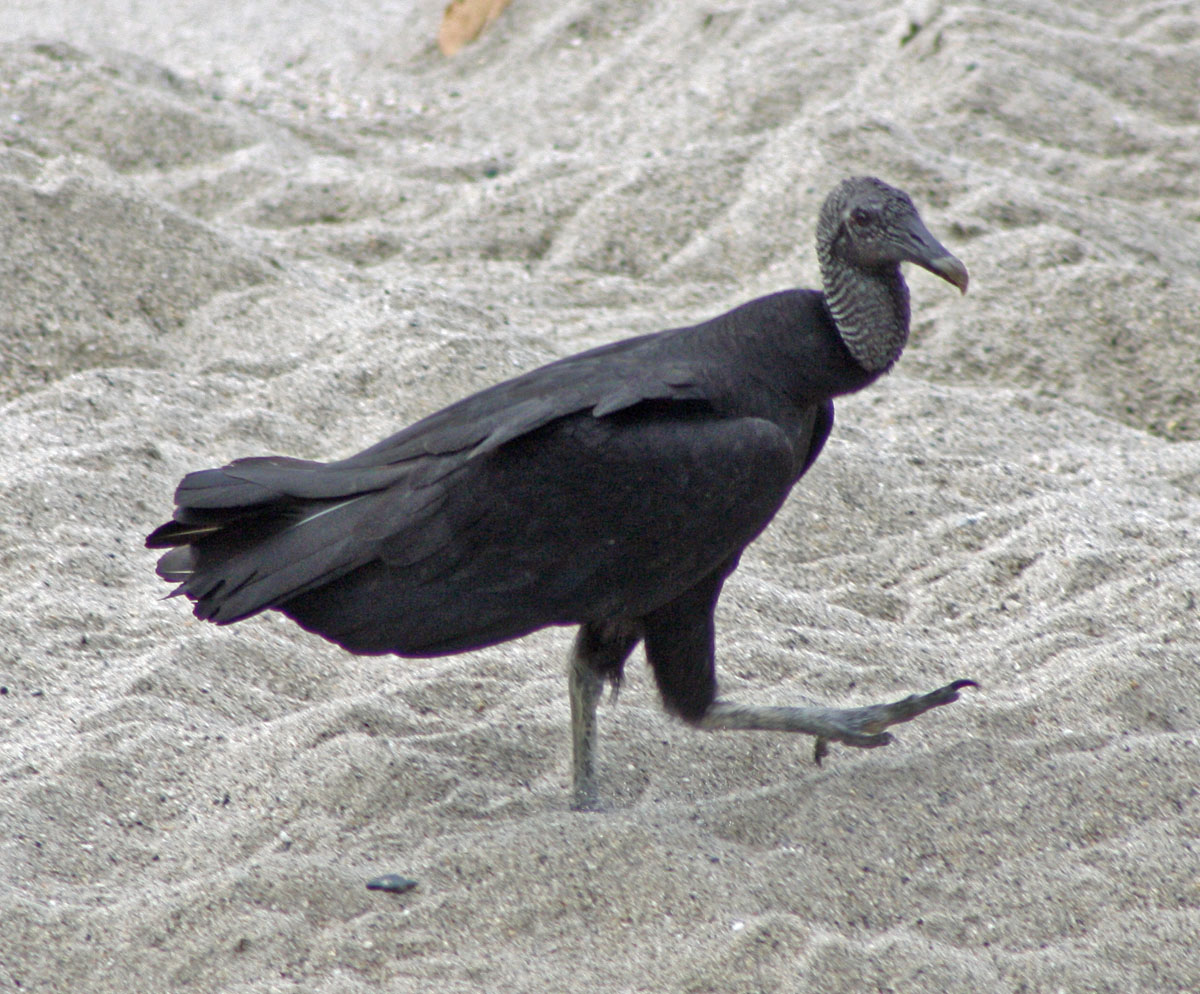 |
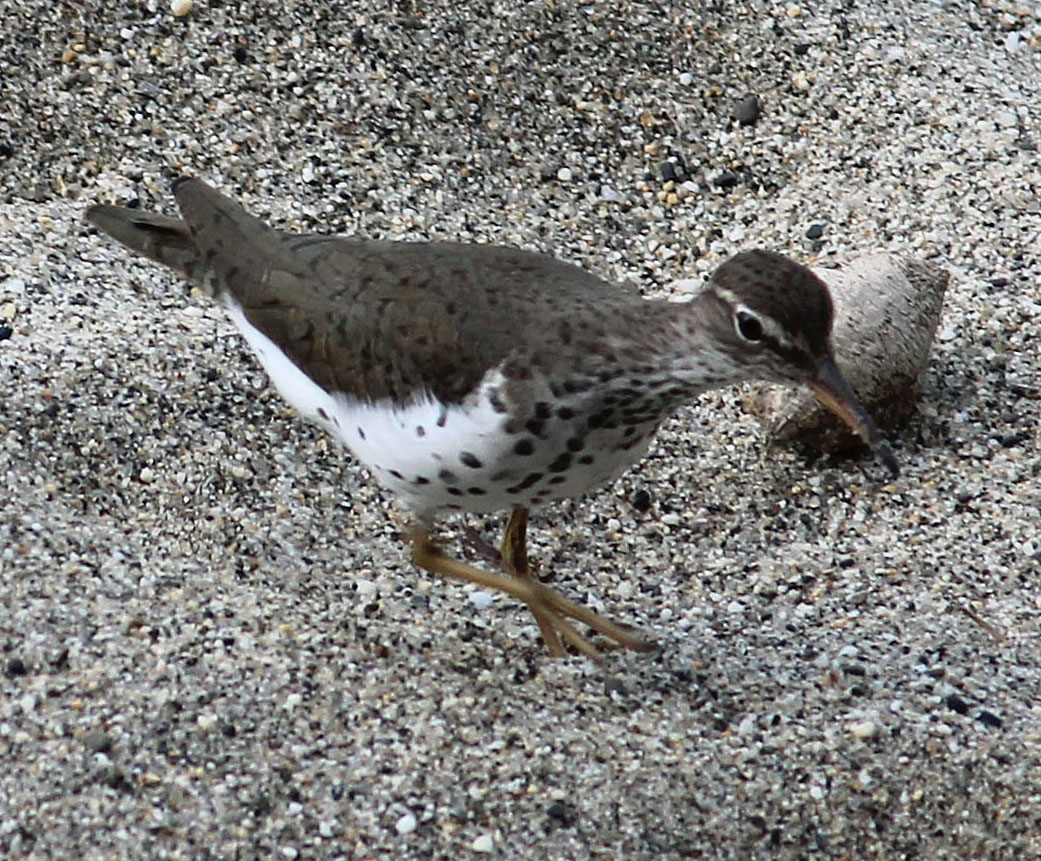 |
| Black Vulture | Spotted Sandpiper |
As night fell two Leatherback Turtles came ashore to start laying eggs. We ran out to get a look before dinner. They were massive. Flashlights and flash photography are forbidden, so our pictures were not that great. The light disturbs and confuses the turtles at this critical time. They say a few may still be on the beach at first light and you can get better pictures then. We left the turtles alone so we could walk over to dinner.
We shared the restaurant and a buffet with the 50 or so pre-wedding partiers. The food was good and I got to try some curried goat. We needed to get up very early so we hit the sack soon after the late dinner.
Friday, April 29
We were up and out a little after 5:00. Three turtles were still on the beach and as dawn approached there was enough light for some video and photography.

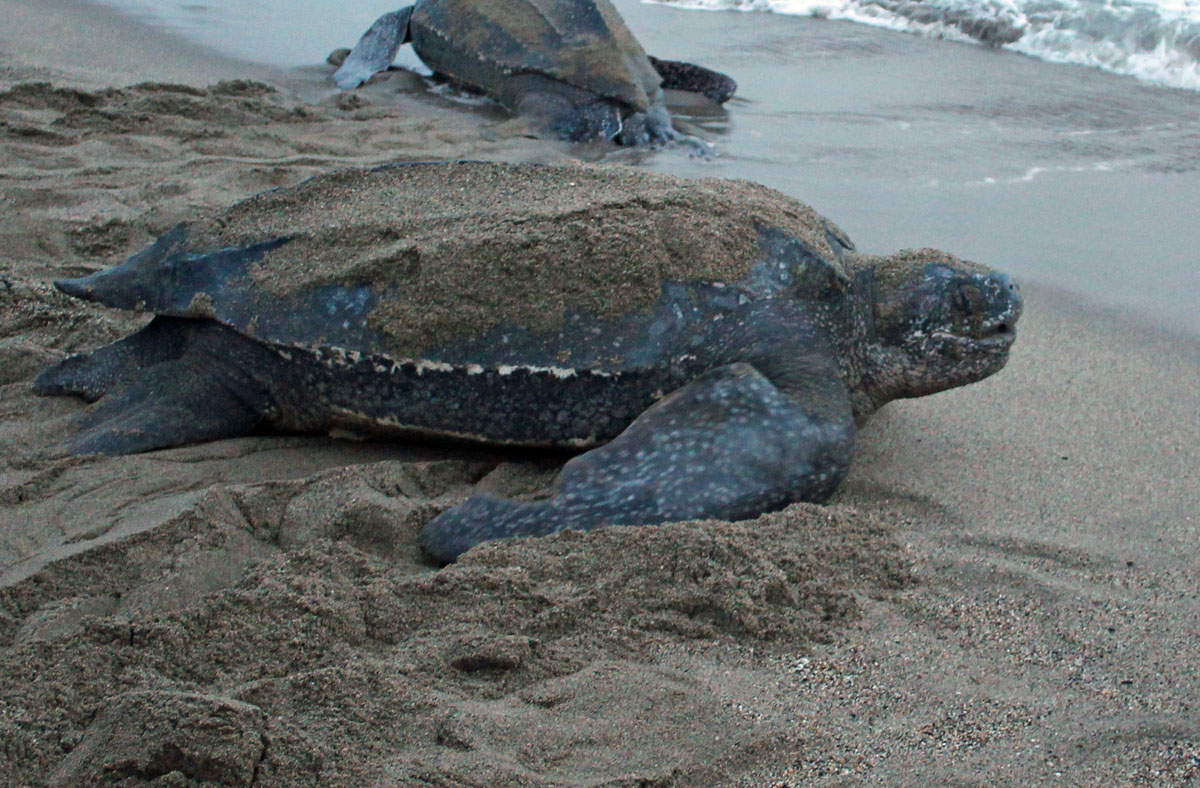
Video:
Back at the hotel we had our coffee, tea and toast. Since our guide’s car was in the shop as his wife ran it off the road the day before; we had to shuttle up to the site 3 at a time.
The site was nearby, uphill and a gated compound with a large raised covered deck overlooking fruit trees and a valley. It was a great location to bird from one spot and be protected from inclement weather.
It did not take long before the first Trinidad Piping Guans to appear. Everyone had great looks.
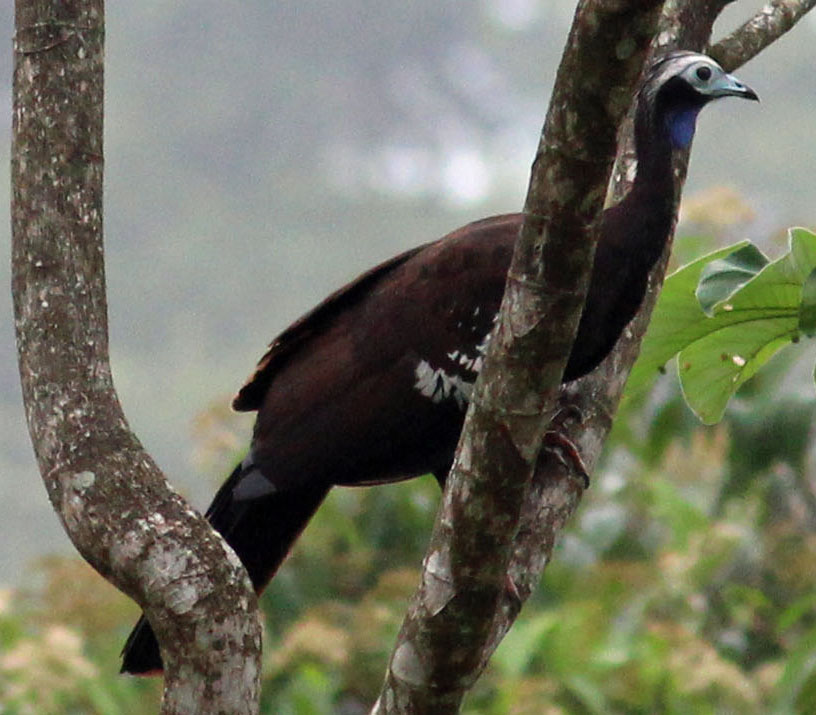
Trinidad Piping Guan
Soon other familiar birds were seen such as Bananaquits and the common tanagers seen at Asa Wright. We had a Blue-black Grassquit and found out its nick-name was Johnny Jump-up. The bird would leap straight up into the air about two feet to catch insects flying overhead and fall back down.
We had both Piratic and Streaked Flycatchers and were able to compare these very similar species. A Gray-headed Kite briefly appeared soaring in circles overhead. Other birds seen included: Turquoise Tanager, Black-throated Mango, Red-legged Honeycreeper, Guianan Trogon, Channel-billed Toucan, and Black-tailed Tityra
Heavy Rain then fell but we were well protected on the covered deck. The rain brought out insects along with Short-tailed Swifts and the much larger White-collared Swifts to eat them.
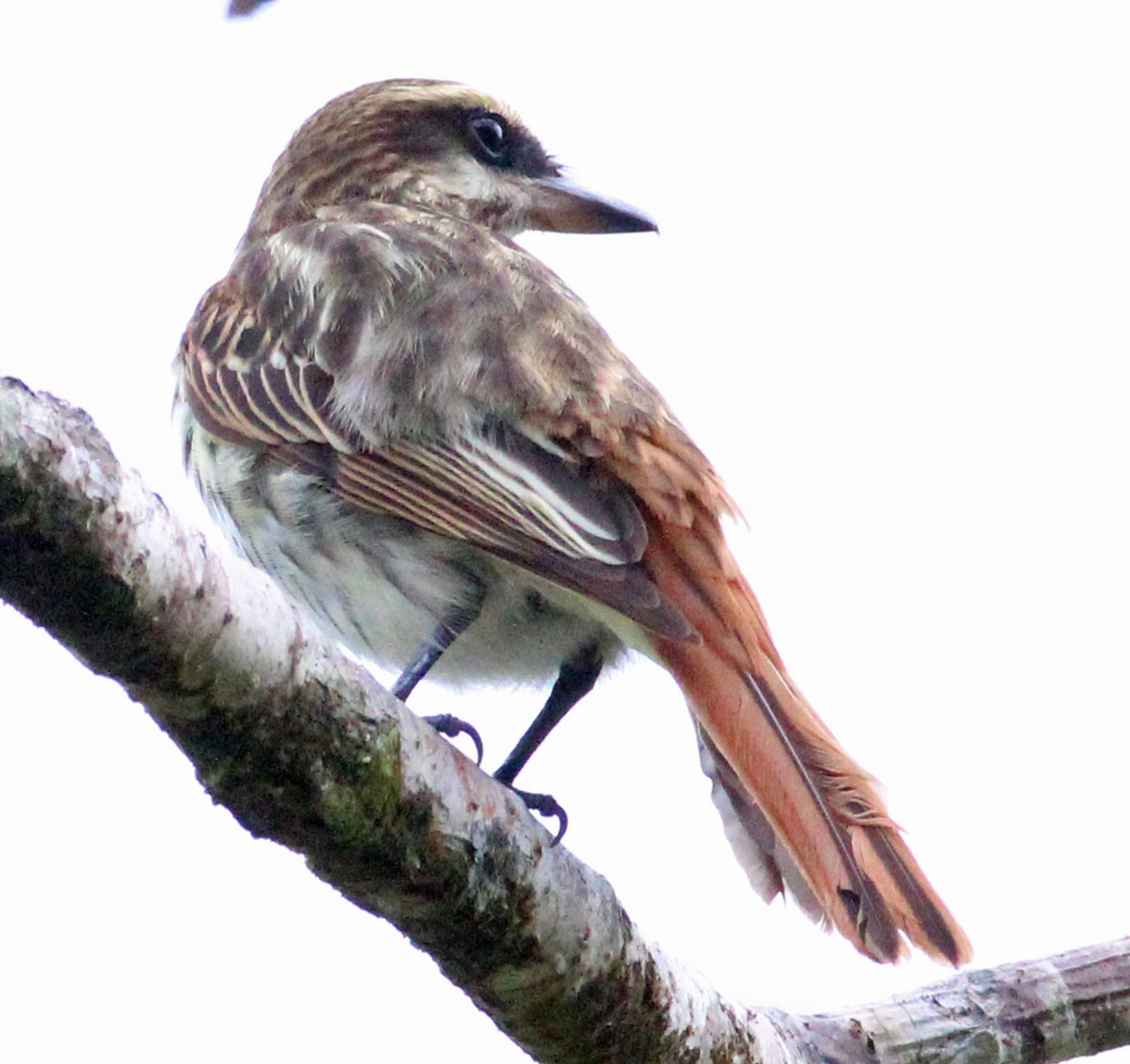 |
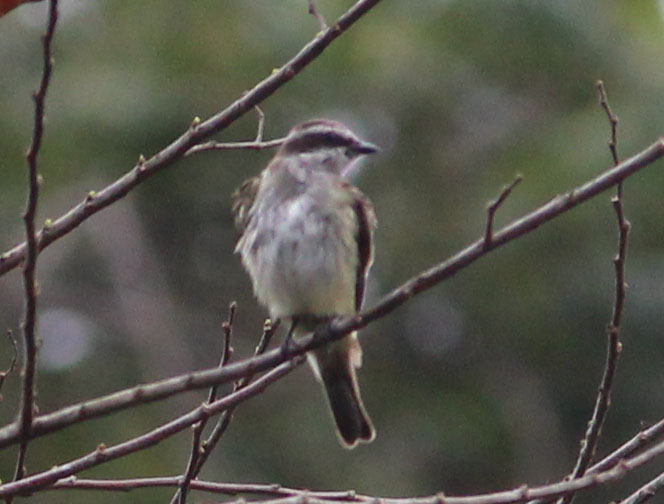 |
| Streaked Flycatcher | Piratic Flycatcher |
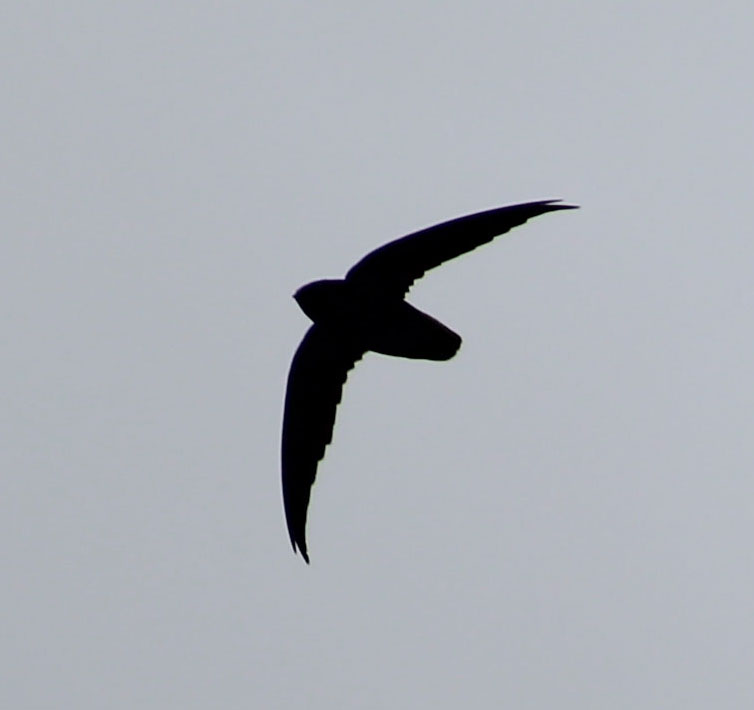 |
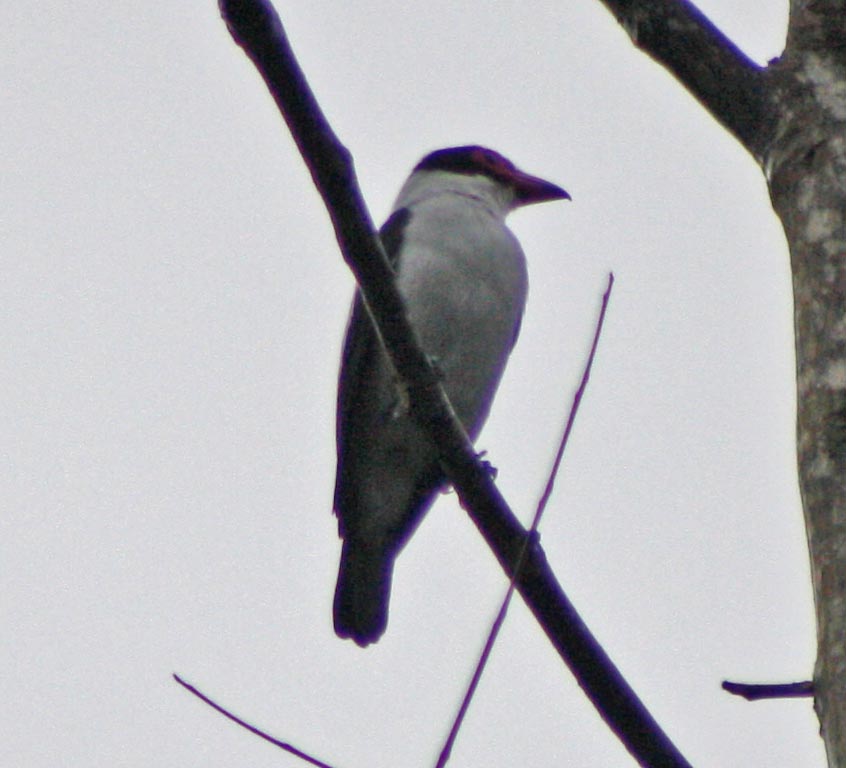 |
| Short-tailed Swift | Black-tailed Tityra |
Around 8:30 we started the process to get everyone back. We had breakfast at the hotel. The service was slow but the food good. Kelli loved her Veggie Choka. We kind of over ordered bread so we had plenty of that. I could not relax all day so I offered a bird walk for everyone after breakfast. We gathered and searched the hotel grounds and the nearby Grande Rivière Nature Tour Guide Association property. I wanted to get a better look at the doves I saw yesterday. Surprisingly, my “spishing”, along with a Ferruginous Pygmy Owl playback brought birds in. We had great looks at both Grayish Saltator and Golden-fronted Greenlets.
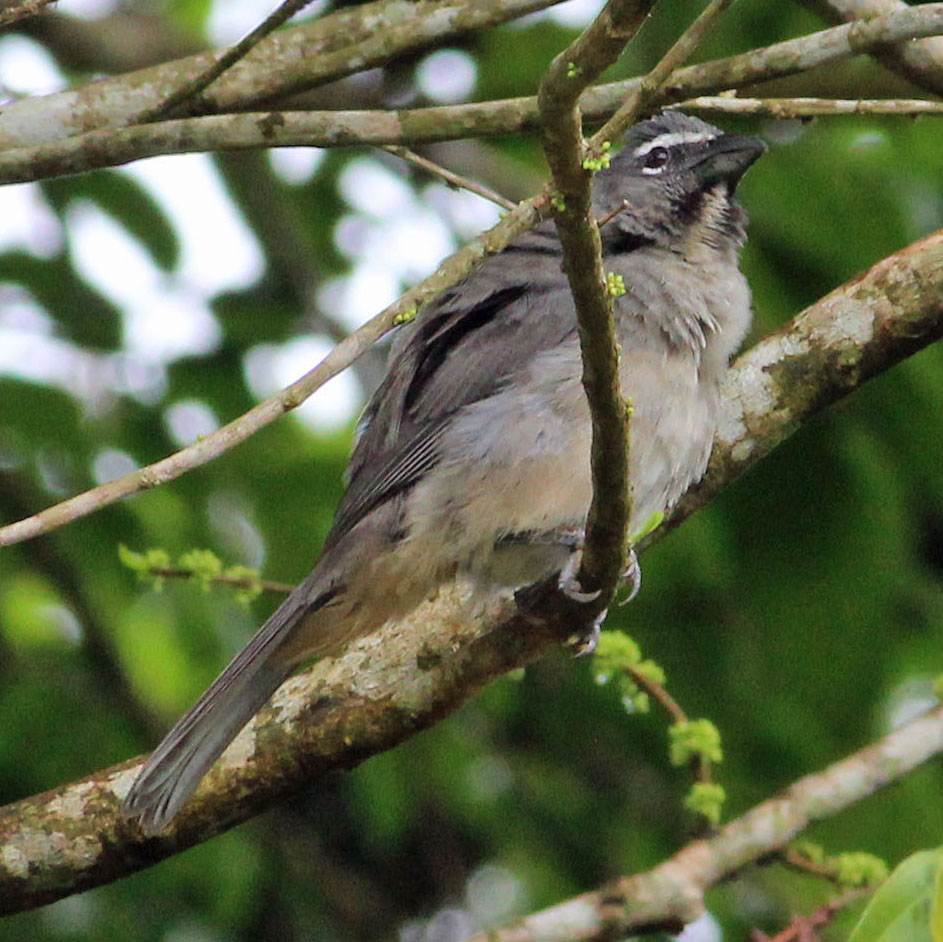 |
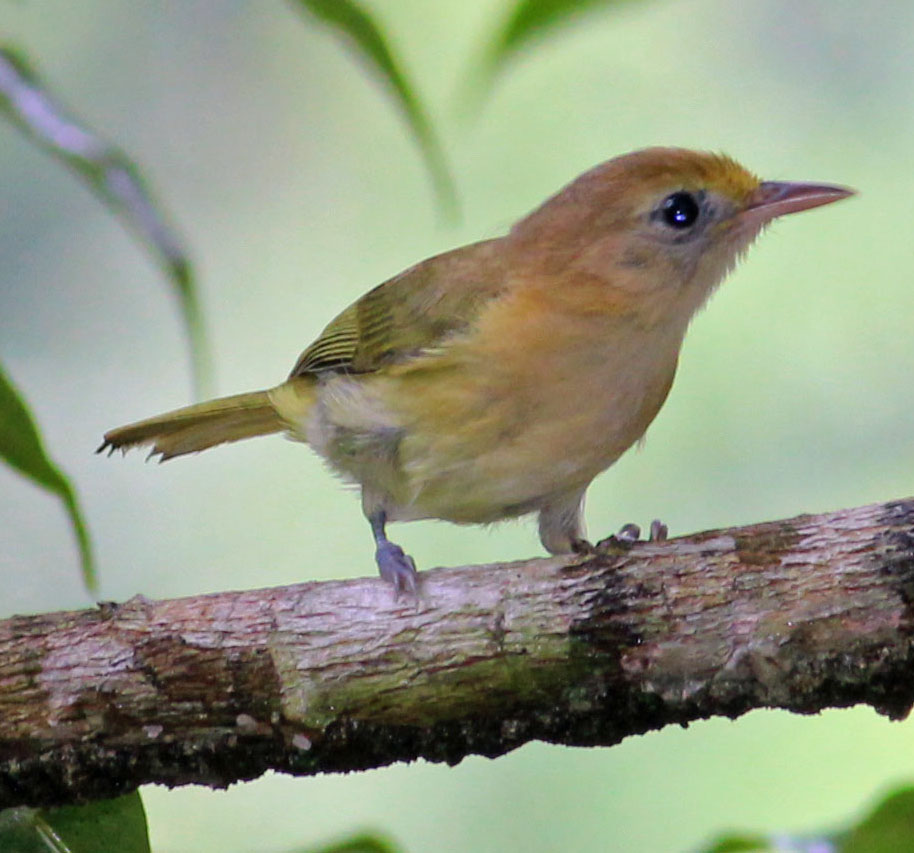 |
| Grayish Saltator | Golden-fronted Greenlet |
We eventually found a White-tipped Dove in a neighbor’s backyard. She came out to investigate and we tried to explain we were looking at a dove. Some communication difficulties made her thought we had lost a dog and was trying to get it back. More Short-tailed Swifts were flying about and I got a look at a White Peacock butterfly.

White Peacock
I tried a little swimming on the beach. The water was refreshingly cool and I was surprised by the power from the waves since this was the Caribbean. There was also a two foot drop in the sand which made it hard to get out of the water.
In the early afternoon we found out they were feeding the turtles and headed over. The Turtle Village Trust- Head Start Programme “rescue” eggs from two other species of smaller turtles; Green and Hawksbill. Their nests are usually destroyed when the larger leatherbacks dig up the beach. Once hatched they release them back into the wild but keep a couple for educational use.
 |
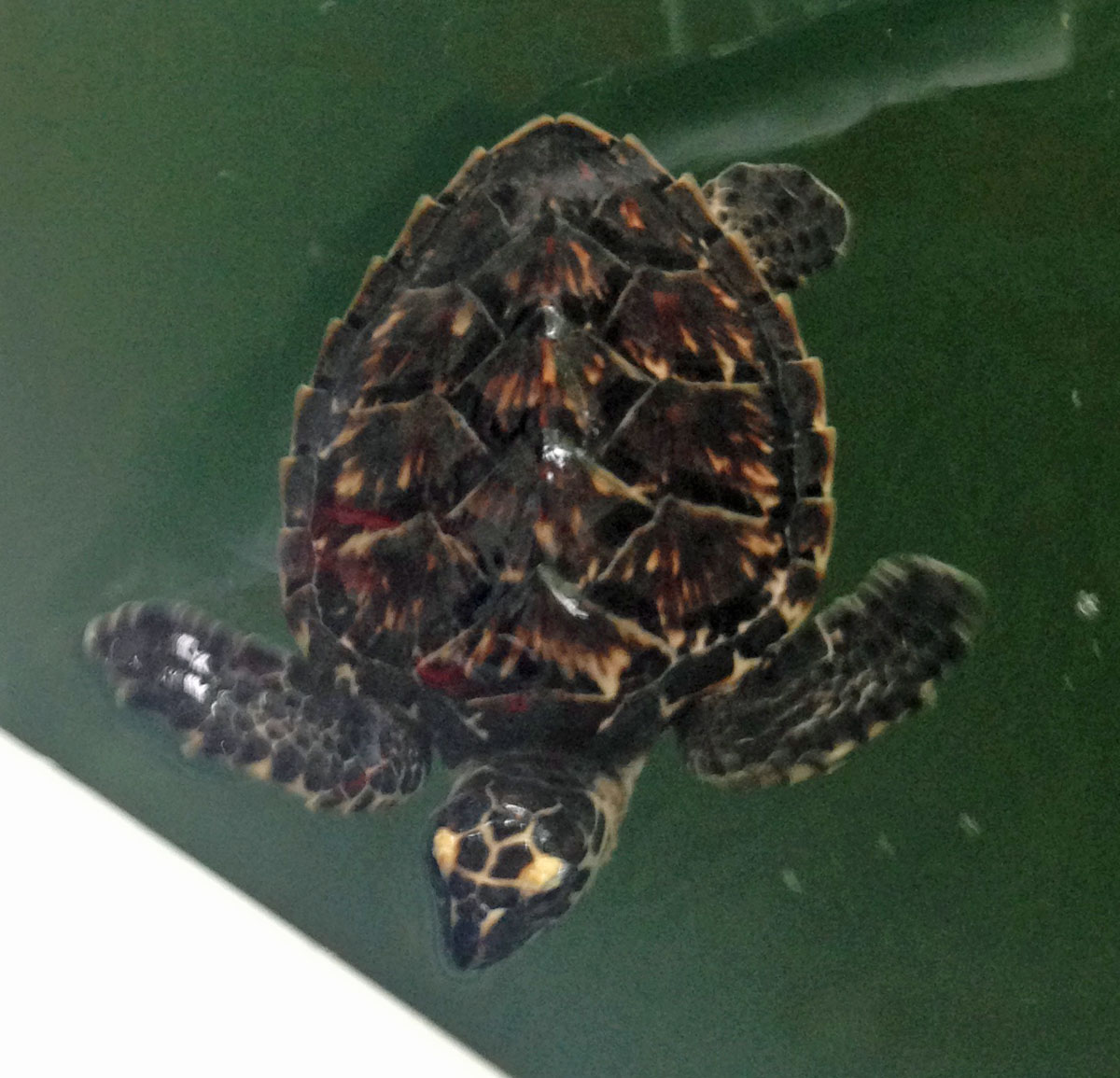 |
| Green Turtle | Hawksbill Turtle |
We got to feed some of the Turtles lettuce and hear about the conservation efforts of the group.
Later that evening we returned to purchase our turtle tour permits before dinner. Kelli and I had the Ginlic Shrimp - sautéed in ginger, garlic and butter. Dessert was coconut ice-cream.
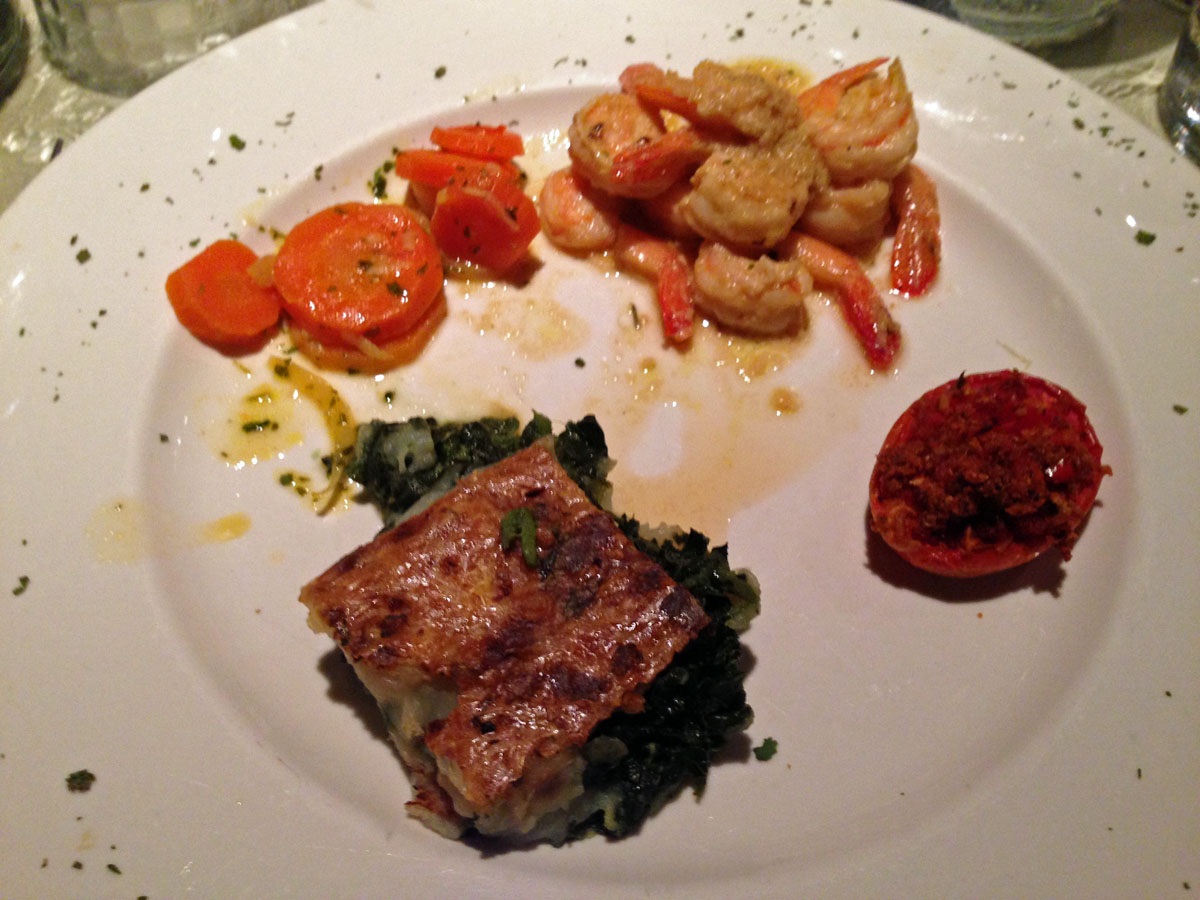
After dinner we returned to pick up our guide. He led us back to the beach and we visited two or three turtles in various stages of digging their nest hole, laying eggs, and covering it up. He explained the whole process and answered questions. It was a very informative night.
We needed to prepack tonight for our journey home tomorrow. We arranged an earlier 10 AM pickup to the airport since it is a long drive back.
Saturday, April 30
We were up and ready at 5:30 AM but our toast, coffee and fruit were no where to be seen. Nicholas showed up and called the hotel manager to get our coffee, tea and toast. I took the second car up and let Kelli take a later ride so she could get her much needed coffee. We also had two additional birders with us.
We again had many of the same birds as yesterday with more sightings of Trinidad Piping Guan. We also added two more species: Trinidad Euphonia and Brown Violetear, a hummingbird. That made twelve hummingbird species for the trip. We also heard a Rufous-breasted Wren but it would not come out into view.
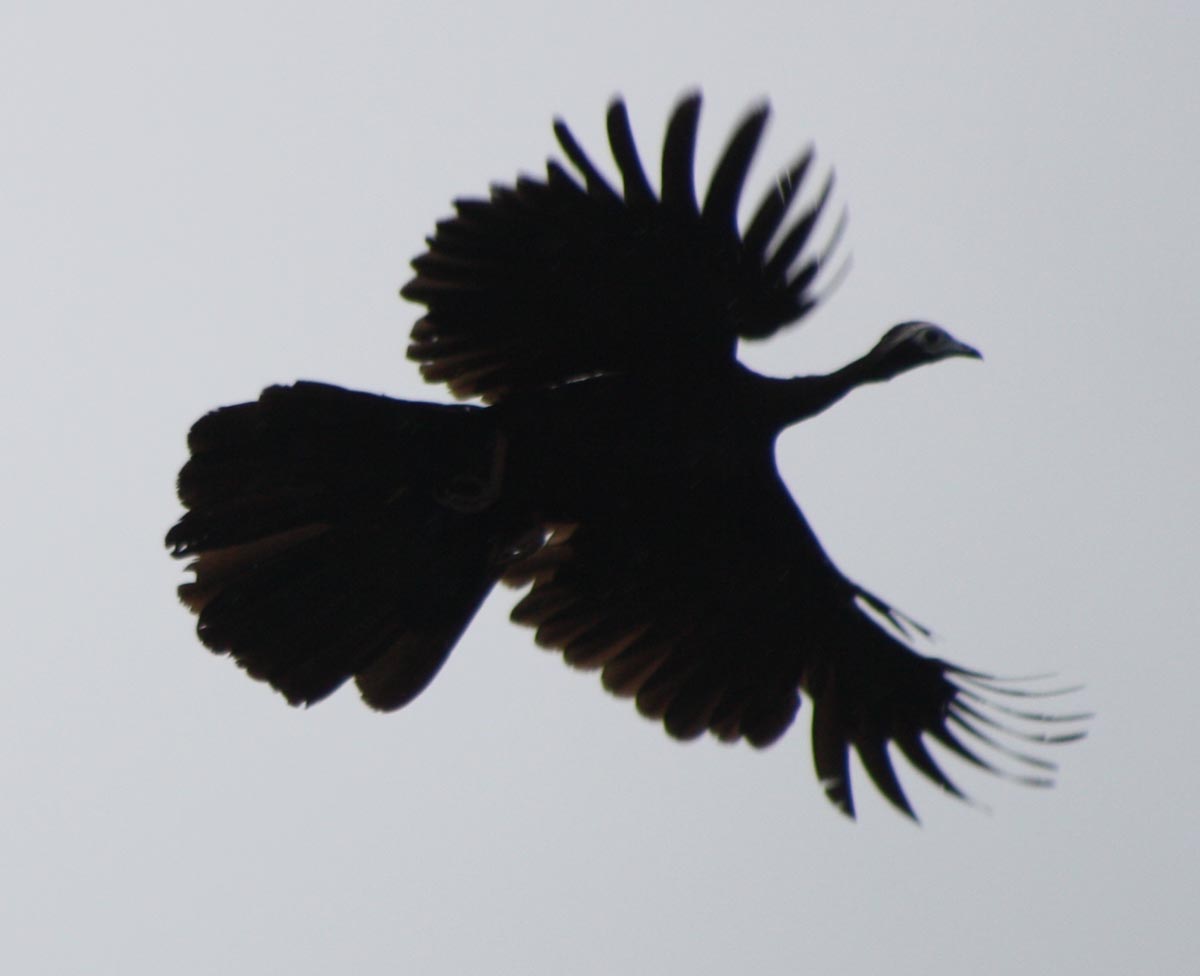 |
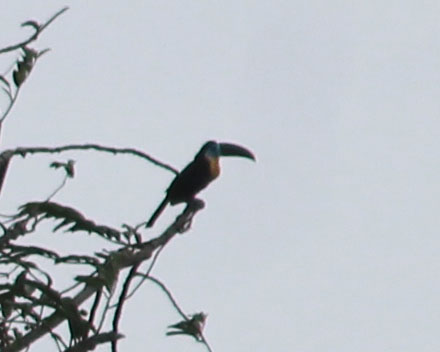 |
| Trinidad Piping Guan | Channel-billed Toucan |
Around 8:00 we started the process to get everyone back since we needed to eat and finish packing. At the hotel we had to wait and wait since they would not start breakfast till 9 AM. They said the staff was in a car accident; we knew they were just on Trini Time. They also ran out of bacon and no corn flakes. When we finally got to order the food for the nine of us, it came out very slowly with only two or three plates every five to ten minutes.
I was the last one to get my food. Everyone else left the table to pack as I finished up by breakfast. After a fast shower and final packing, Kelli and I were last to the van. On the plus side Mt. Plaisir Estate Hotel did comp all of our bar bills for all the trouble. Too bad we didn’t drink much.
The ride back was much more comfortable as the van had better suspension than the one that brought us here. It was a nearly 3 hour van ride, followed by the wait for a 4 hour flight to Miami; then another 2 hours to get through customs. We had to wait at the gate an extra 30 minutes since a plane heading from Cuba had many connections to our flight and it took time to get them through customs. It was 3 hour flight from Miami into Newark. We landed at 1 AM Sunday morning. It seemed to take forever to get our checked luggage. Then it was the bus to the parking lot and Mark driving us home. We got in the door at 3 AM, 17 hours after leaving Grande Riviere. We were glad to be back home after a wonderful and amazing trip.
Thanks for reading
Michael and Kelli
Back to Kelli and Mike's Page for more adventures.
Extra - Some bad pictures of other birds
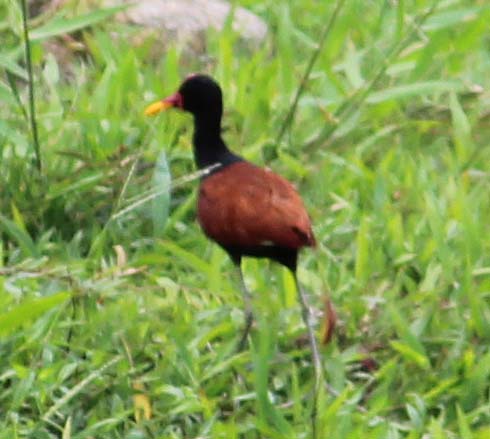 Wattled Jacana |
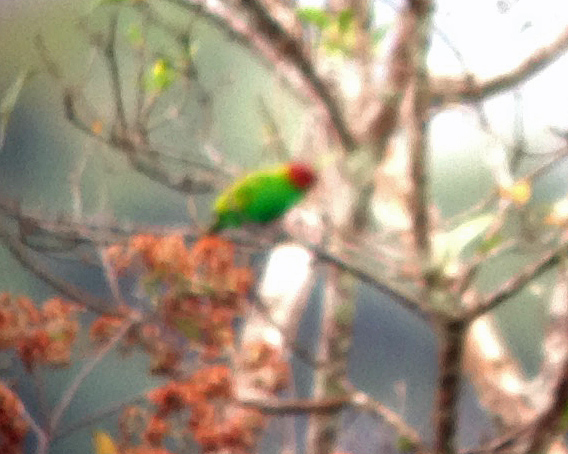 Bay-headed Tanager |
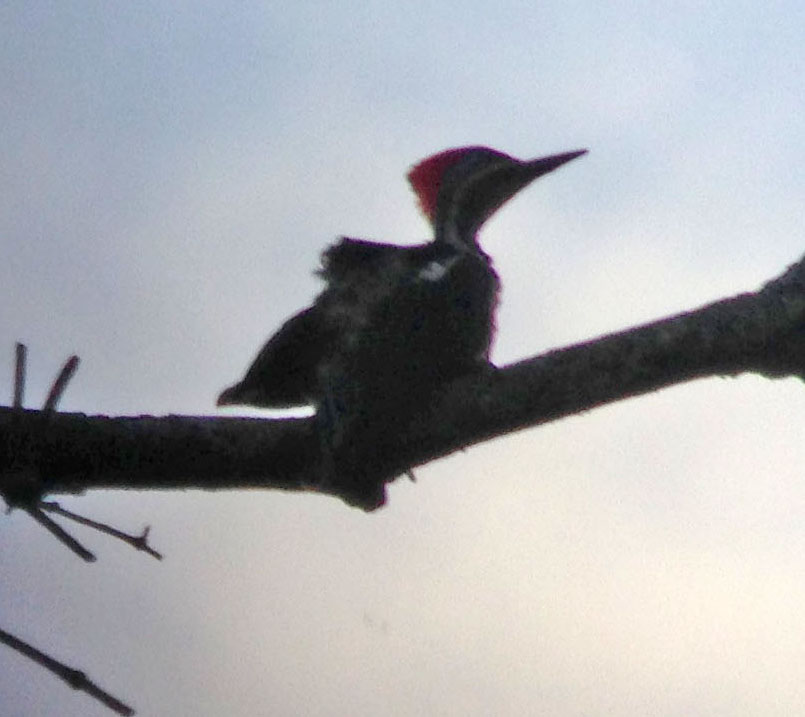 Lineated Woodpecker |
 Yellow-hooded Blackbird |
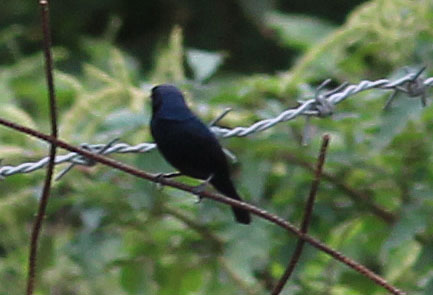 Blueblack Grassquit |
 Green-rumped Parrotlet |
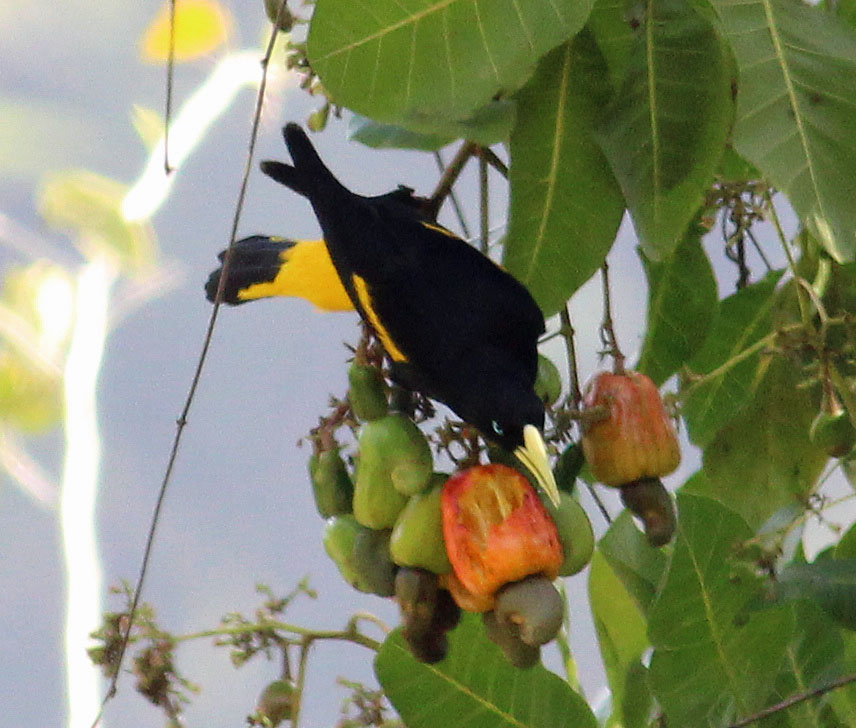 Yellow-rumped Cacique |